
18 October 2024
Visit the traditional site of “Tono Monogatari” and the reconstructed Sanriku Kamaishi area. Tono/Kamaishi TRIP: Connecting the past to the future
In Tono City, well known from the folklorist Kunio Yanagita's book “Tono Monogatari,” visitors can enjoy a mysterious journey around places related to traditions such as the Kappabuchi Pool and Oshirasama. On the second day, we will enjoy Kamaishi's local specialty gourmet food in the area around the hotel and also learn about the memories of the disaster that must never fade away and the lessons for the future.
Tono Denshoen Park
Experience the culture and beliefs of a rural village in the Tono area

In the Tono area, people and horses used to live together under one roof in a kind of house called a "magariya," in which the main house and stable were connected. The park is dotted with thatch-roofed buildings, including the “Kikuchi Family Magariya,” the first nationally designated Important Cultural Property in Tono, a crafts center, and a water wheel house, recreating the lifestyle of a rural village in the past.
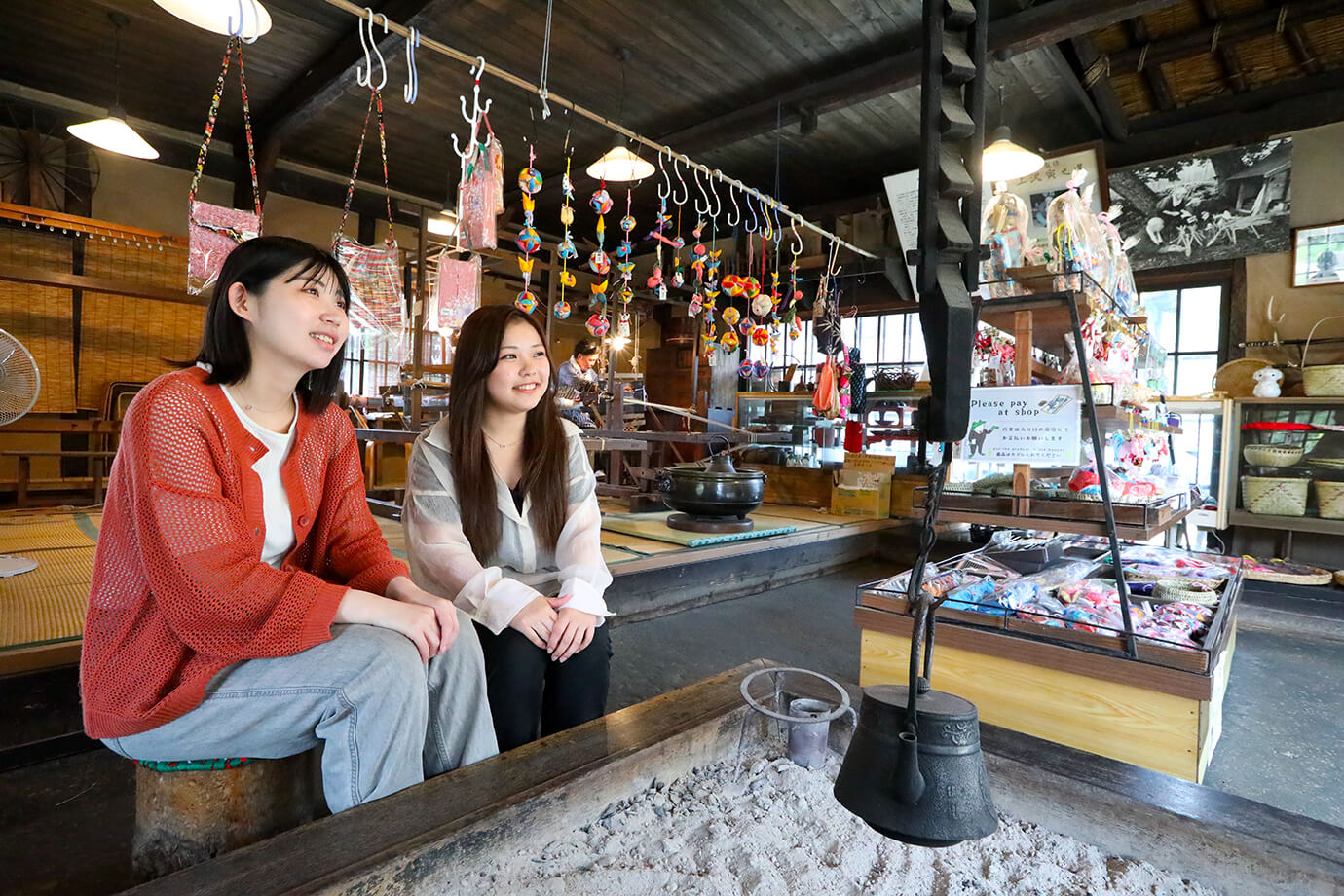
In the “crafts center,” a relocated farm barn, members of the local senior citizens' club provide information on traditions and culture.
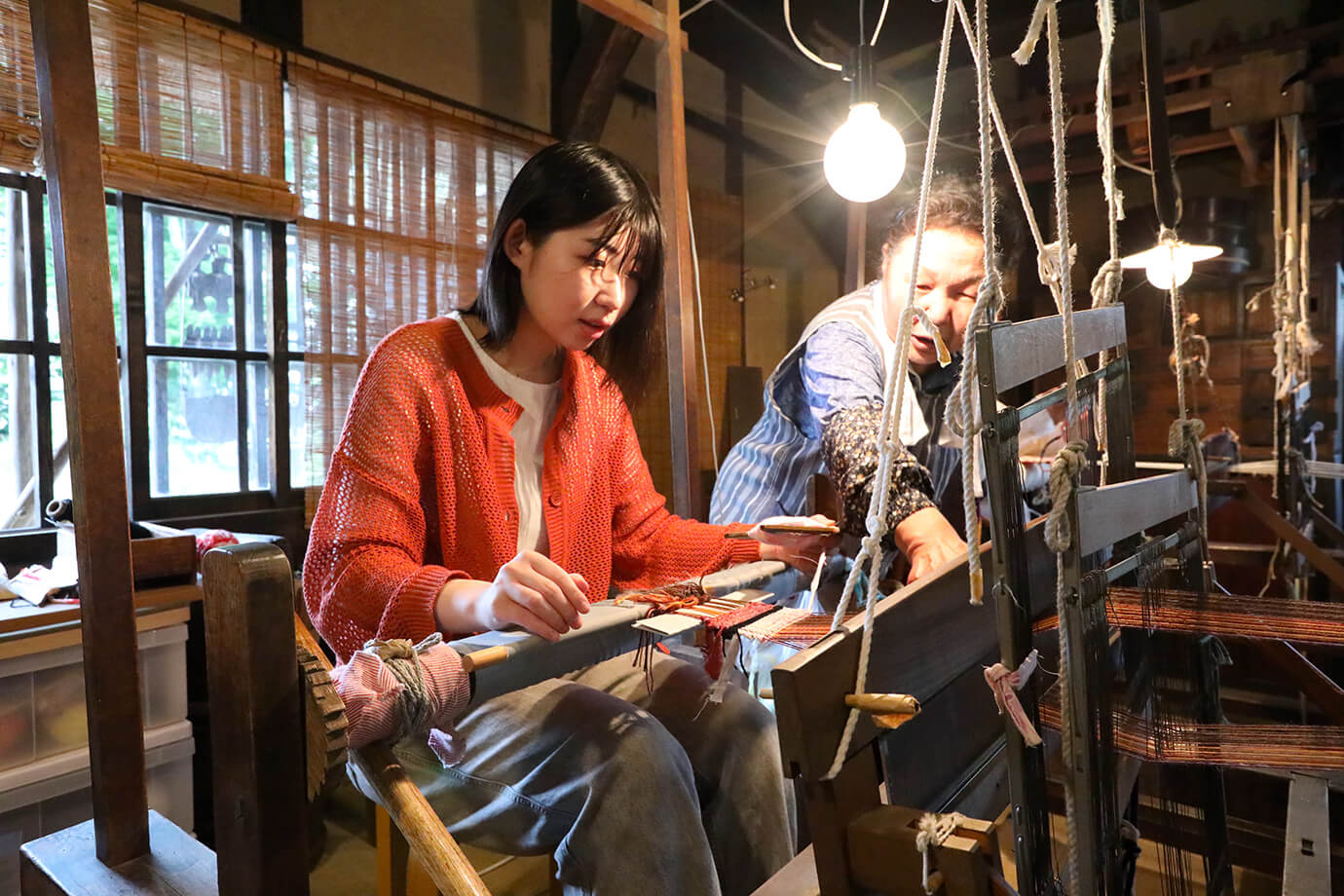
For this trip, we will experience "sakiori weaving.” “Sakiori” is a weaving technique in which kimonos and other old cloth are torn into strings and woven in crosswise threads. Local mothers will carefully teach you each step.
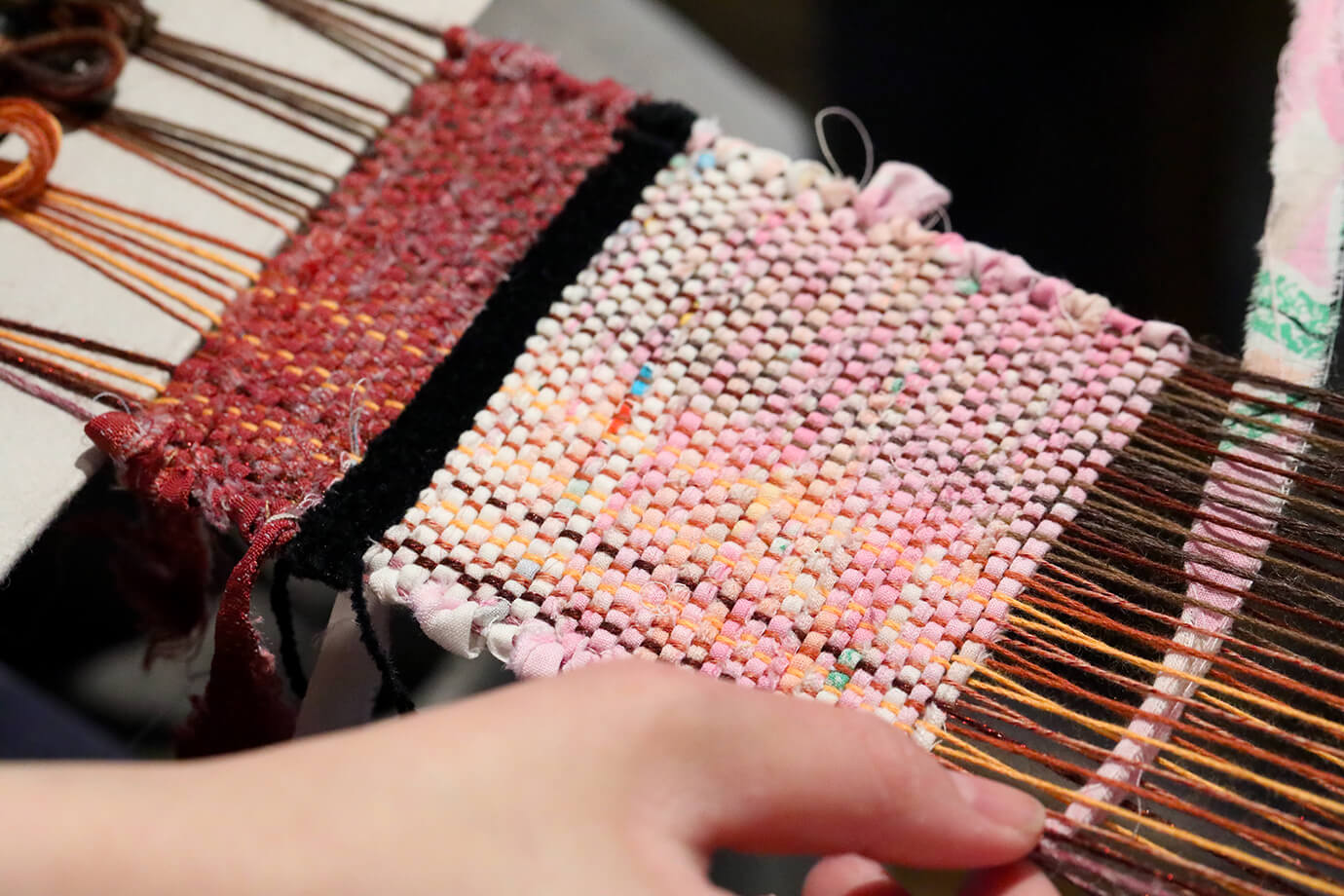
Fabric is threaded through the crosswise threads and smoothly woven. The color and degree of fraying differs depending on the fabric used, resulting in an uneven, rustic finish. You can make one coaster during the sakiori weaving experience (1,000 yen, 30 minutes).

The center is decorated with handmade crafts, including hanging dolls made from reused old cloth.
“Wishing space” where 1,000 Oshirasama are enshrined
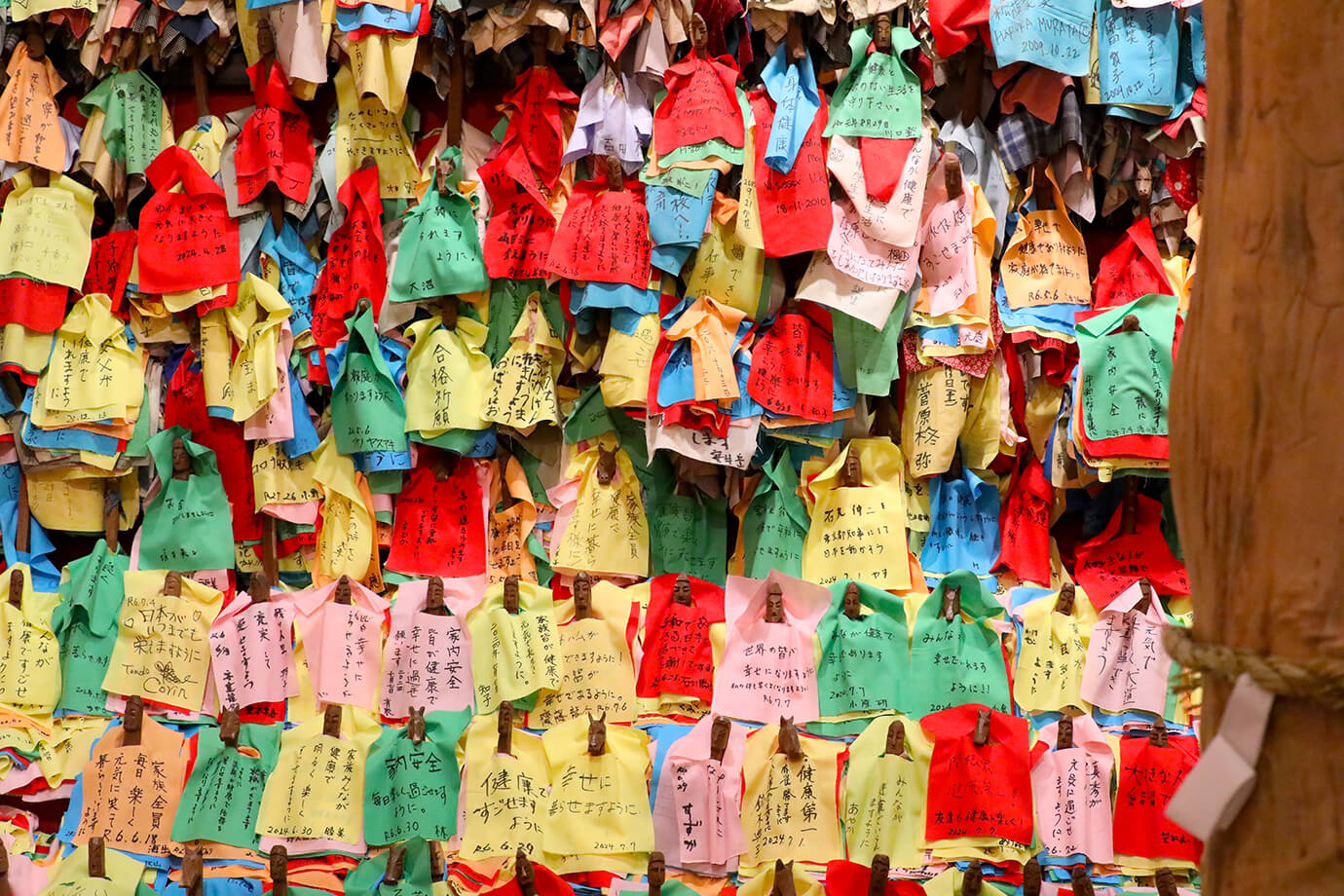
In the “Kikuchi Family Magariya," there are exhibits of daily necessities, farming tools, and other items, recreating the lifestyle of farmers in the past. At the end of the dimly lit corridor is the highlight: the “Oshirado,” where a thousand Oshirasama are enshrined in a space of about 10 square meters without any space between them!
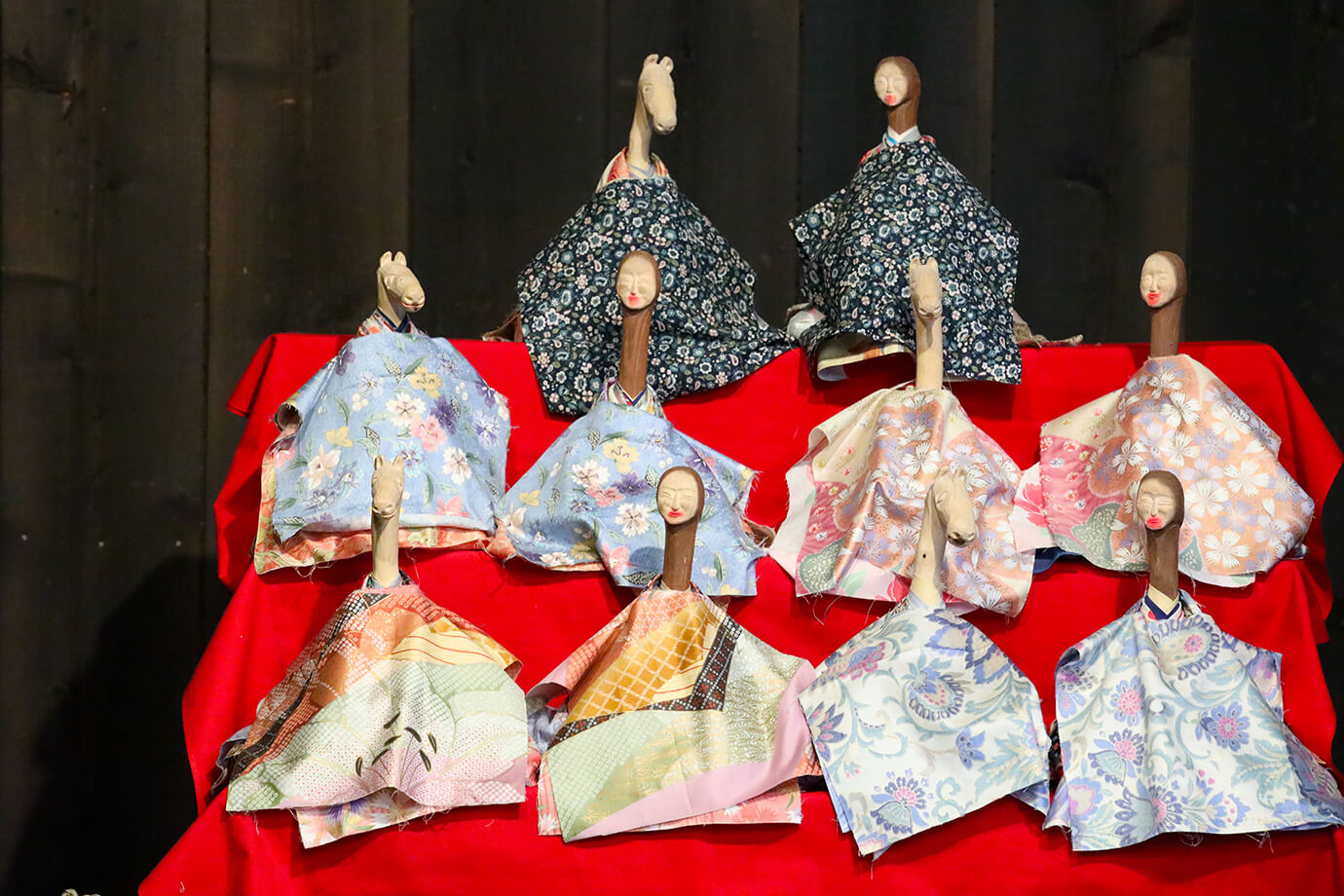
“Oshirasama” are a tradition in the Tohoku region from a deity that ascended to heaven after a tragic love affair between a horse and a human girl. They are also worshipped as gods of silkworm farming, agriculture, horses, and eyes, as well as the god of women's diseases, and as "Oshirasesama," who pass on even better things. You can make a wish by purchasing a piece of cloth for 100 yen.
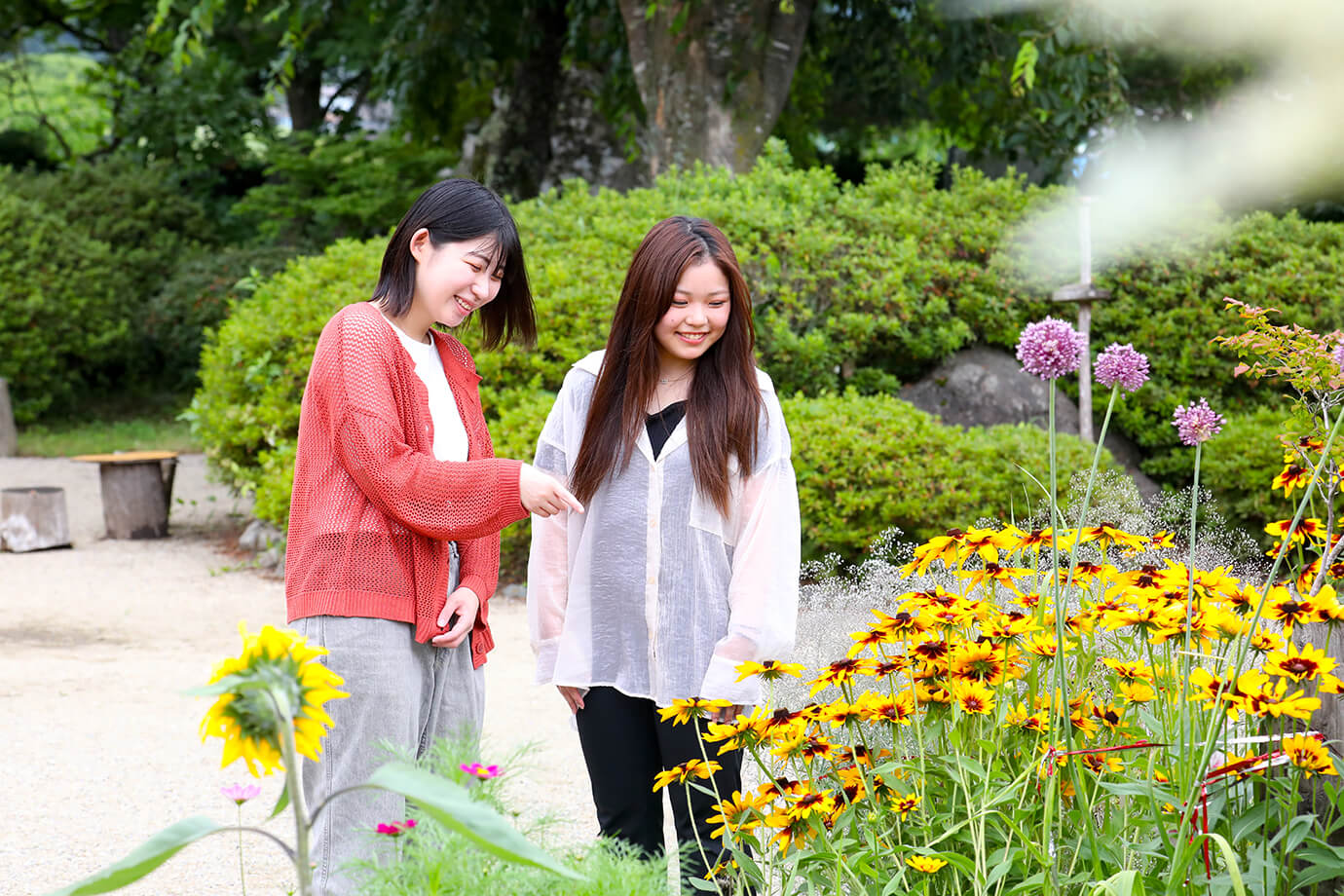
In the park, you can also see the “Sasaki Kizen Memorial Museum,” dedicated to the narrator of "Tono Monogatari," as well as a yudono (bath house), a secchin (old style toilet), a draw well, and other attractions. Seasonal flowers that bloom around the farming village are also beautiful.
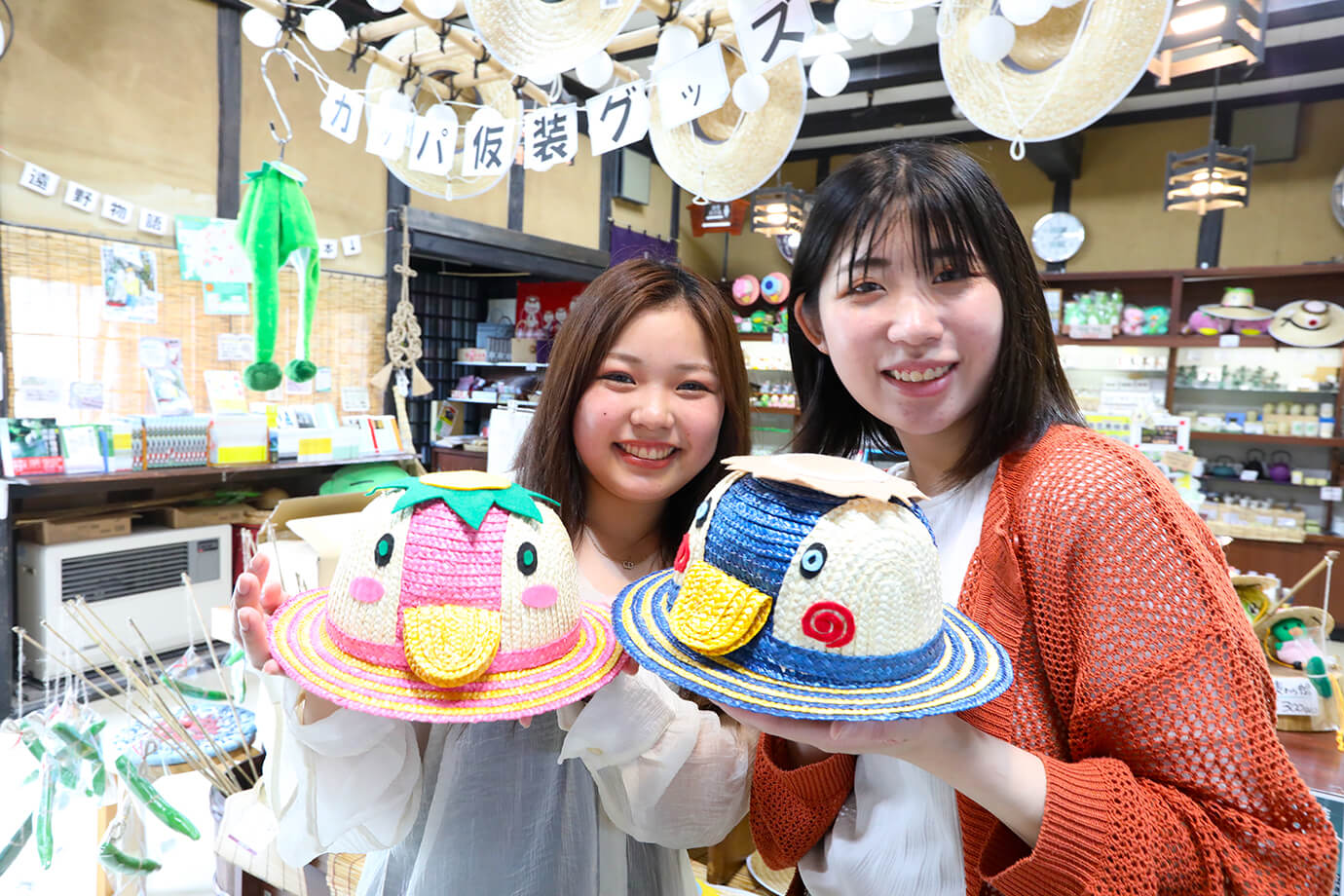
The "norikomi longhouse," which serves as the reception desk, also has a store and a full lineup of Kappa goods. How about a straw “kappa hat,” starting from 1,000 yen?
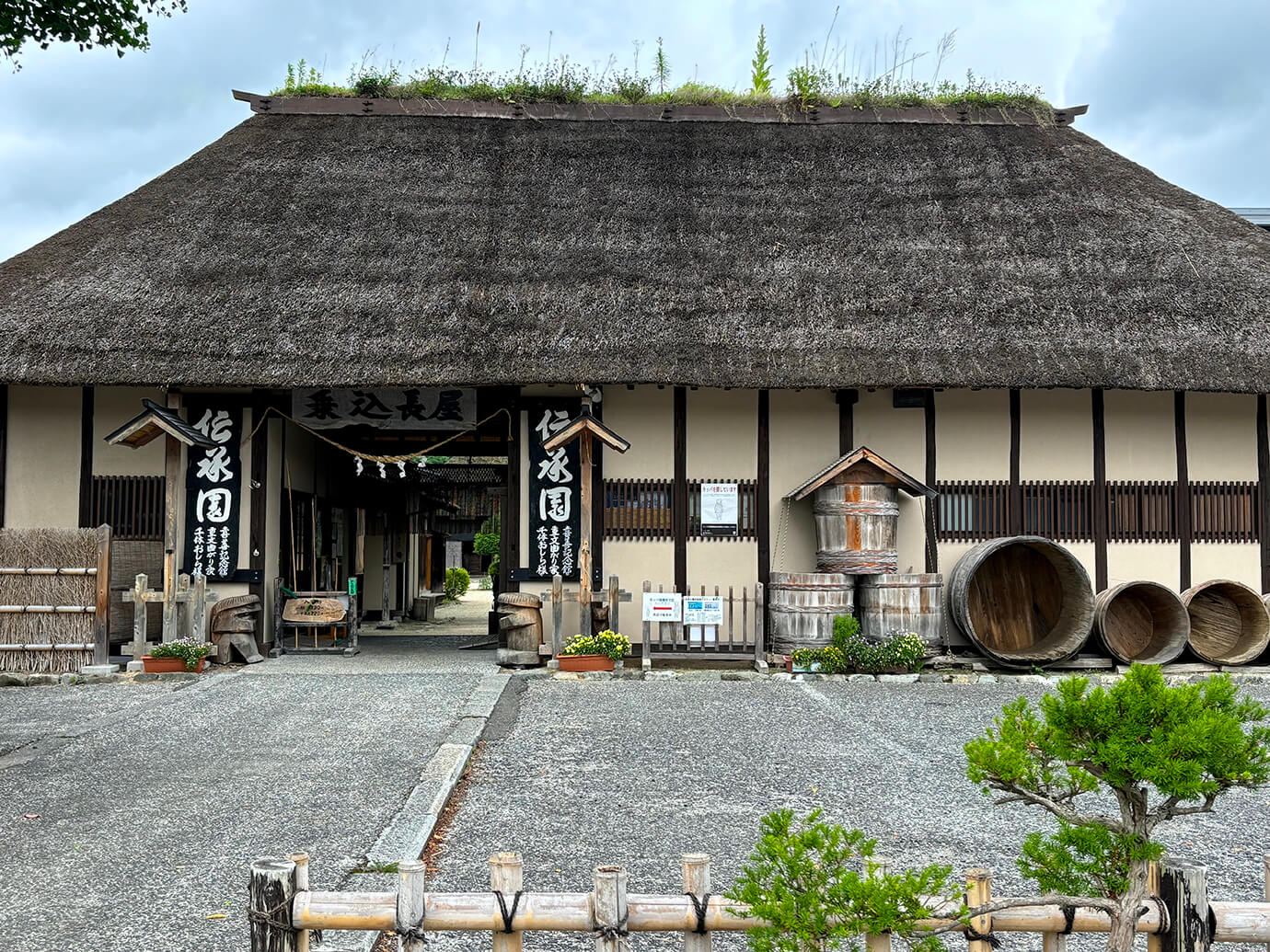
The "norikomi longhouse" is a relocated farmhouse barn built in 1850. There is also a restaurant in the back right of the store, where you can enjoy local cuisine such as "hittsumi soup" and "keiran rice cake."
Tono Denshoen Park
Address:6-5-1 Tsuchibuchi, Tsuchibuchi-cho, Tono City, Iwate Prefecture
Phone:0198-62-8655
Costs:330 yen (adults)
Hours:9:00 to 17:00 (last admission 16:30, 9:00 to 16:00 during winter)
Closed:Tuesdays in January and February, December 31 and January 1
Kappabuchi Pool
If you see a kappa by the water, seize the opportunity! Executing strategies to catch a kappa
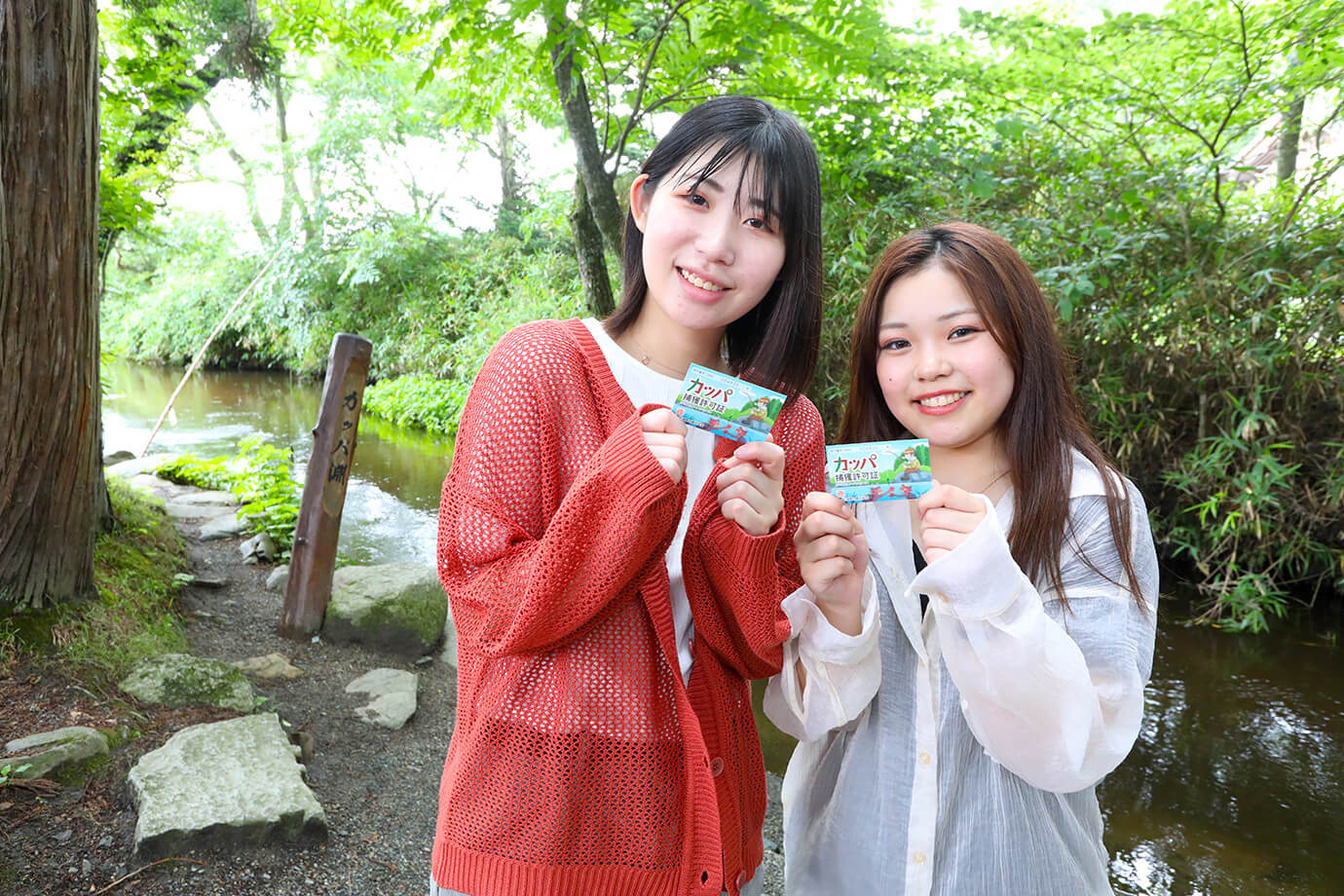
It is said that people were startled by kappas that used to live in “Kappabuchi Pool,” which flows behind the Jokenji Temple grounds. Kappa have monstrous strength that enables them to drag horses into rivers, and they love cucumbers. We purchased a "Kappa Capture Permit" for 220 yen and set out on our mission to capture a kappa.
*The “Kappa Capture Permit” is sold at Tono Denshoen Park, "Tabi-no-Kura Tono" in front of Tono Station, and other places.

The area is covered with dense foliage, and it looks as if a kappa might appear at any moment. The handwritten sign reads, "Be careful not to be dragged in by a kappa, especially if you are very attractive”....
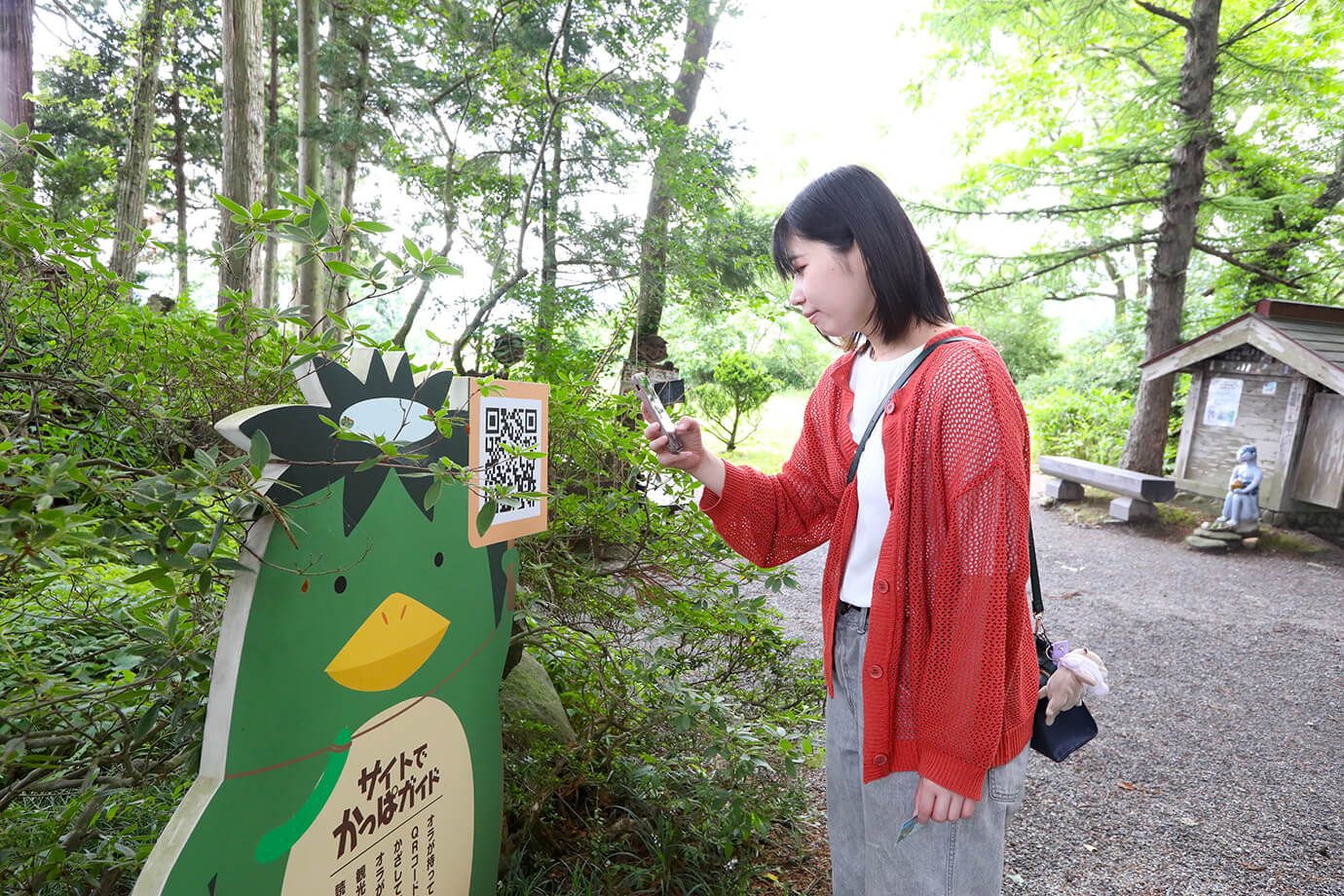
If you scan the QR code for an "On-site Kappa Guide," you can watch a video introducing the Kappabuchi Pool.
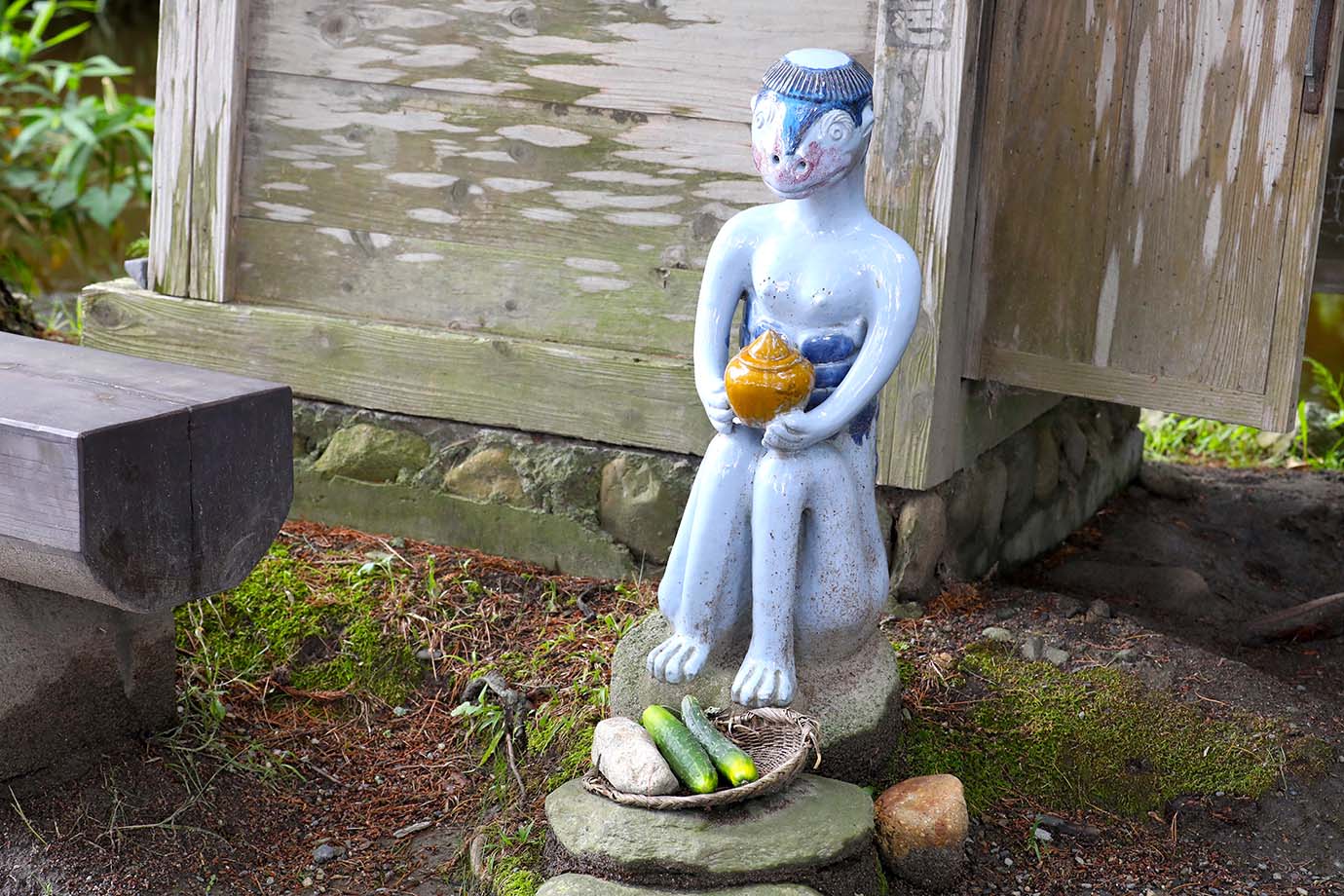
There were two kappa statues by the pool, with an offering of cucumbers. A small shrine behind the kappa enshrines a milk goddess, and it is believed that if a woman with a child prays for her milk to flow, her wish will come true.
Tying a cucumber to a fishing rod to attract kappa
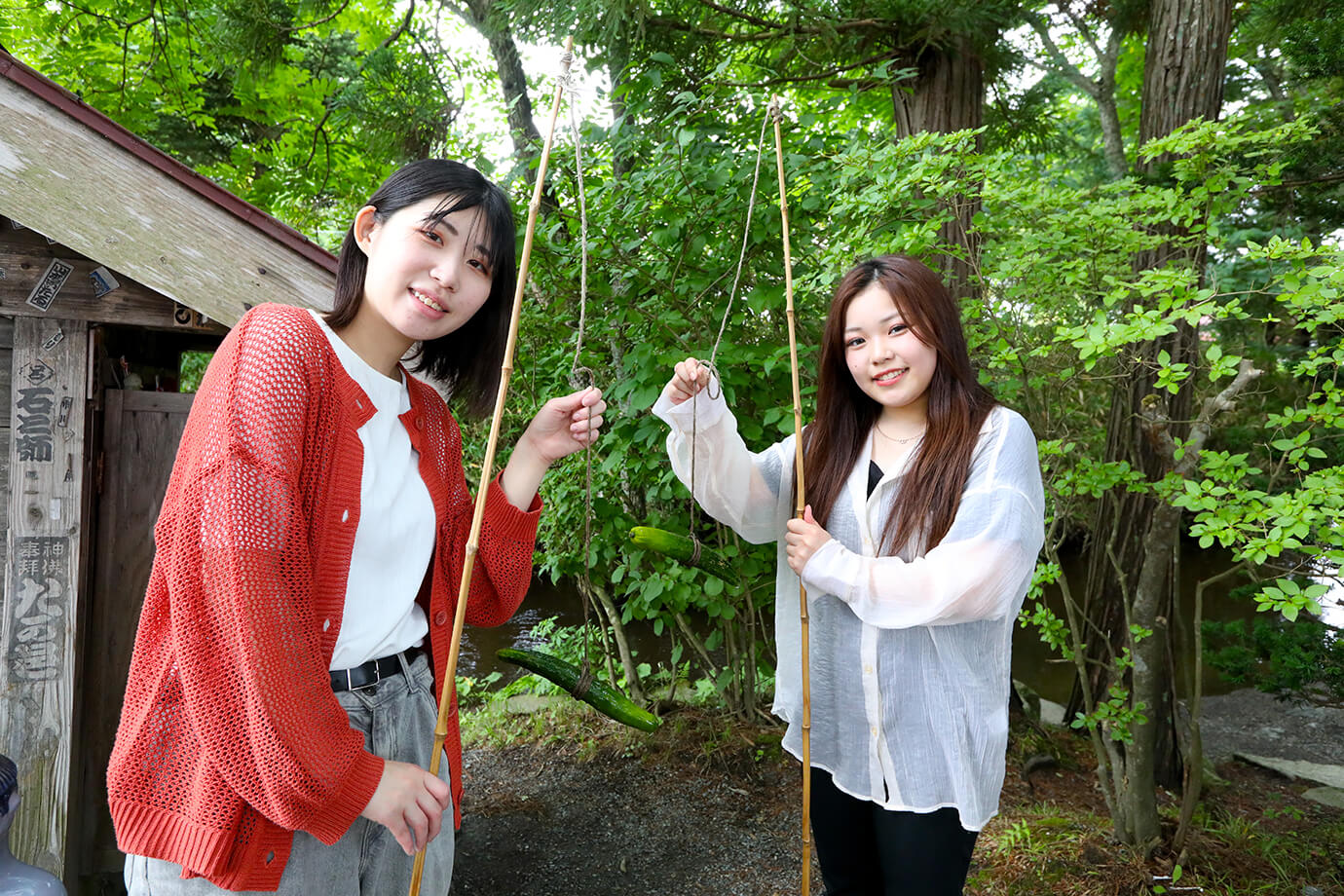
Fishing rods for catching kappa were lined up nearby, so we put a cucumber on a fishing pole and gave it a try!
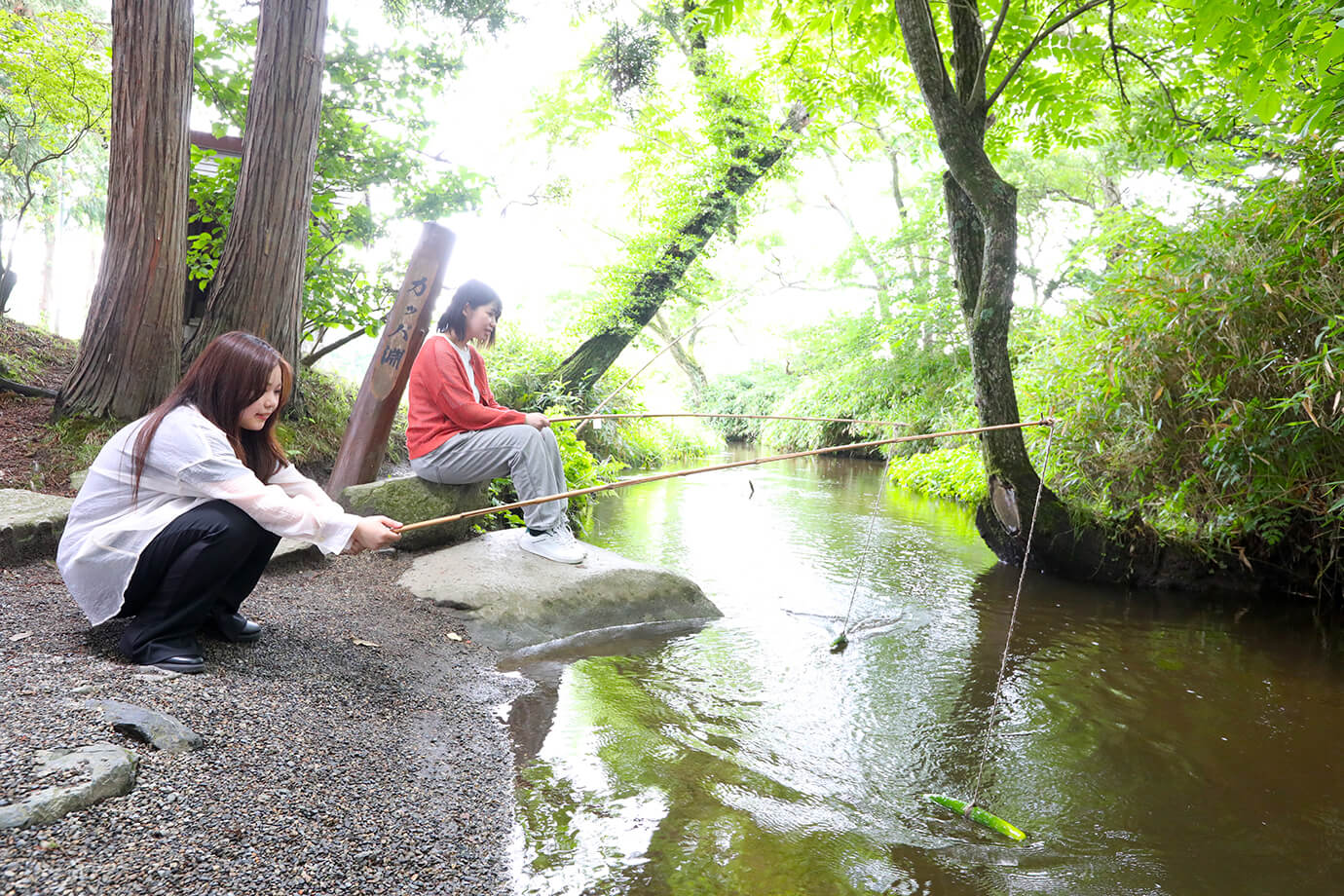
There is a bounty on kappa, and if you take a kappa to Tono Cable Television, you can win 10 million yen in prize money. It seems hard to get them there while ensuring there is always water in the dish on their head.
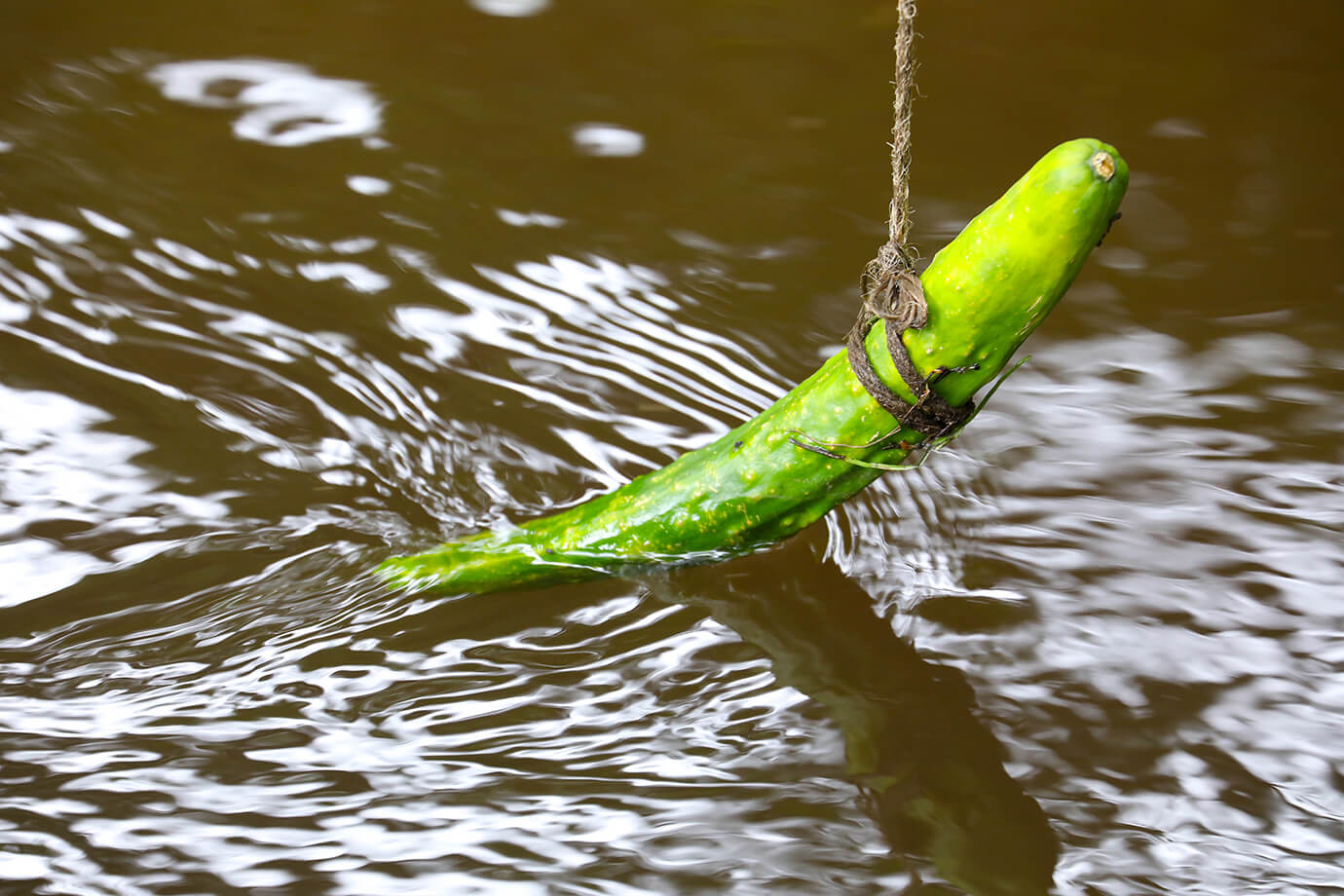
Kappa are also depicted in “Tono Monogatari,” and they have been the subject of many anecdotes up to the present day. It seems one might appear at any moment as we watch the stream flowing by.
Kappabuchi Pool
Address:Tsuchibuchi, Tsuchibuchi-cho, Tono City, Iwate Prefecture
Phone:0198-62-1333 (Tono Tourism Association)
Costs:Free
Hours:Always open to the public
Closed:Open every day
Genghis Khan Anbe
“Tono Genghis Khan,” delicious mutton served Tono style
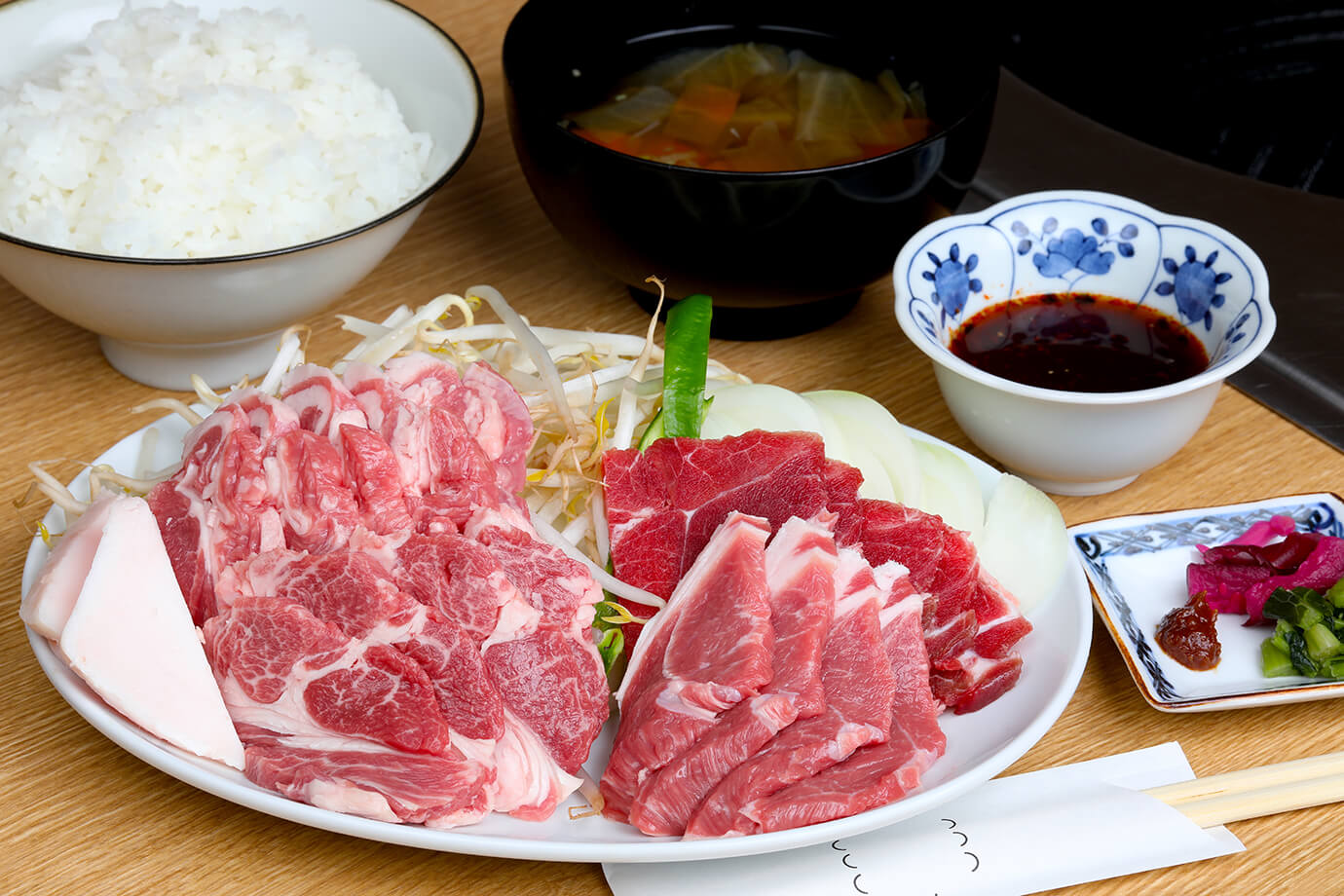
Established over 70 years ago, this restaurant is the birthplace of “Tono Genghis Khan.” The restaurant's first owner discovered the great taste of mutton while serving in the army in the former Manchuria, and upon returning to Japan, opened a butcher shop and diner. “Tono Genghis Khan” started when the restaurant began serving Genghis Khan around 1955.
The photo shows the “Anbe Taste Comparison Set Meal,” 200g, 2,180 yen.
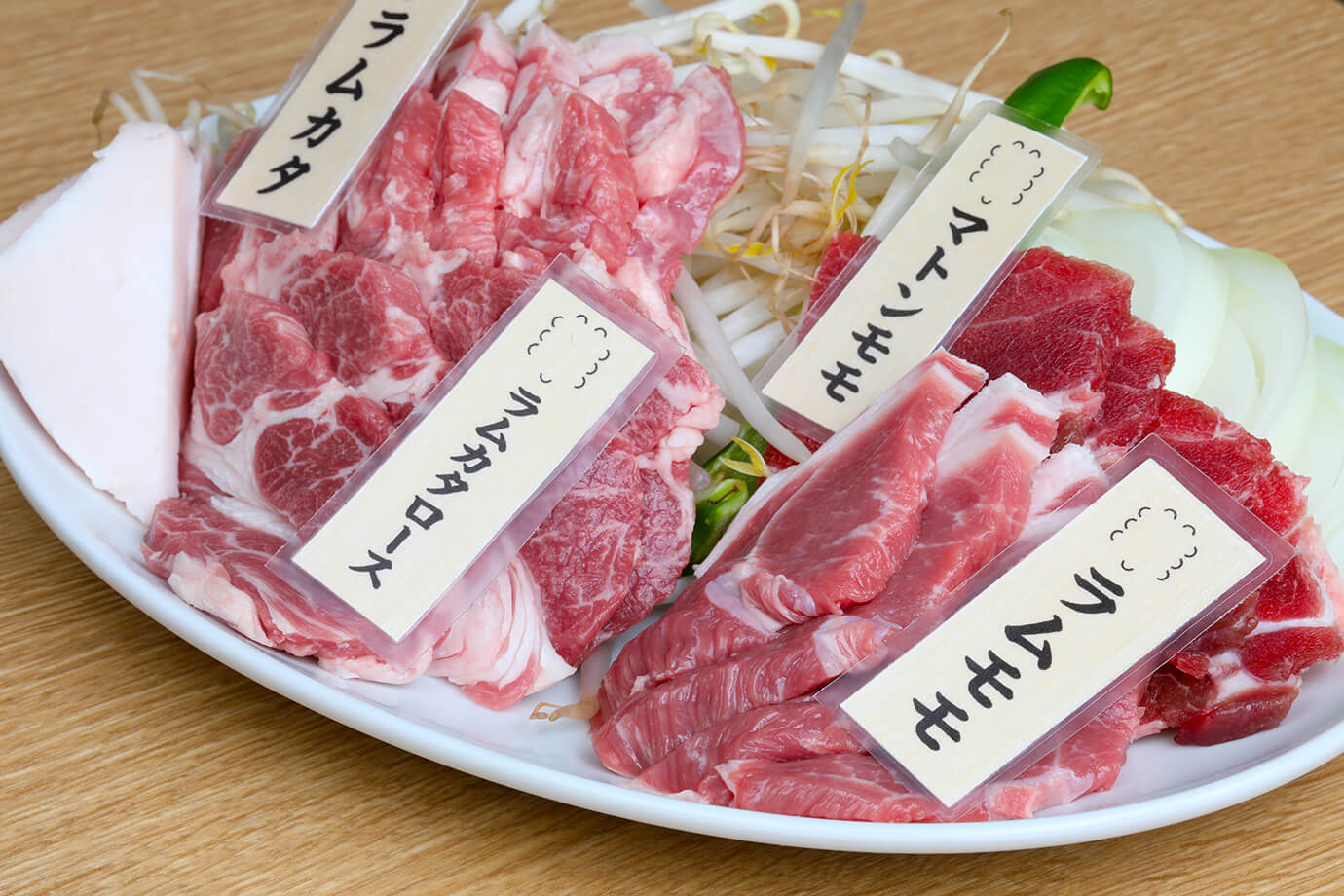
The “Anbe Taste Comparison Set Meal” provides an introduction to the cuts of meat in an easy-to-understand manner. There is also an abundance of vegetables such as onions, green peppers, and bean sprouts.
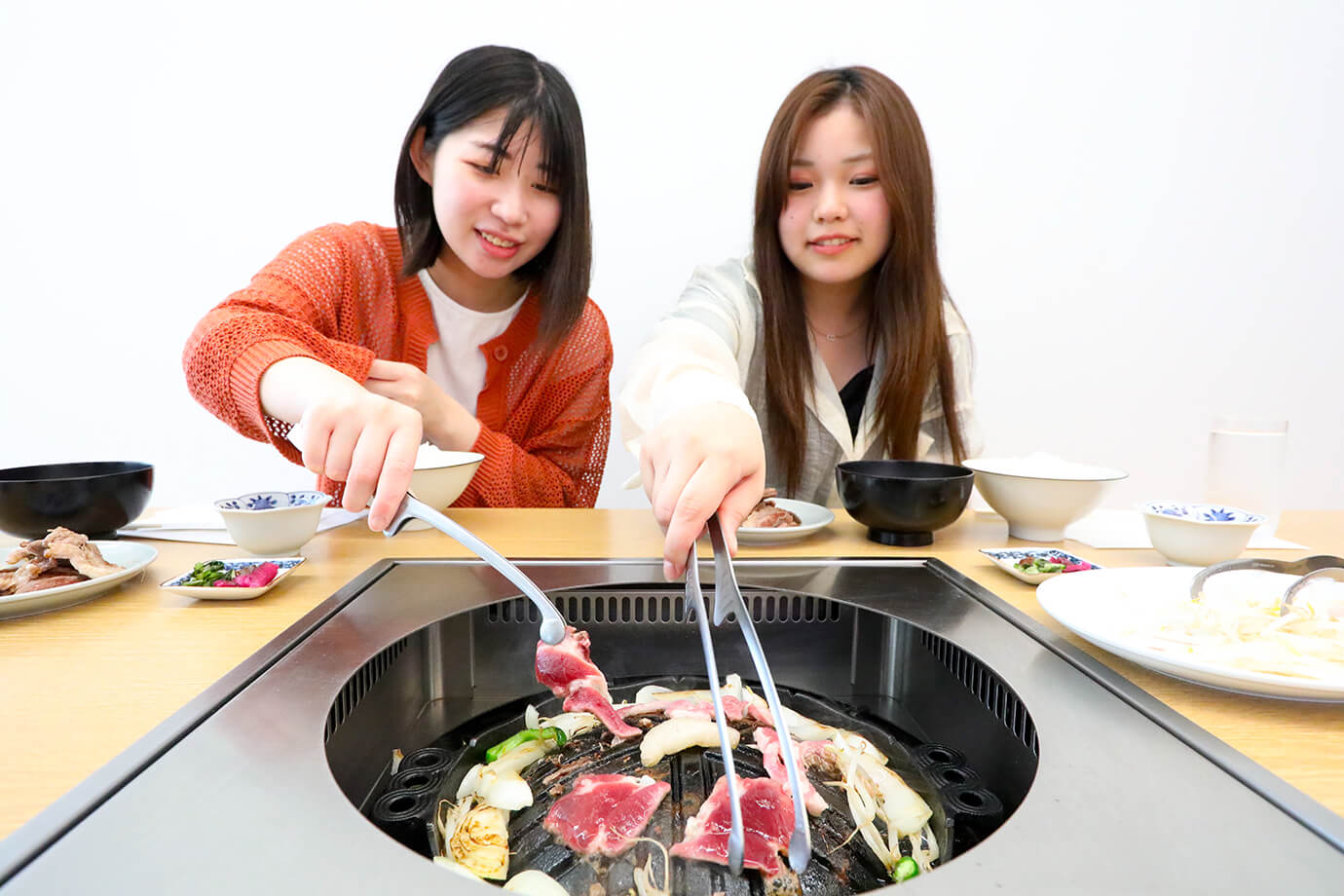
The basic style is to place the vegetables on the edges of the pan and the meat on the slopes of the pan once the pan is warmed over a medium heat. “Tono Genghis Khan” is made by grilling the meat and dipping it in a secret sauce that has been passed down for three generations.
There are also various side dishes that use mutton
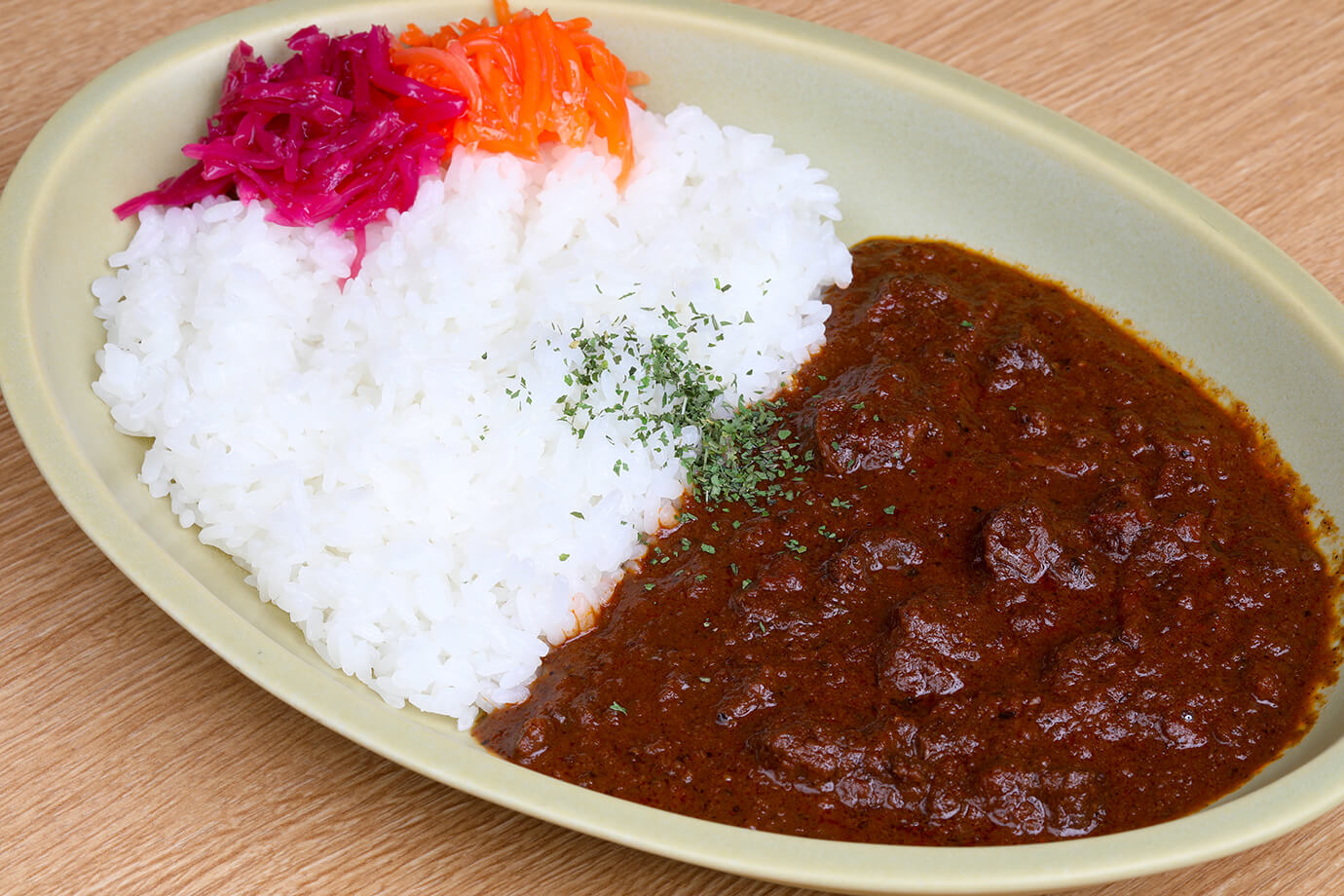
“Genghis Khan Curry Rice," made with specially selected mutton, together with tomatoes and spices, is 980 yen. The store also sells take-out “Gokujo Umakara Genghis Khan Curry” in a retort pouch for 850 yen.
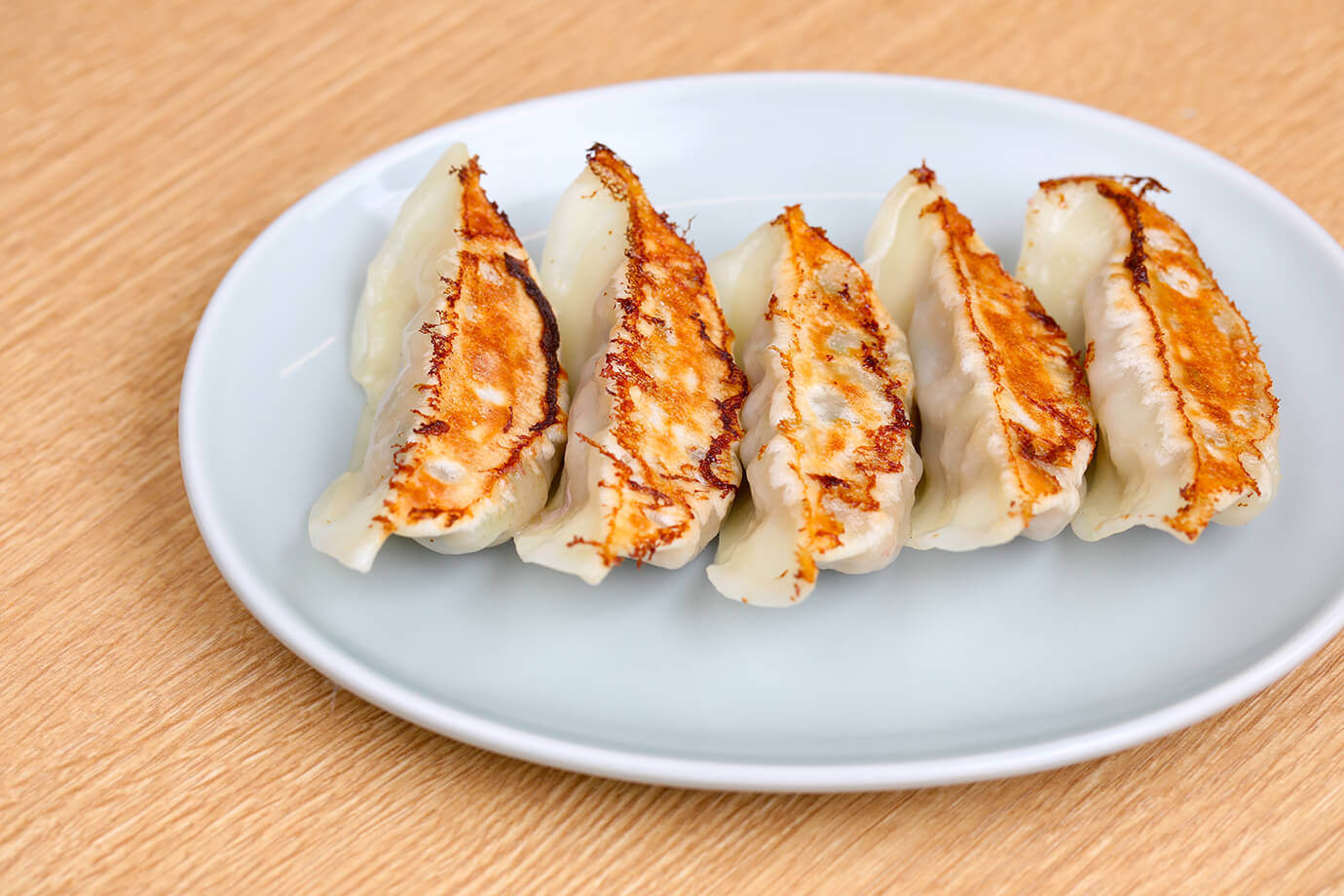
The “lamb gyoza,” made with the perfect ratio of lamb and vegetables, overflow with juices with every bite, and are priced at 480 yen.

The interior of this stylish restaurant is filled with natural light, and it is hard to believe that it is a grilled meat restaurant.
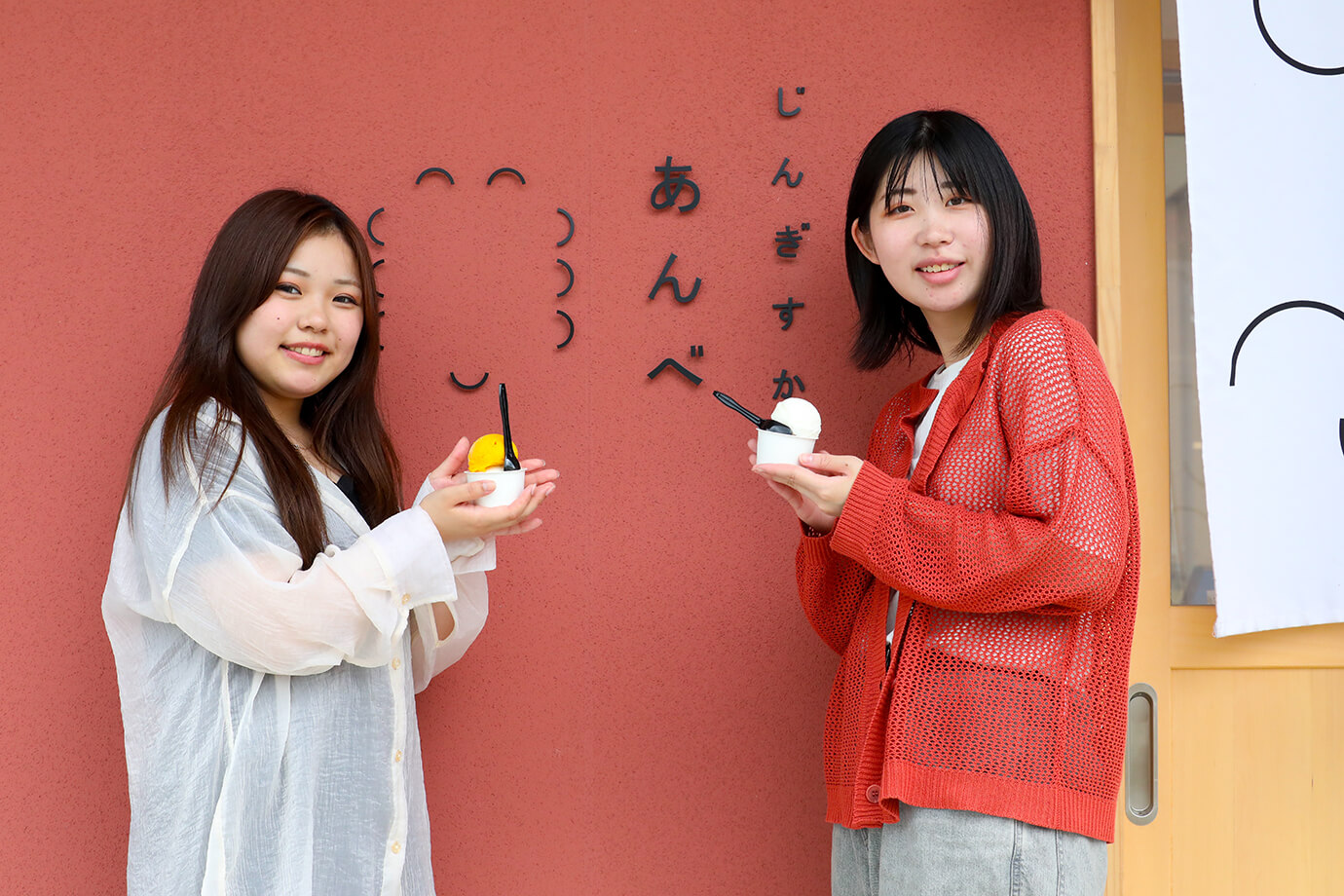
The restaurant is also proud of its homemade sweets. Chocolate, milk, mango, and strawberry flavors are 390 yen for a single portion. Pecorino cheese flavor, made from “pecorino romano” sheep’s milk cheese, is also available for an extra 60 yen ♪
Genghis Khan Anbe
Address:2-4-12 Hayase-cho, Tono City, Iwate Prefecture
Phone:0198-62-4077
Hours:11:00 to 15:00, 17:00 to 20:00 (Saturdays and Sundays: 11:00 to 20:00), store open 10:00 to 19:00
Closed:Thursday
Kamihei Shuzo Brewery
Craft beer from Tono, made from hops grown in Tono

Tono City produces the most hops of anywhere in Japan. Tono City's only sake brewery, “Kamihei Shuzo Brewery,” brews sake and craft beer using rice and hops grown in Tono. When we heard that they offer brewery tours, we immediately went to visit (tours are not available from October to March owing to the period of preparation for sake brewing; reservations are required in advance).
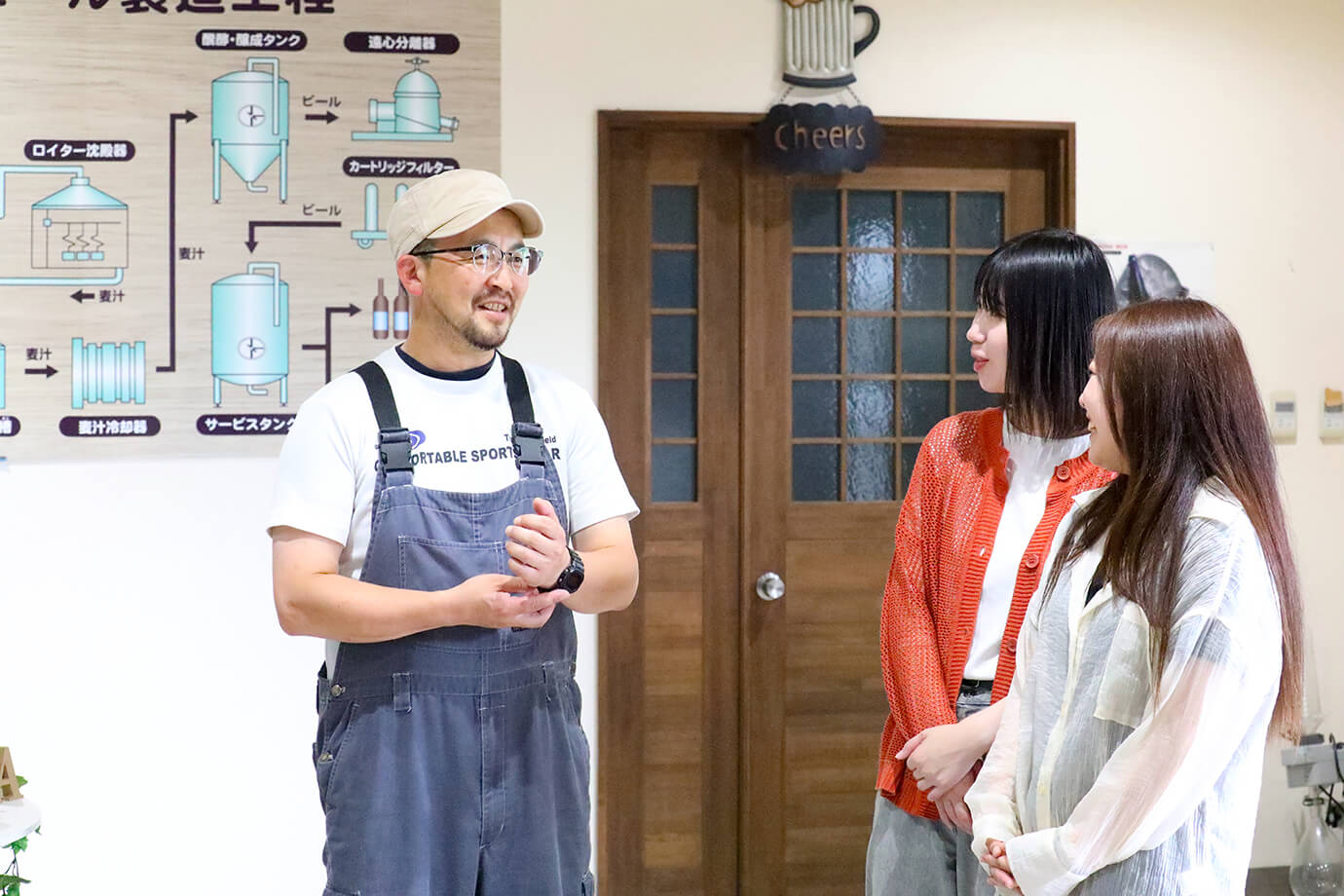
Brewer Daisuke Tsuboi, who was also on the life-size cutout at the entrance, made an appearance! Despite being busy at work, he showed us around with a smile.
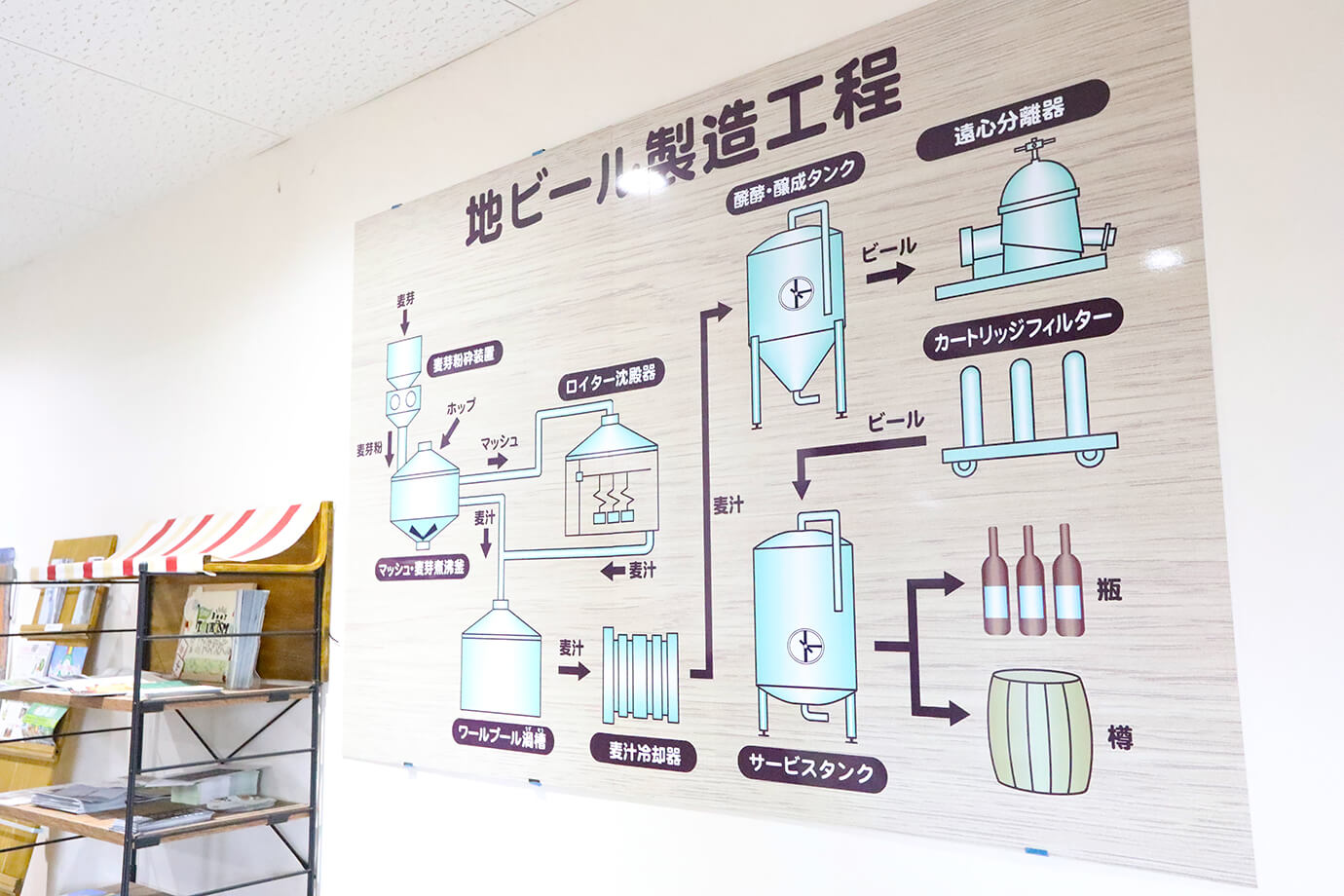
This brewery brews the craft beer "Tono Beer ZUMONA" using Tono “IBUKI” hops and underground water from Mt. Rokko-Ushi. After much trial and error, brewer Mr. Tsuboi perfected “ZUMONA.” It has been highly acclaimed in Japan and has become a representative craft beer of Tono.
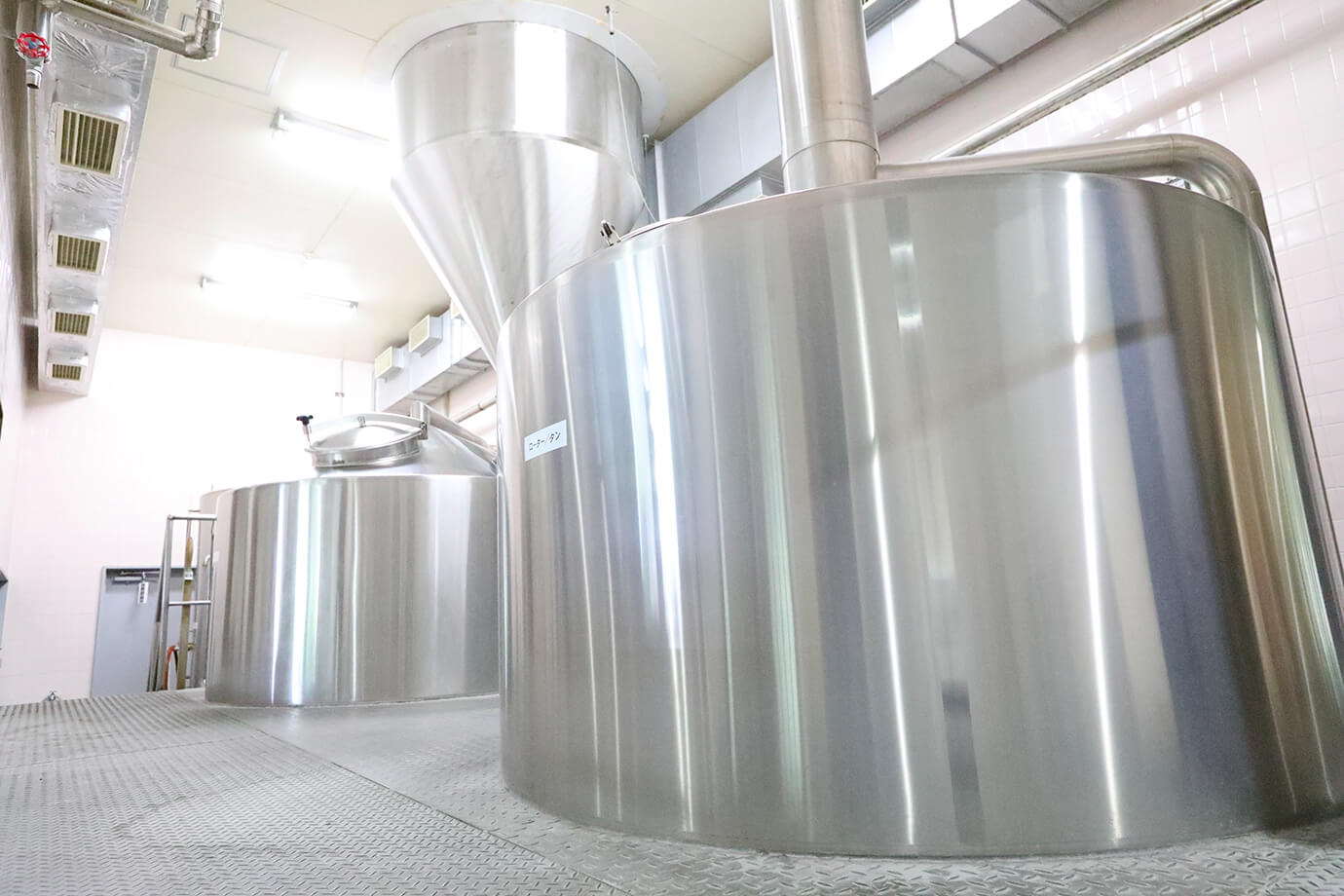
In the malt crusher located in the upper part of the "brewing room," malt is finely crushed and fed into the malt boiling pot. The "fermentation and storage room" and "filling room" are located along the route and can be observed through glass.
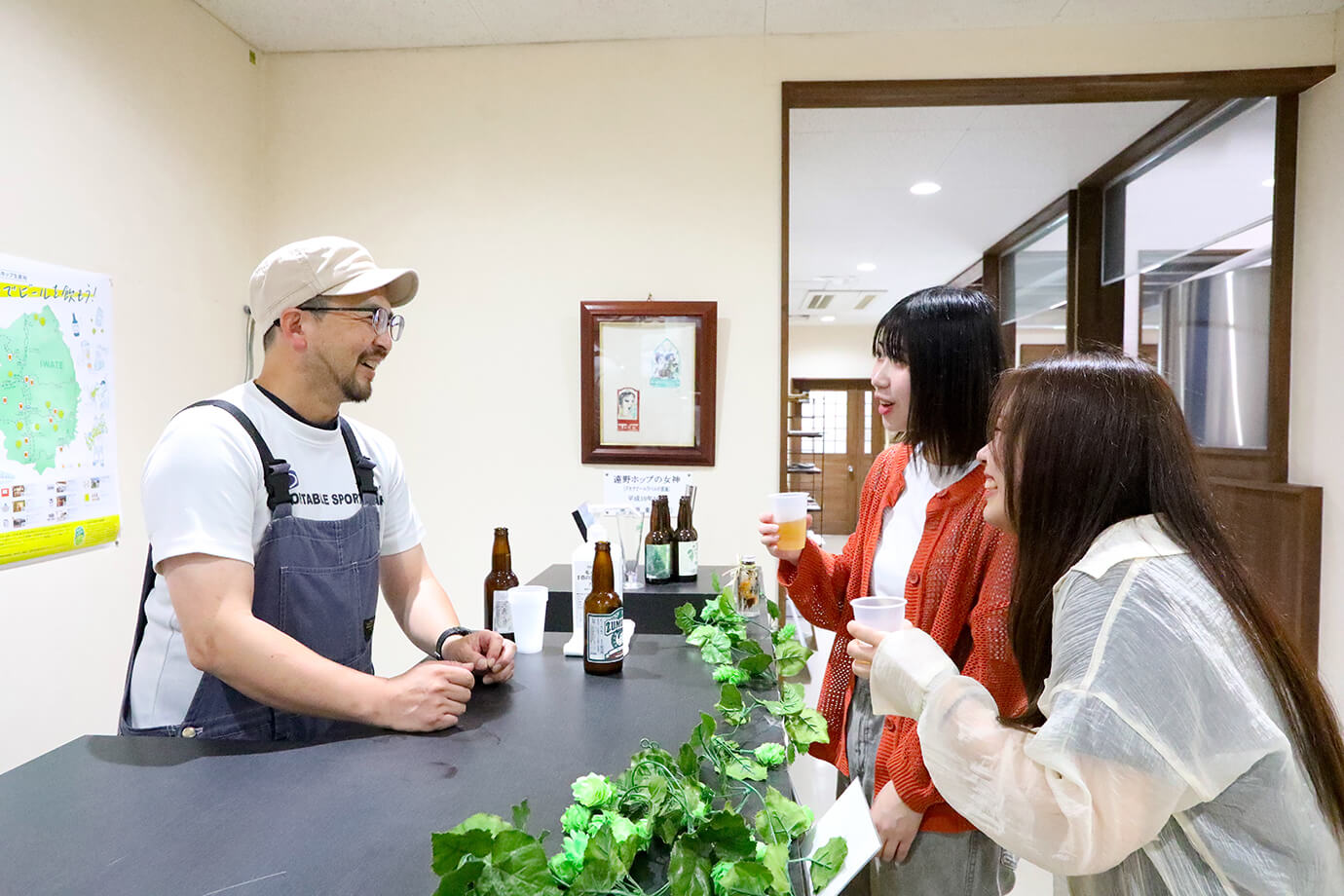
After the tour, it was time for a fun tasting. There was a range of freshly brewed beers available for tasting, including “Tono no Hana,” made with hops freshly harvested in 2023, and "Golden Pilsner," an amber-colored beer with a crisp taste. The varieties of beer vary depending on the day you visit.
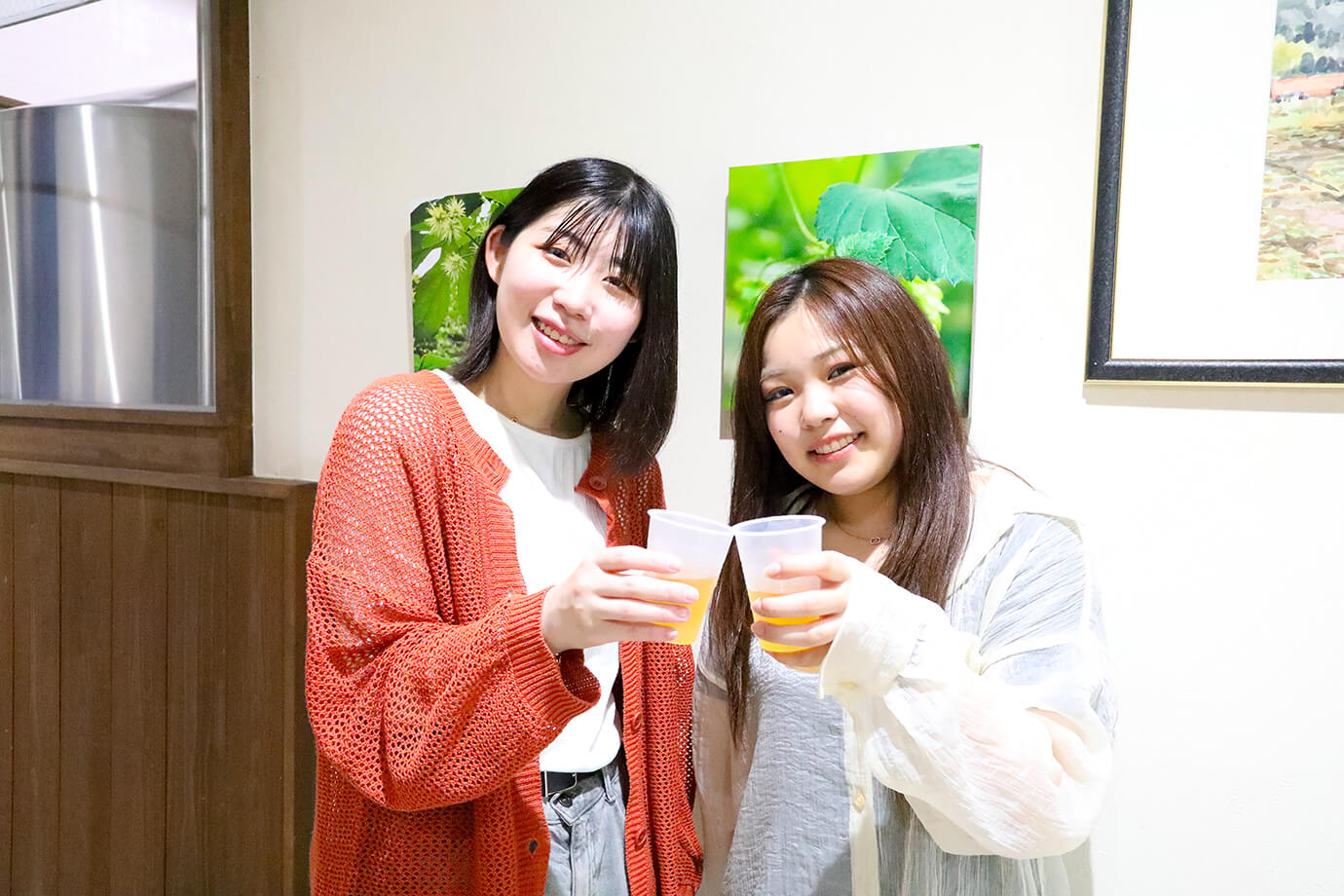
Experience craft beers born from the bounty of nature produced in Tono. Enjoy the unique hop aroma and mild taste.
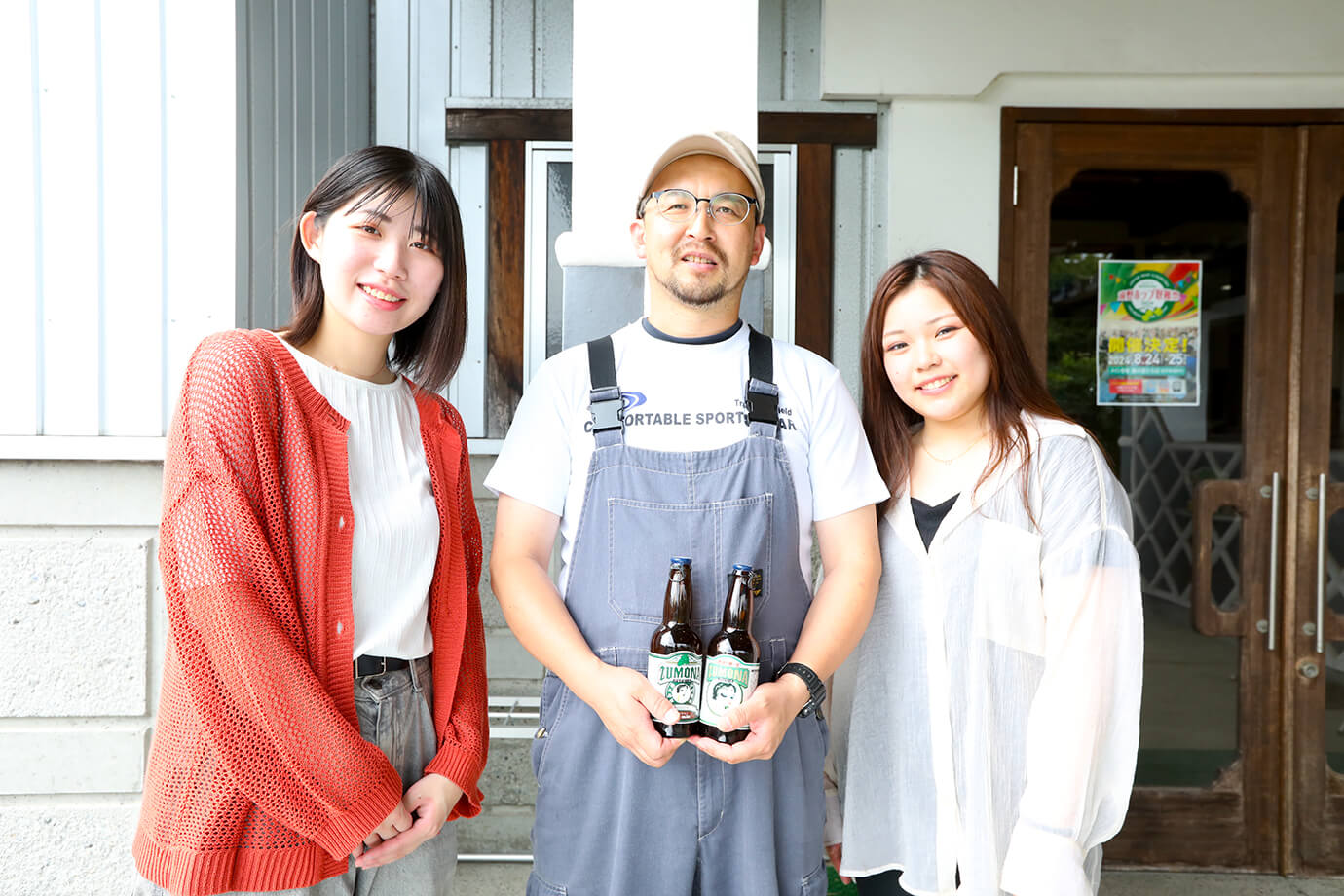
“Tono Beer ZUMONA” is available for purchase on the Kamihei Shuzo online store and at liquor stores in the city. Sales in stylish bottles will end this year. From 2025 onward, the beer will be sold in cans.
Kamihei Shuzo Brewery
Address:31-19-7 Nukamae, Aozasa-cho, Tono City, Iwate Prefecture
Phone:0198-62-2002
Costs:There is a charge for tasting
Hours:9:00 to 17:00
Closed:Saturday, Sunday, and national holidays
Unedorisama
The best power spot in Tono, where you will find love if you can tie the knot with your left hand ♪
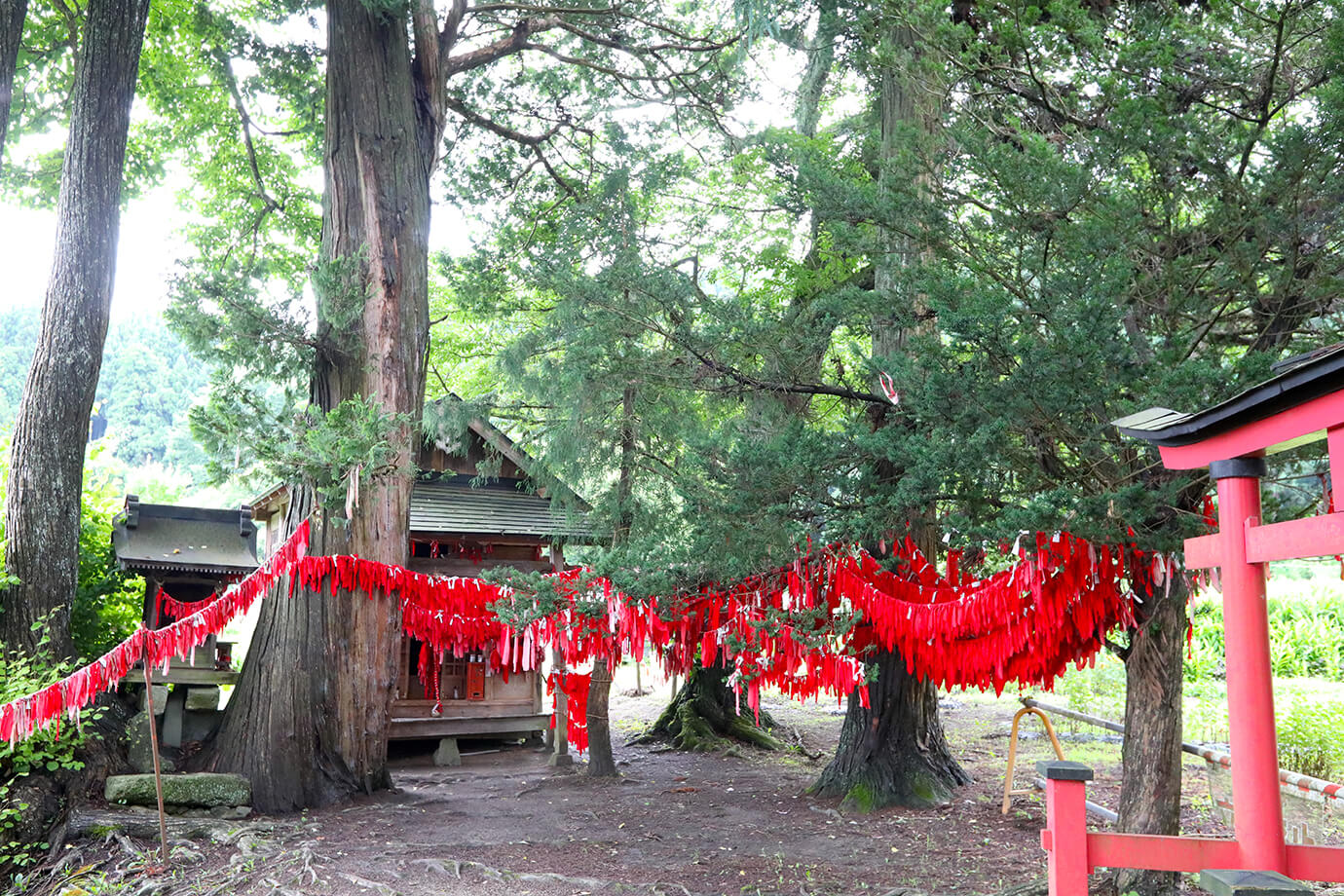
The “Unedori Shrine,” tucked away among large trees, enshrines a god known as the god of love fulfillment and called "Unedorisama" by locals. The shrine has a long history and is mentioned in "Tono Monogatari Shui.”
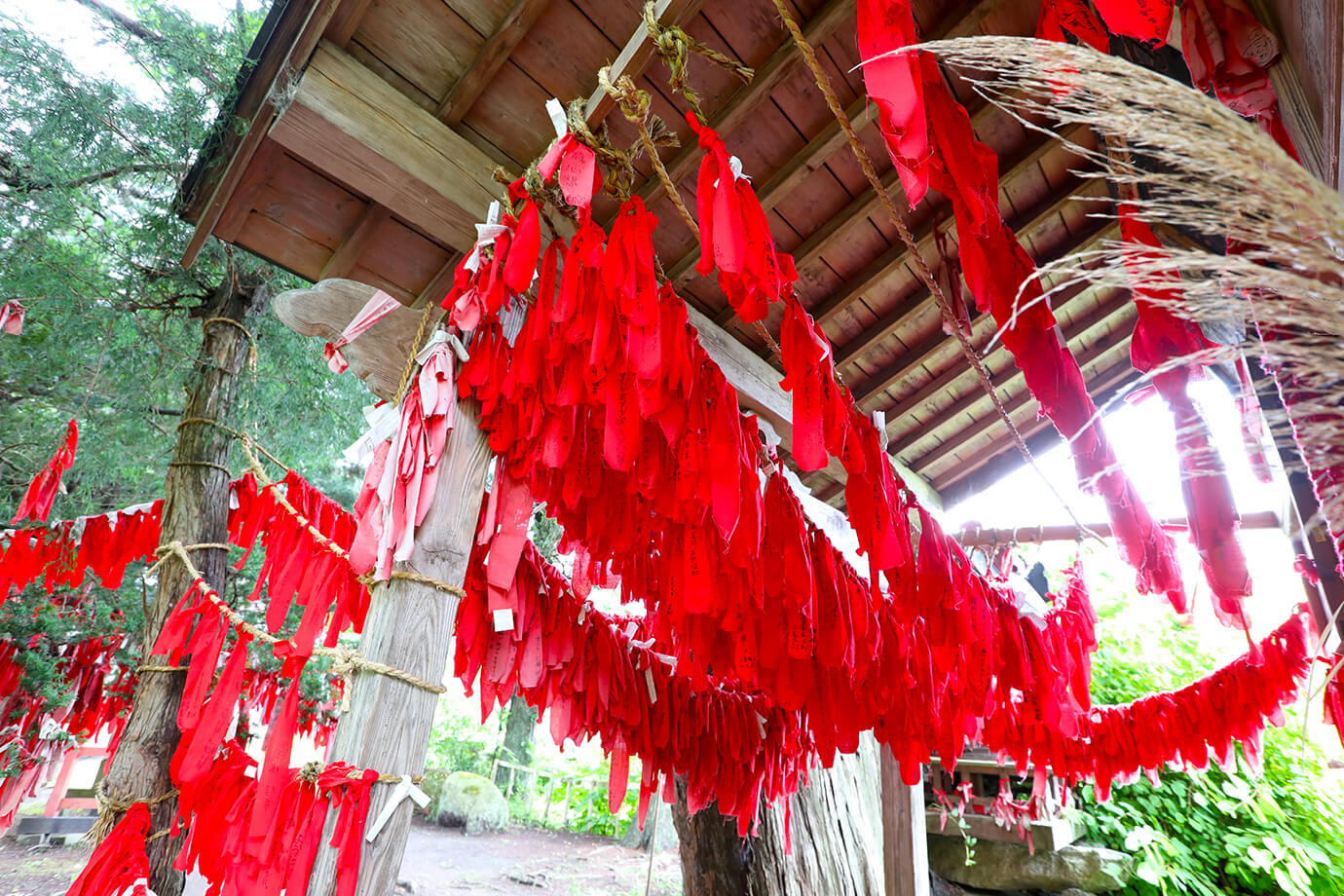
The first thing visitors see when they enter the shrine grounds is innumerable red cloths! There are ropes strung between trees and inside buildings, from which countless cloths with wishes written on them hang.

The framed plaques hung in the worship hall read "Suijinja" and "Unedori,"respectively; and there is also a plaque depicting a white tiger.

Take a red cloth from in front of the shrine for 100 yen and write your wish with a marking pen.
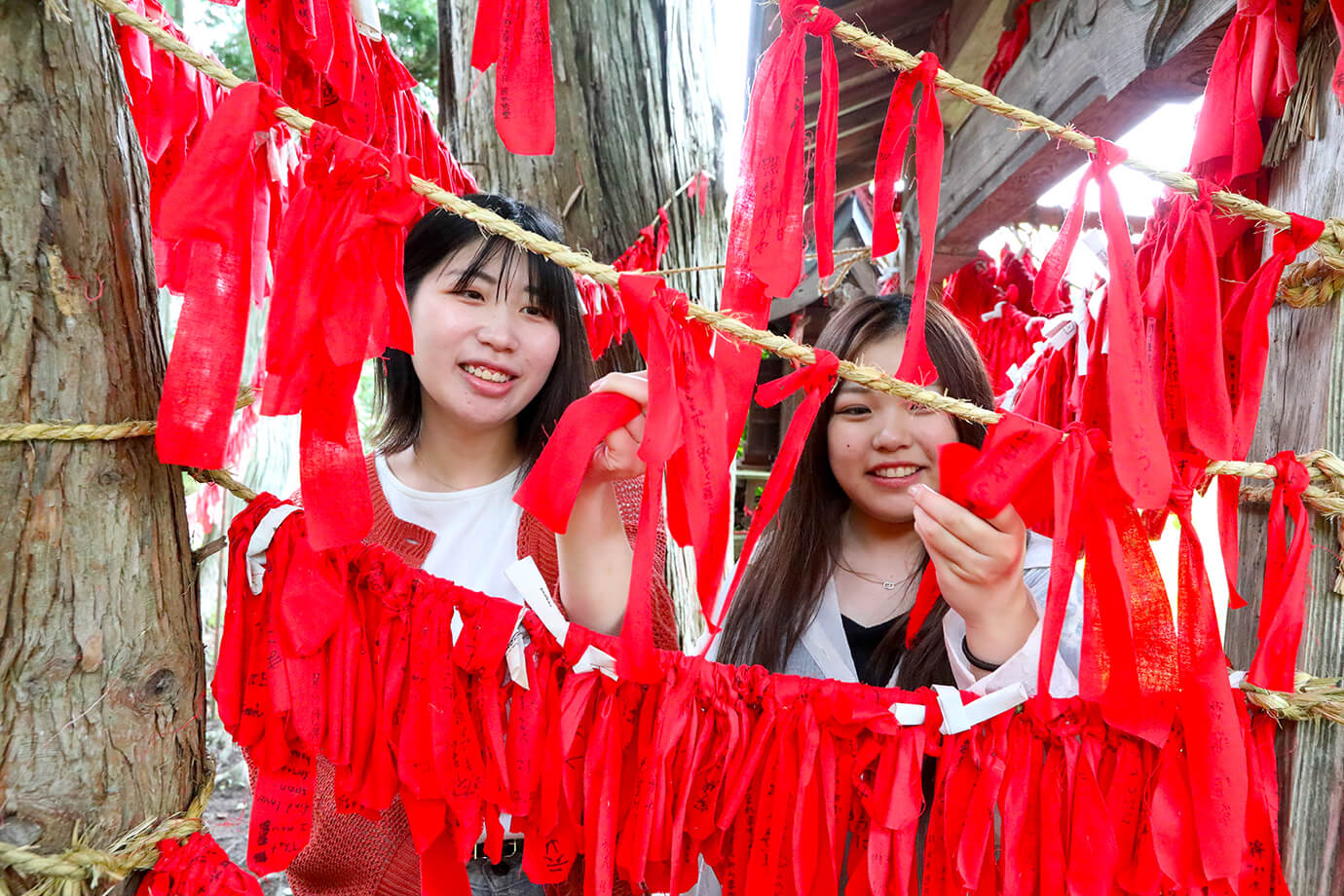
Tie the cloth with your wish written on to a tree branch or rope. It is important to note that the right hand must not be used for this. It is said that if you can tie the knot using only your left hand, your wish will come true. Please make a wish that your love will be fulfilled, and take on the challenge of tying it with your left hand.
Unedorisama
Address:11 Shimokumi-cho, Tono City, Iwate Prefecture
Phone:0198-62-1333 (Tono Tourism Association)
Hours:Always open to the public
Closed:Open every day
Hotel Folkloro Sanrikukamaishi
Welcome to the "traveler’s port,” where you can learn about the charms of Sanriku Kamaishi
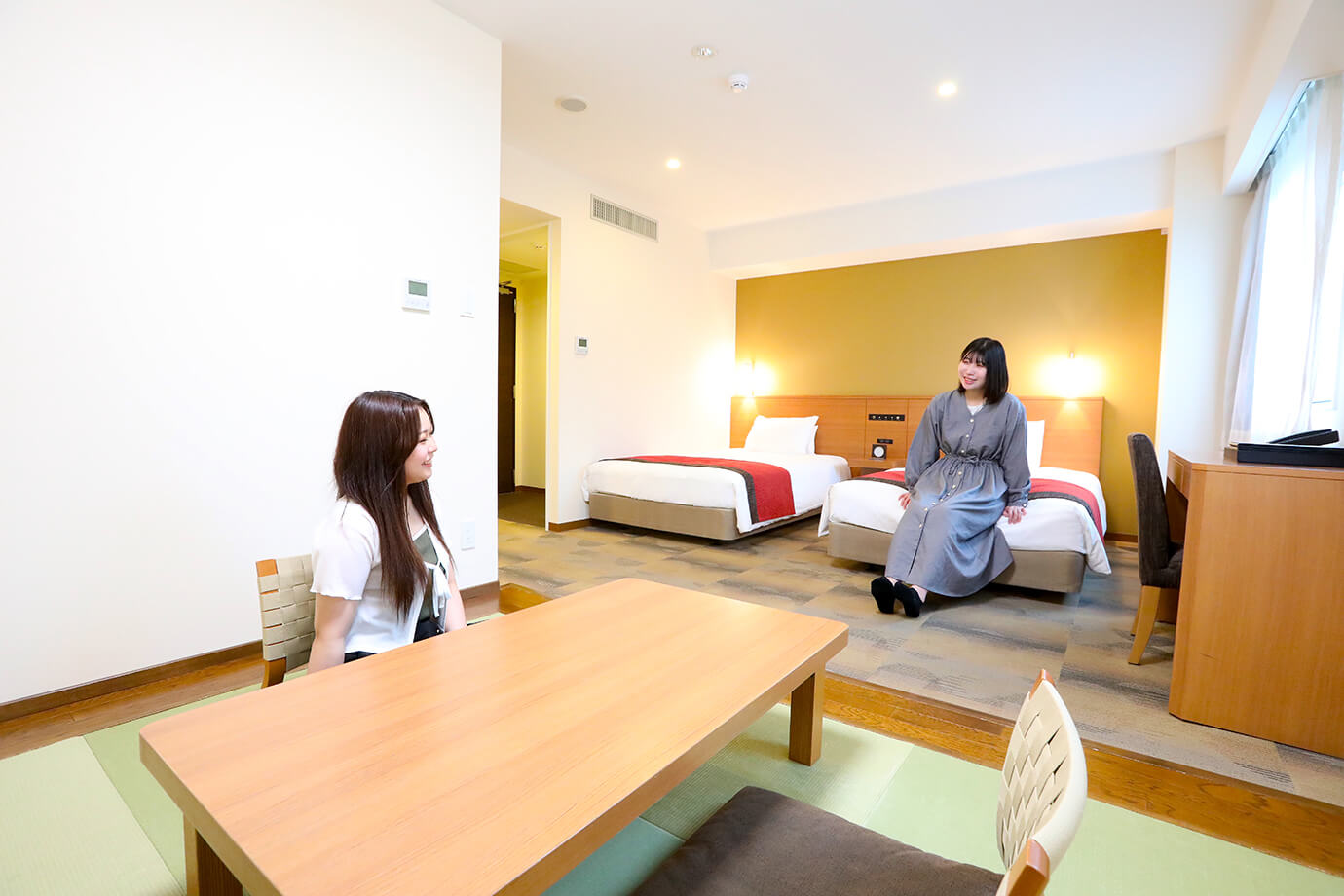
Located next to JR Kamaishi Station, the hotel is a tourist spot that overlooks Kamaishi city. Kamaishi's culture, which has been supported by the sea of Sanriku and its history of steel manufacturing, is considered from the perspective of a “traveler's port,” and the design is reminiscent of Provence in the south of France. All guest rooms are equipped with Simmons’ beds, humidifying air purifiers, and Wi-Fi. The family room in the photo is spacious enough to accommodate up to four people!
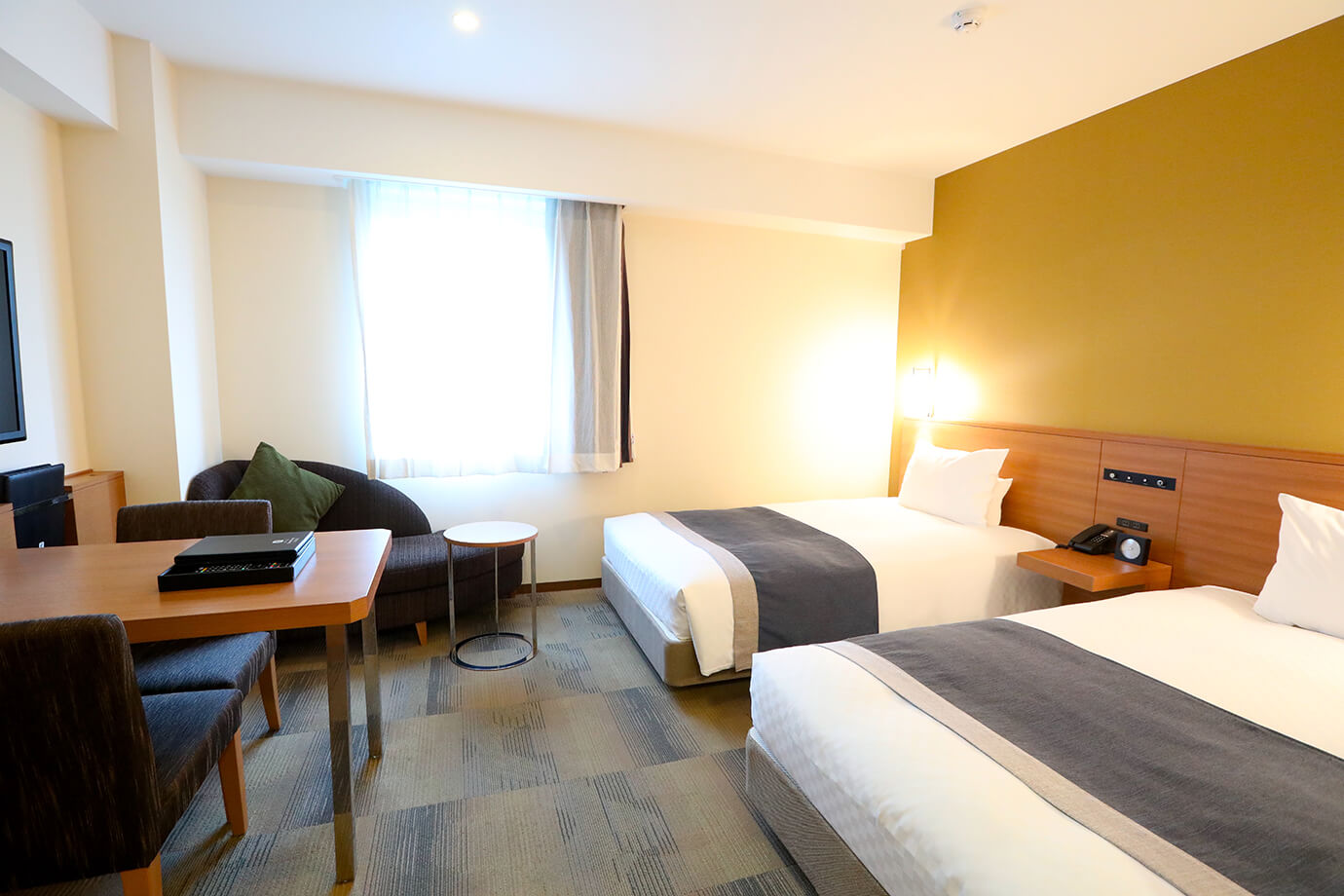
In addition to single and twin rooms (see photo), the hotel also has rooms with special features, such as the "Corner Double Room" with a washer/dryer and the "SL Ginga Room" where guests can experience the world of the fairy tale “Night on the Galactic Railroad.”
On the top floor, there is a bathhouse with an open-air bath, where guests can feel refreshed while enjoying a view of the mountains and the star-filled sky.
Breakfast at a resort-style café and restaurant
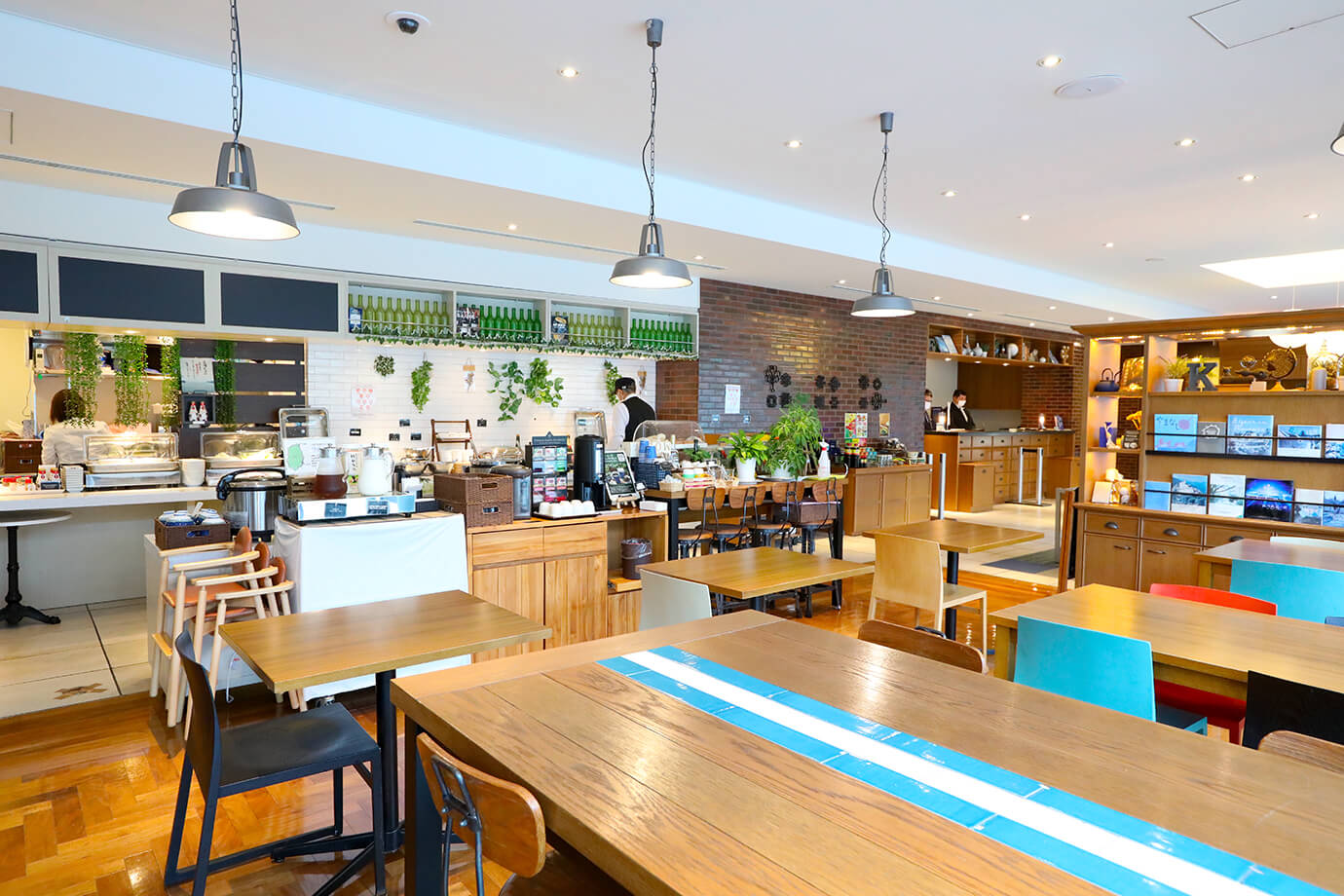
“Café & Restaurant Kamaishi Terrace,” located on the first floor, can be used in a variety of settings, from breakfast to lunch time.
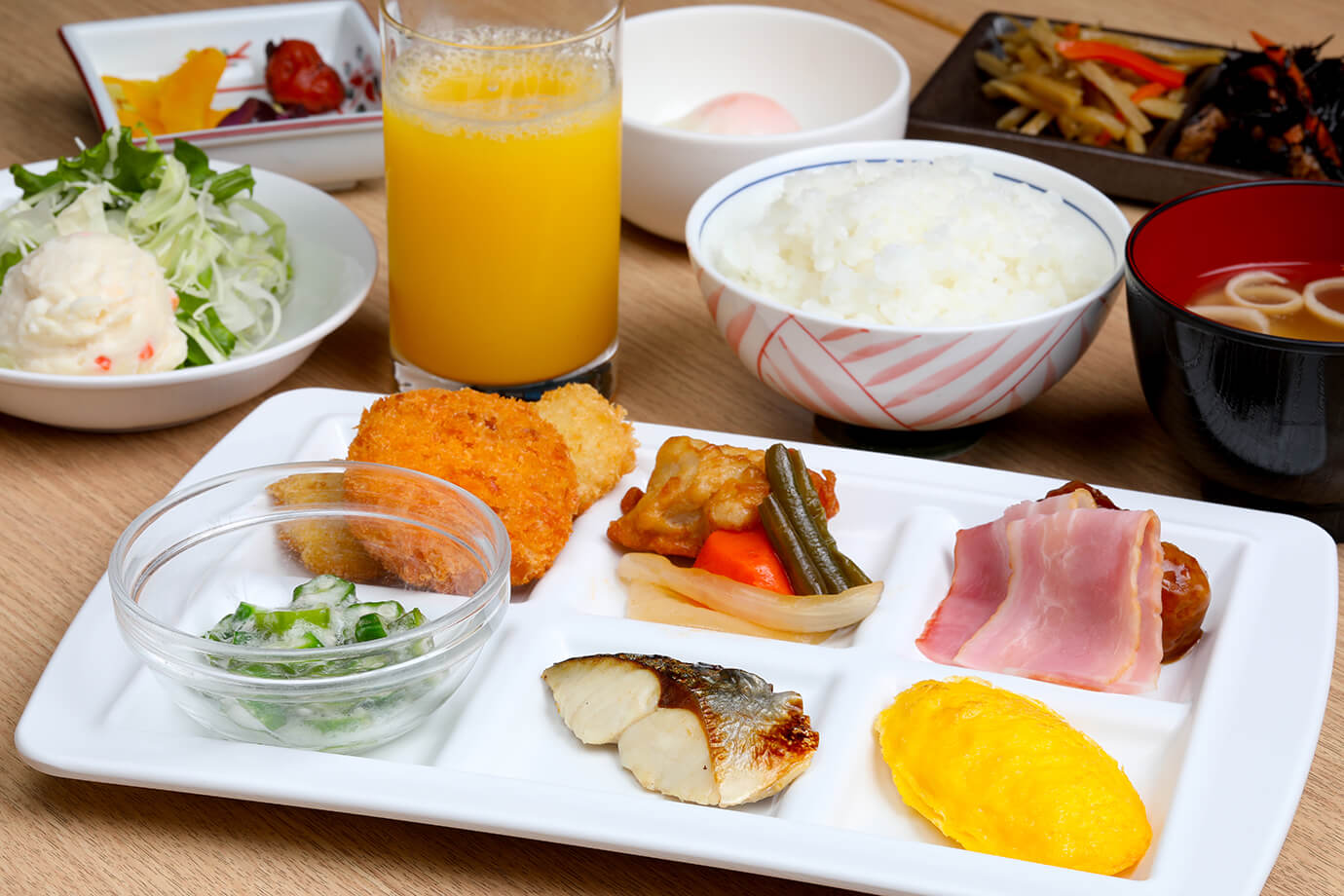
Breakfast is served buffet style. The Japanese menu includes many dishes, such as freshly cooked rice, miso soup, grilled and fried fish, boiled dishes, and slow-boiled eggs.
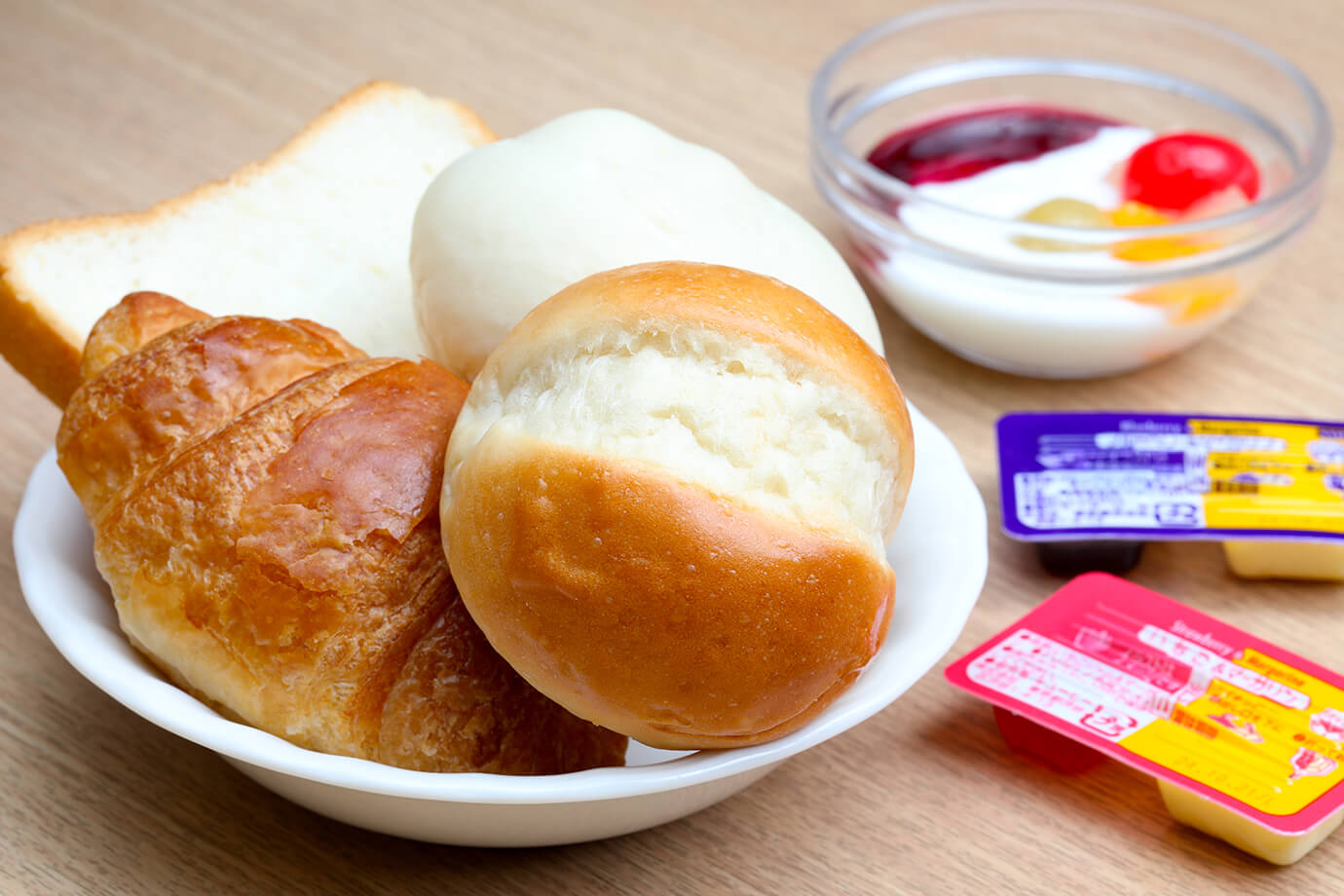
There is also a wide variety of breads, including slices of bread, croissants, and white bread. People who prefer Western food in the morning can enjoy breakfast with yogurt and omelet.
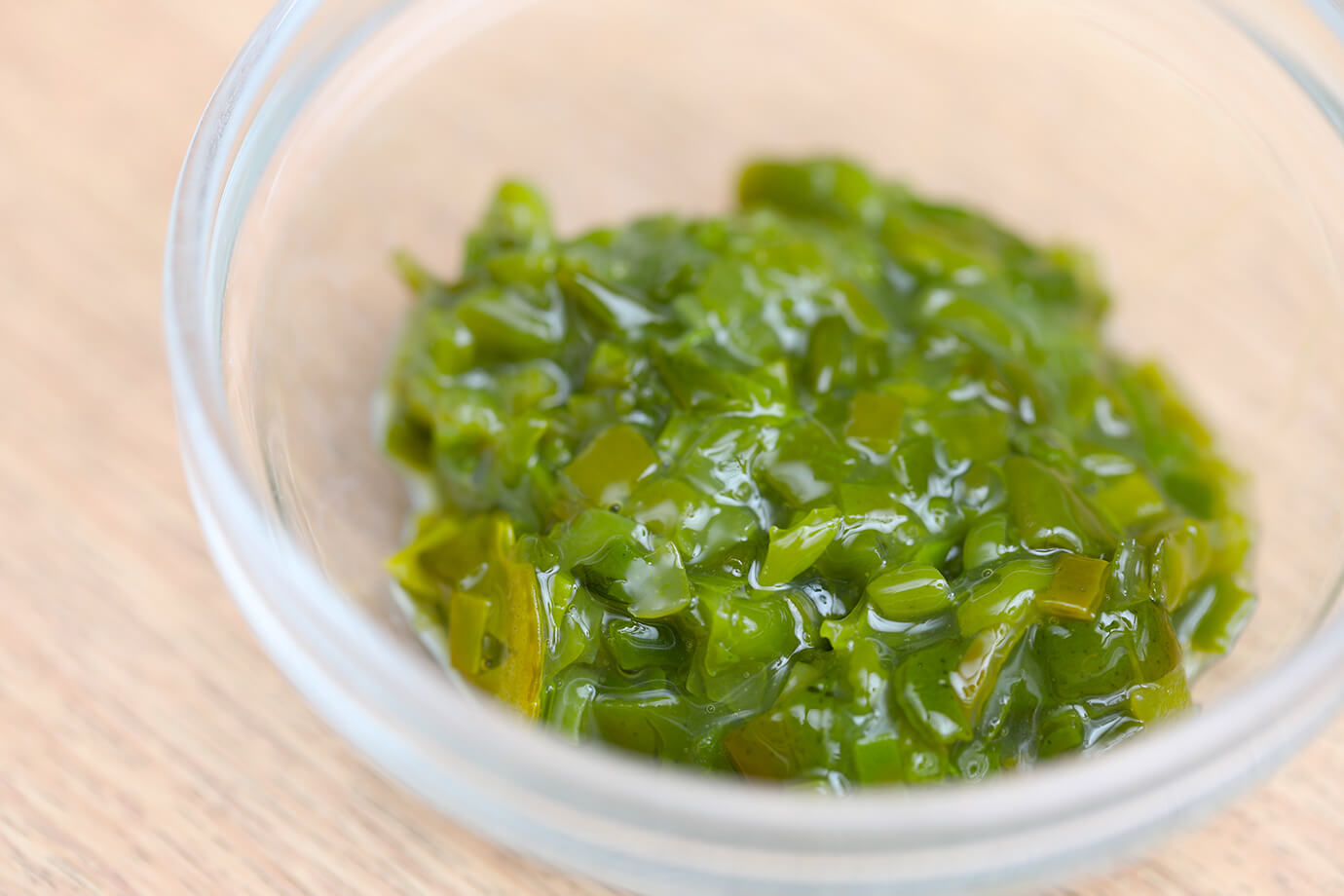
Our top recommendation is "Sanriku mekabu (seaweed).” Thick-fleshed mekabu grown in Sanriku is very sticky and has an irresistible aroma of the sea.

The blue-tiled walls are decorated with rudders, oars, and other decorations inspired by the sea. Welcome a refreshing morning in a space with a nice open feeling.
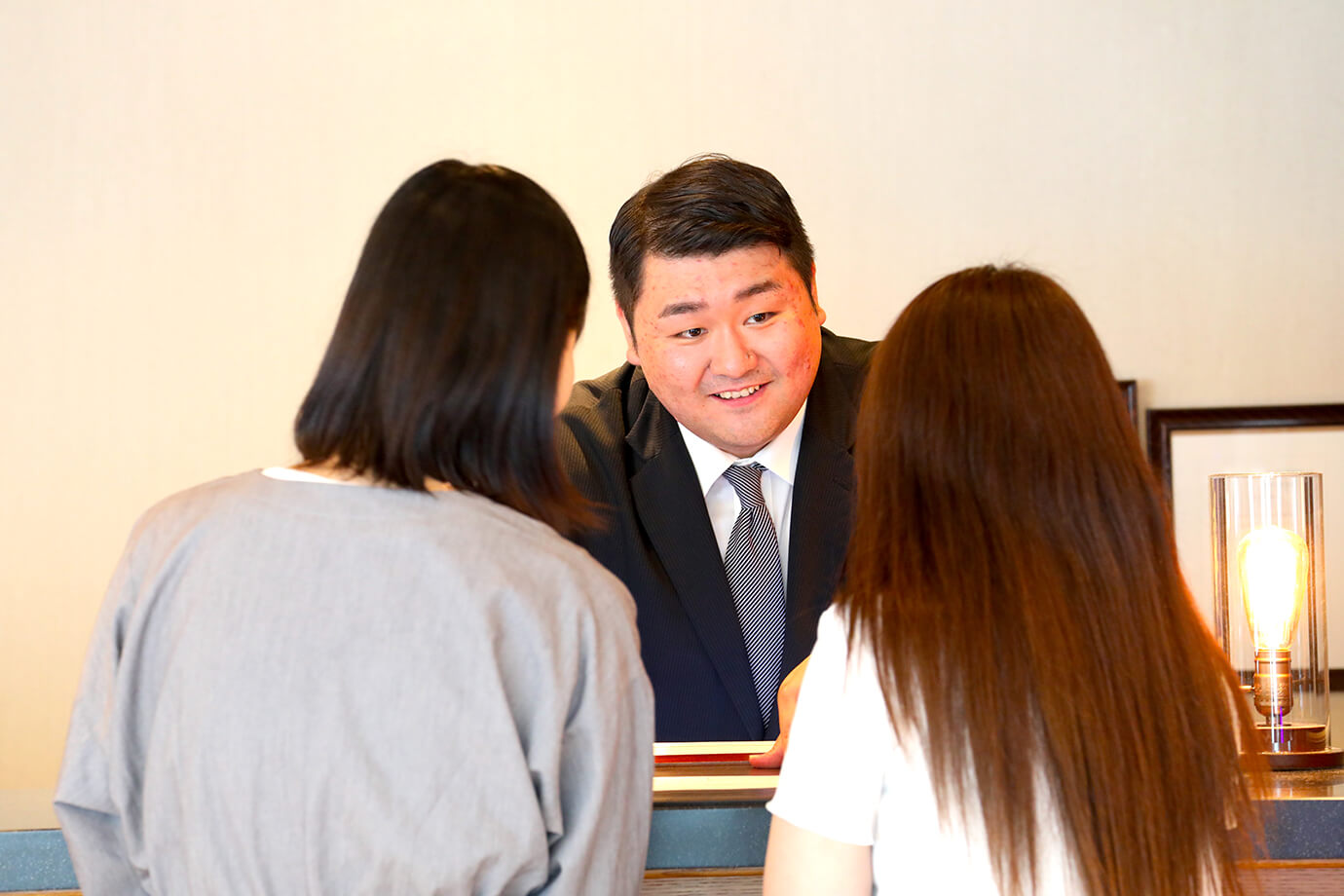
Hotel staff welcome guests at the reception desk on the first floor. Please ask if you have any questions, including about recommended sightseeing spots in the Sanriku Kamaishi area.
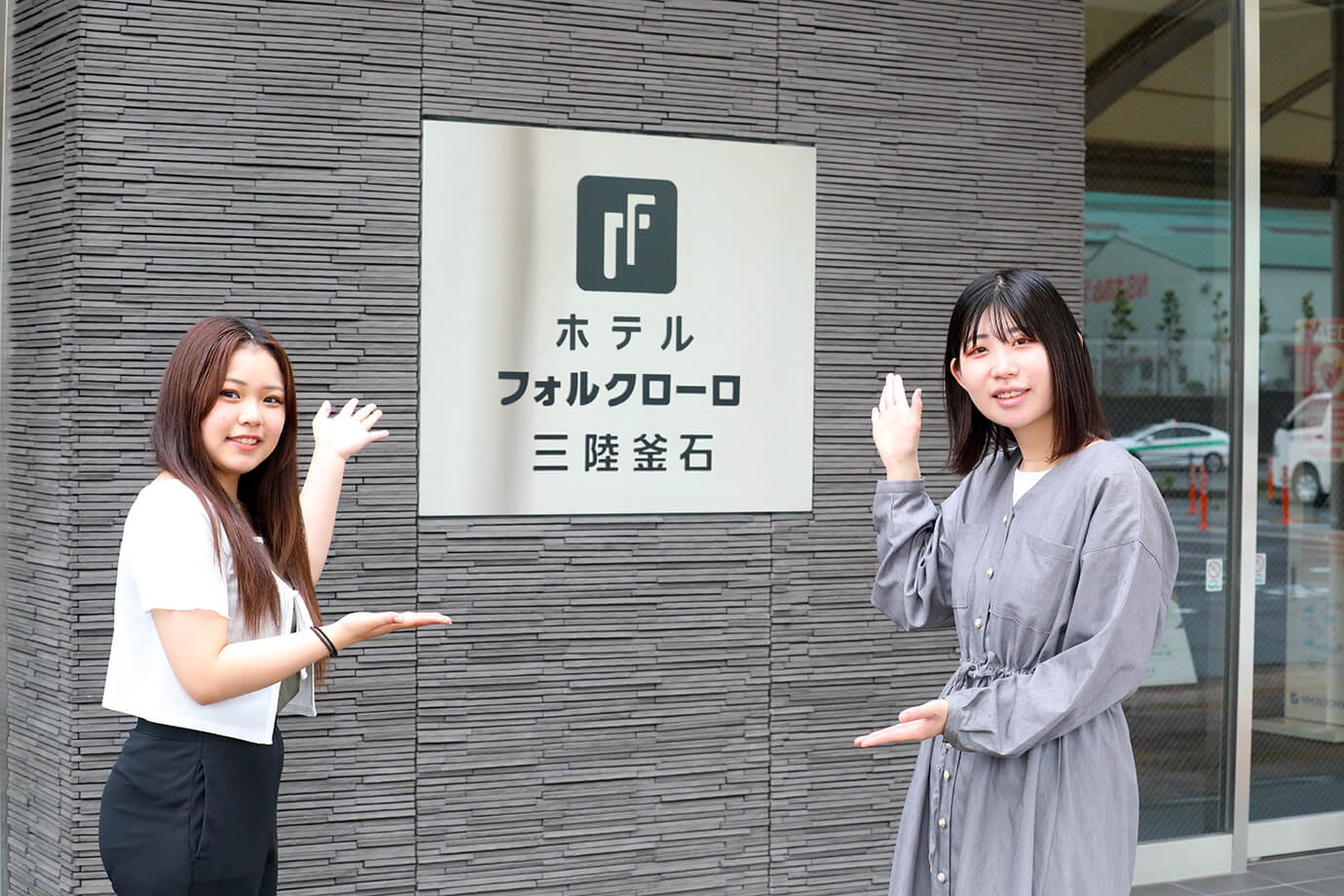
Some rooms have a view of the train, and the sound of the train running and whistle invites travelers to enjoy the feeling of travel. Depending on the season, accommodation plans in conjunction with local attractions and events are also available, so be sure to check them out.
Hotel Folkloro Sanrikukamaishi
Address:22-4 Suzuko-cho, Kamaishi City, Iwate Prefecture
Phone:0193-38-5536
Check-in:15:00
Check-out:11:00
Costs:Please refer to the official website.
Kamaishi Daikannon
See inside the Daikannon, a symbol of compassion and peace that watches over Kamaishi Port
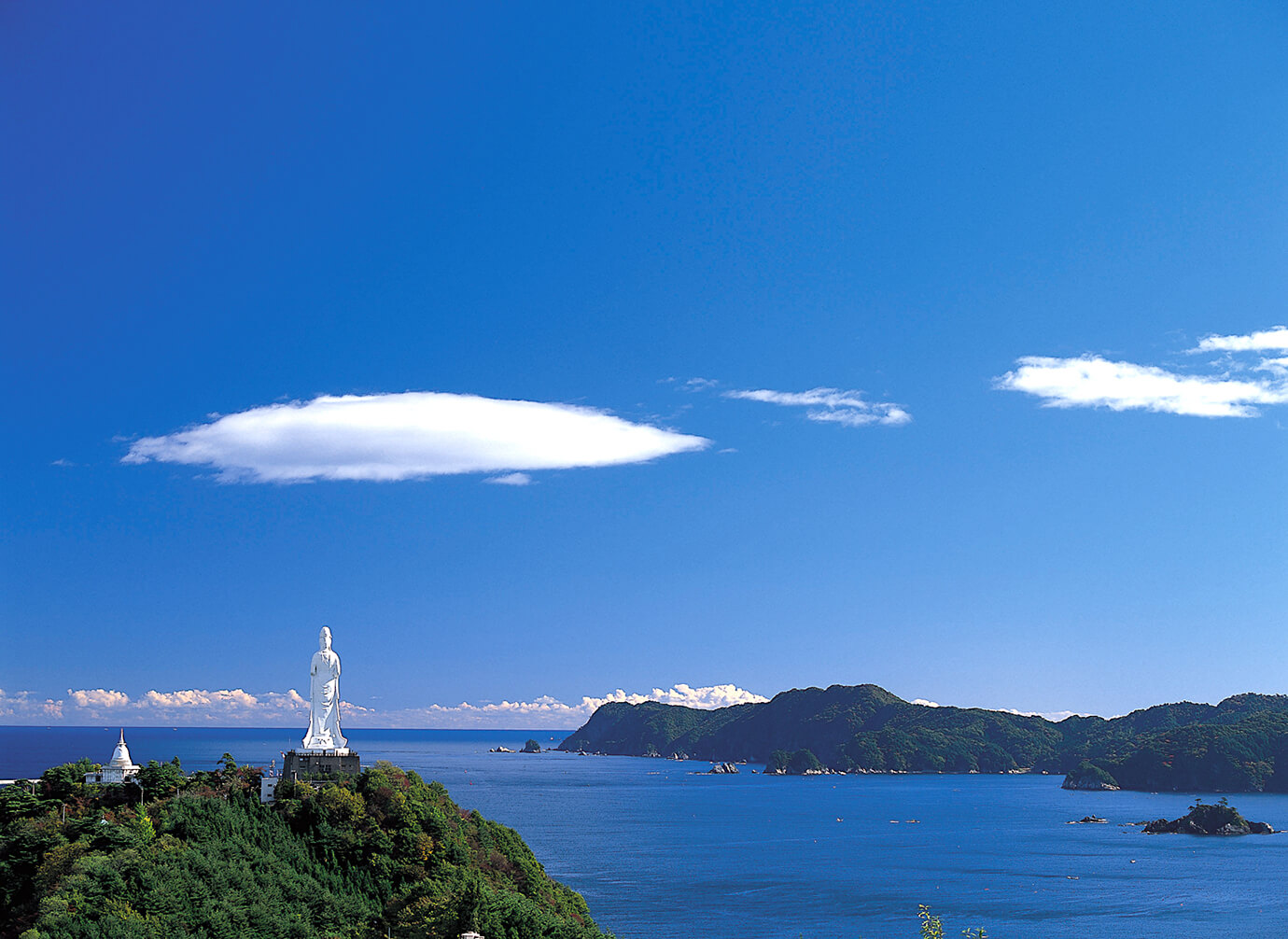
The "Kamaishi Daikannon" stands high on a plateau above the Kanasaki Peninsula in Odaira Town, and is a symbol of Kamaishi. Erected in 1970, this 48.5-meter-high statue of Gyoran Kannon holds a fish in both hands.
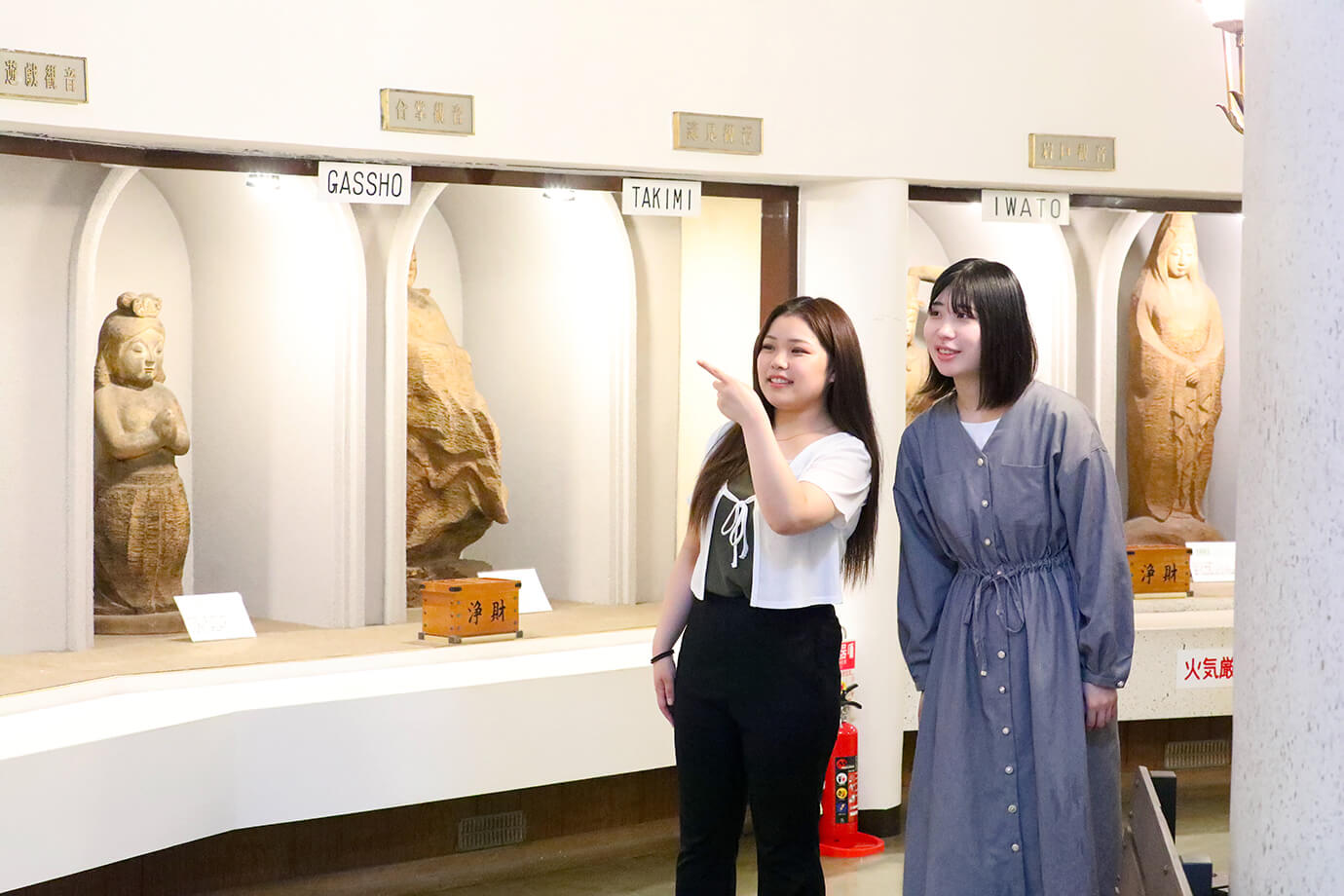
The interior of Kamaishi Daikannon has 12 floors, with the main deity enshrined in the worship hall on the second floor, "Sanjusan (33) Kannons" on the third floor, and "Sentai (1,000) Kannons" on the fourth through thirteenth floors, enabling visitors to see various Kannons as they tour the interior of the statue.
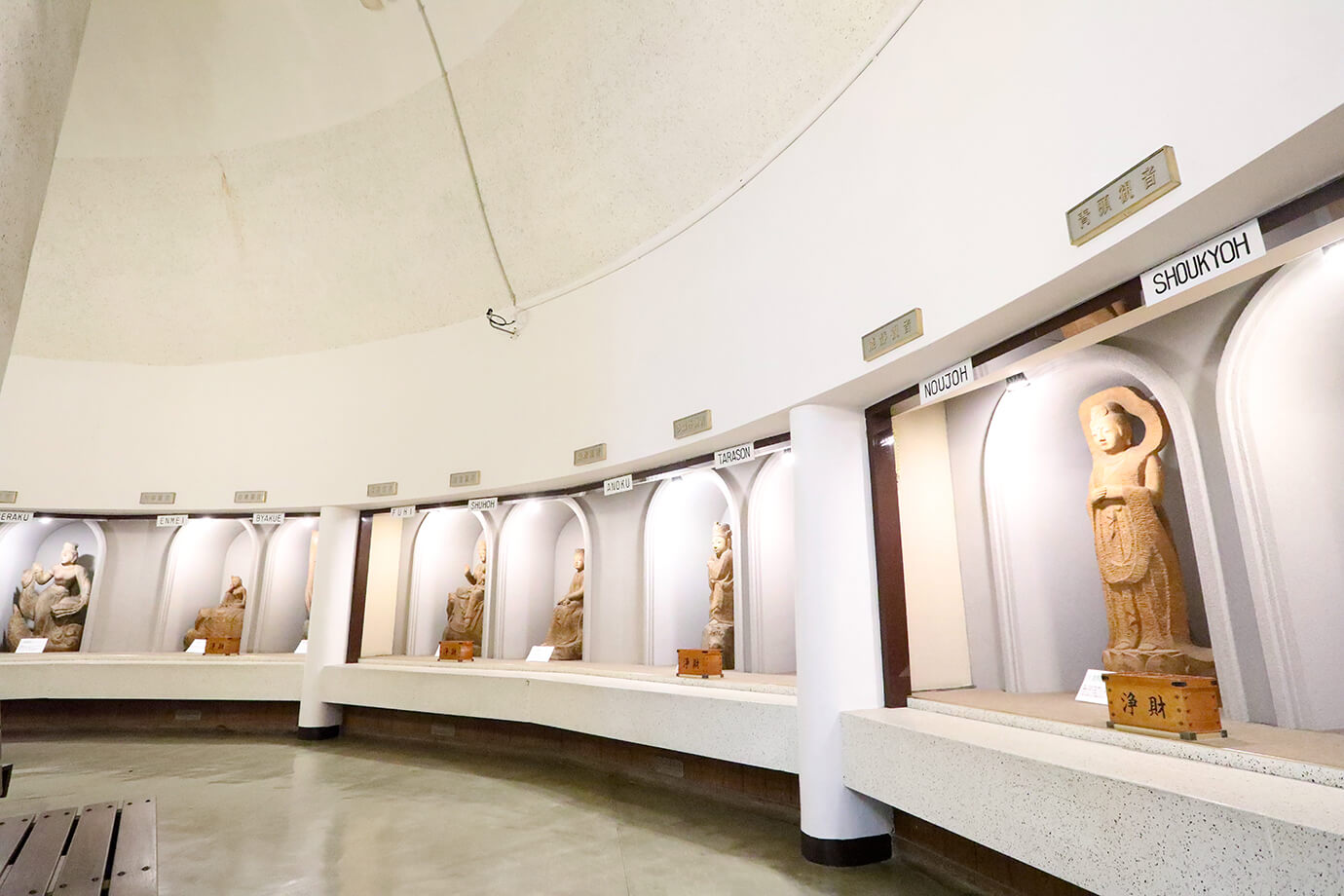
On the third floor, there is a display of 33 Kannon statues by Buddhist sculptor Ko Hasegawa, which were carved from a single piece of camphor wood using the nata (hatchet) carving technique.
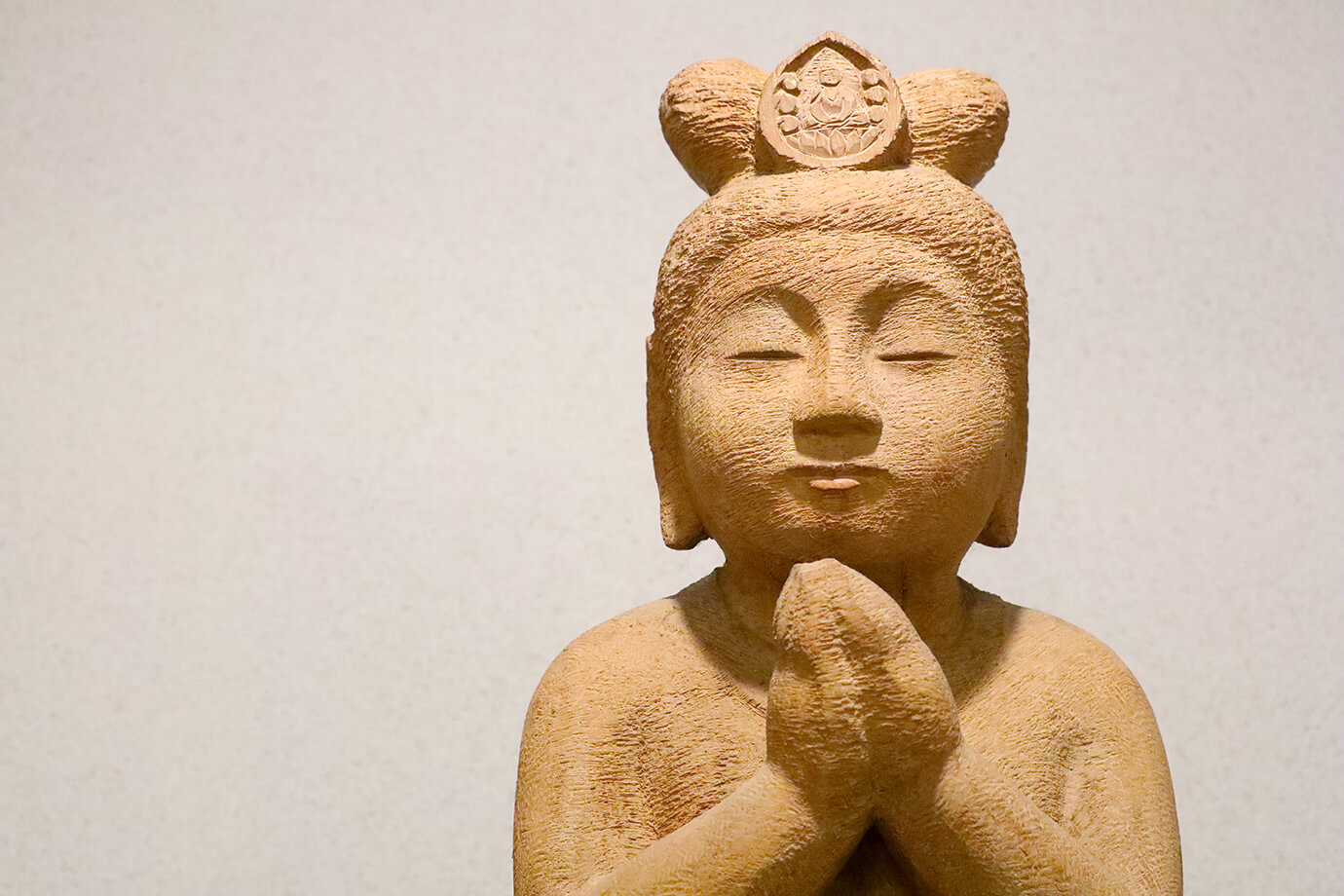
“Renga Kannon,” named because the Kannon sits on a lotus flower on a pond. The Kannon is represented in the form of a young girl, and her gentle expression is soothing.
Panoramic view of a ria coast from the observation platform 120m above sea level
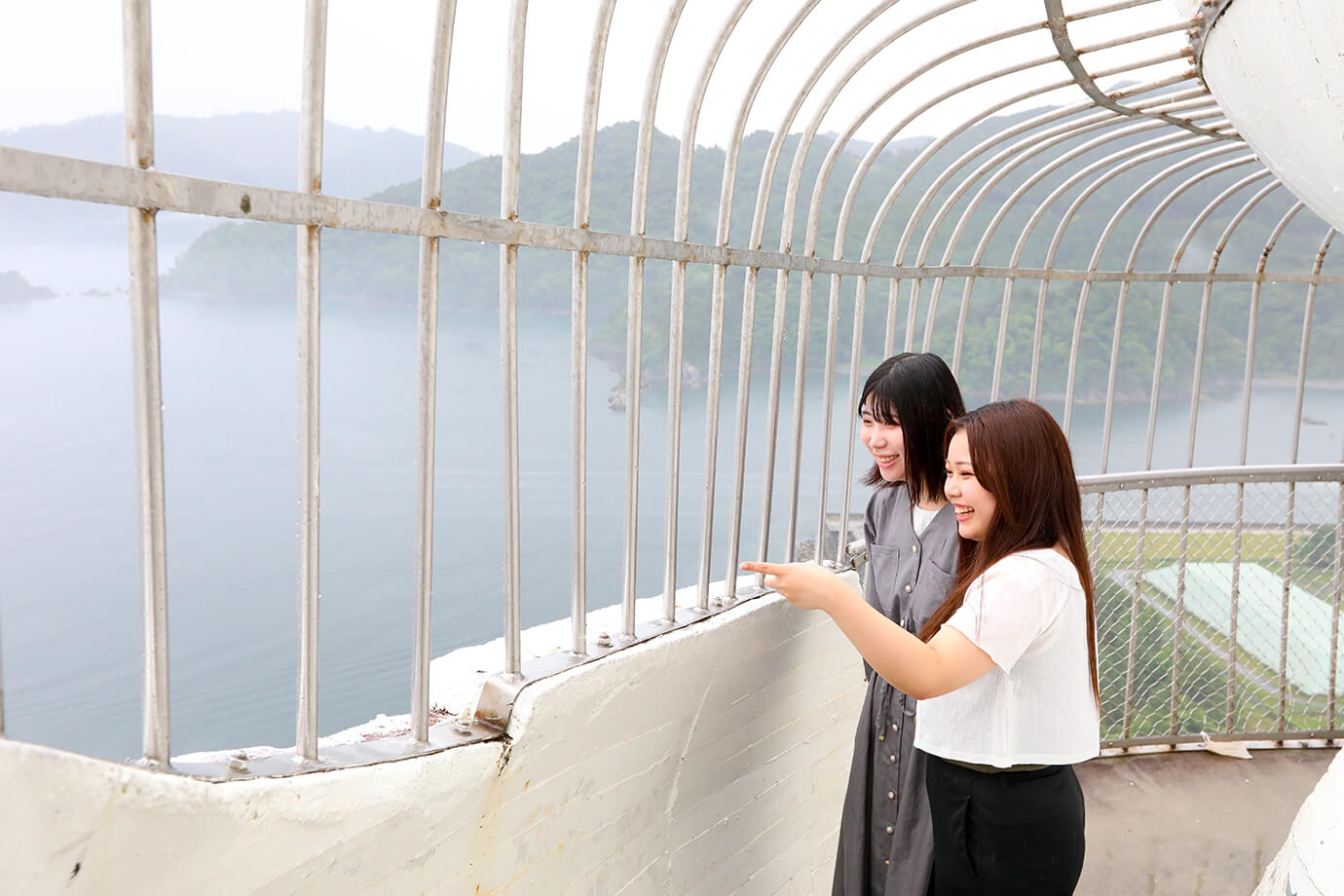
The 11th and 12th floors are the “Gyoran Observation Deck.” Located 120 meters above sea level, it is so high that it almost makes us feel weak at the knees. On a clear day, you can see as far as Mada Cape and Ozaki Peninsula beyond Kamaishi Bay.
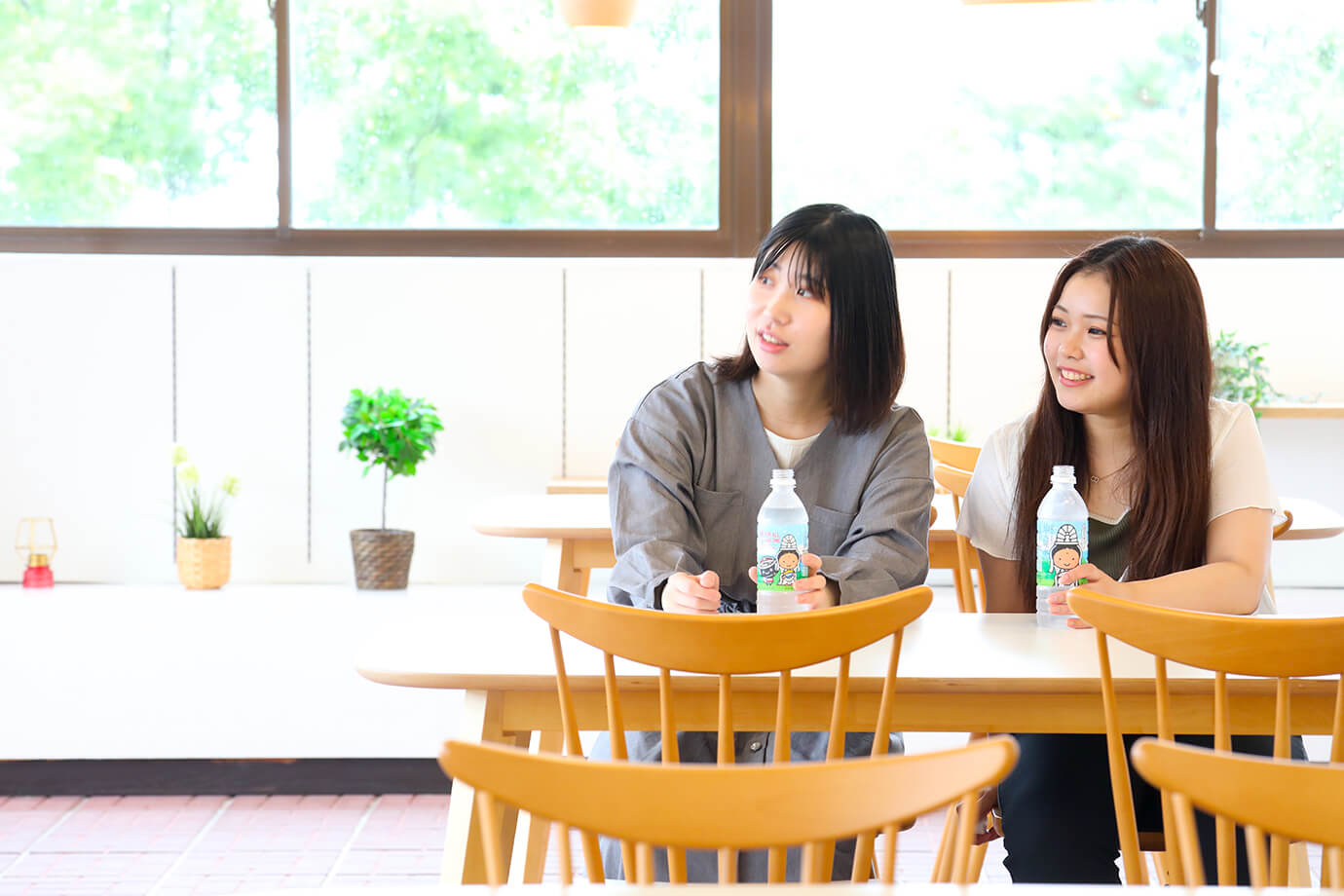
Next to Kamaishi Daikannon, there is the "FUDARAKU" store and a rest area for a short break after the tour of the inside of the statue. It is a comfortable space with a view of Kamaishi Bay from behind large glass windows.
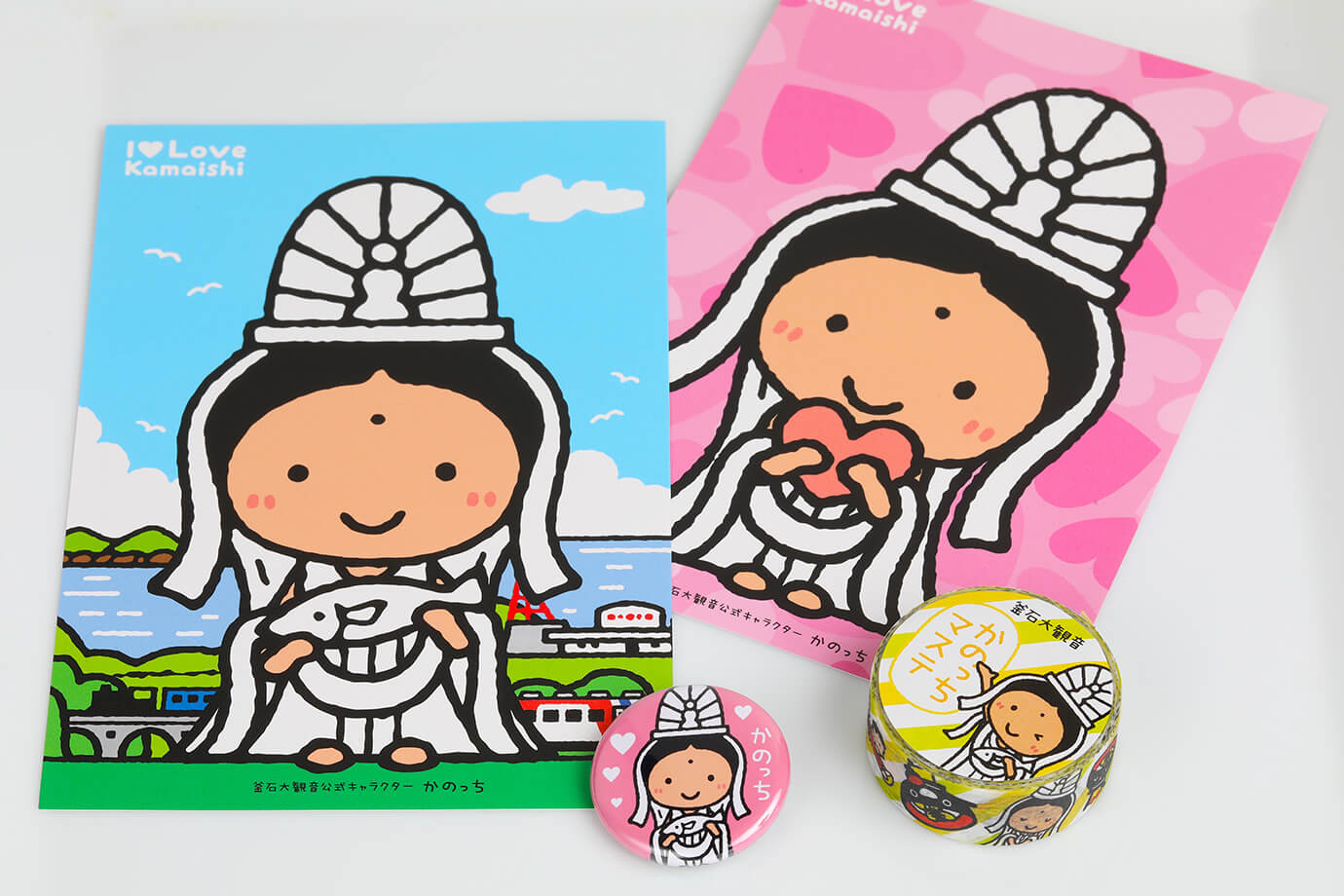
The store sells good luck charms, red seal books, and original "Kanocchi" character goods. How about a cute “Kanocchi postcard” for 250 yen, “Kanocchi masking tape” for 350 yen, or a “Kanocchi button badge” for 150 yen to remember your visit?
Kamaishi Daikannon
Address:3-9-1 Odaira-cho, Kamaishi City, Iwate Prefecture
Phone:0193-24-2125
Costs:500 yen (adults)
Hours:9:00 to 17:00 (varies depending on the season)
Closed:Open every day
Unosumai Tomosu
Learn skills to protect your life from disasters that could happen at any time
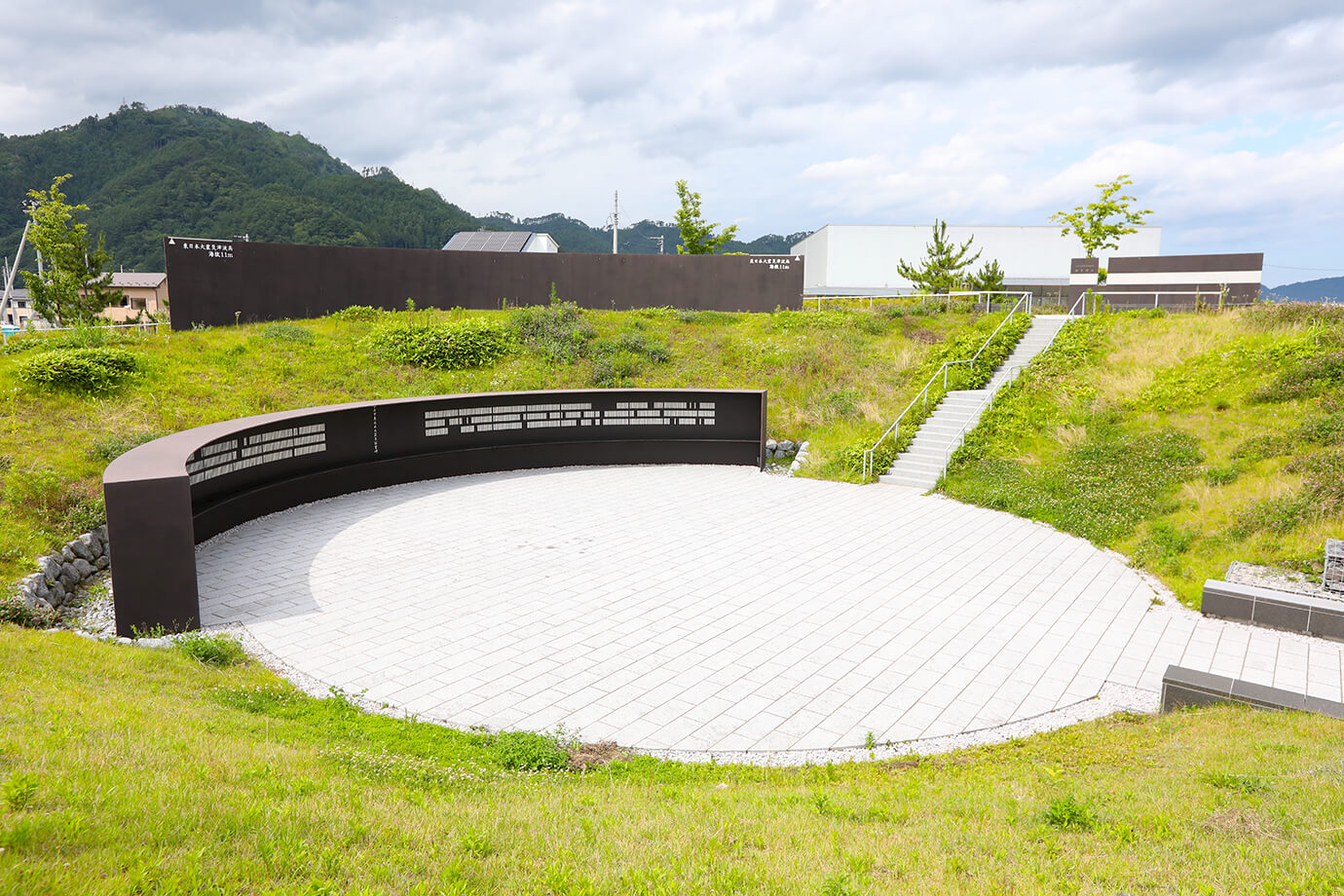
Kamaishi City is often affected by tsunamis, and suffered tremendous damage from the tsunami caused by the Great East Japan Earthquake. “Unosumai Tomosu,” located in front of Unosumai Station on the Sanriku Railway, is a public facility built to pass on the memories and lessons of the Great East Japan Earthquake to future generations, as well as to provide a place to relax and feel the importance of life.
The photo shows the “Kamaishi Memorial Park,” which commemorates and memorializes the victims of the Great East Japan Earthquake.
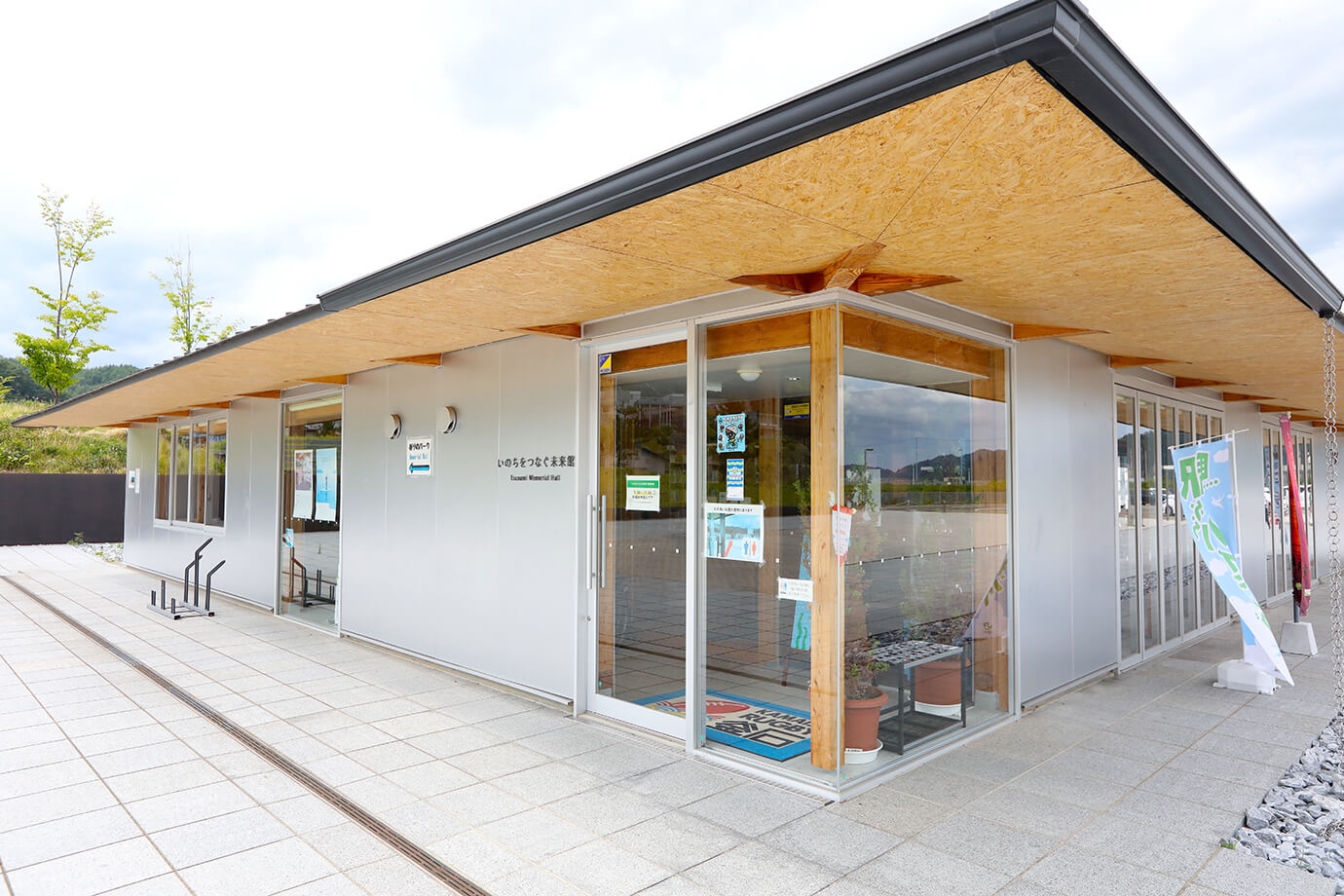
There are three facilities at the site: the “Tsunami Memorial Hall,” “Unosato Visitor Center,” and “Kamaishi Memorial Park.” We first visited the “Tsunami Memorial Hall,” which aims to teach the events and lessons of the earthquake and tsunami, and to support learning about disaster prevention in order to protect lives from disasters.

The exhibition room introduces the tragedy that occurred as a result of the Great East Japan Earthquake, as well as the measures taken afterwards and lessons learned.
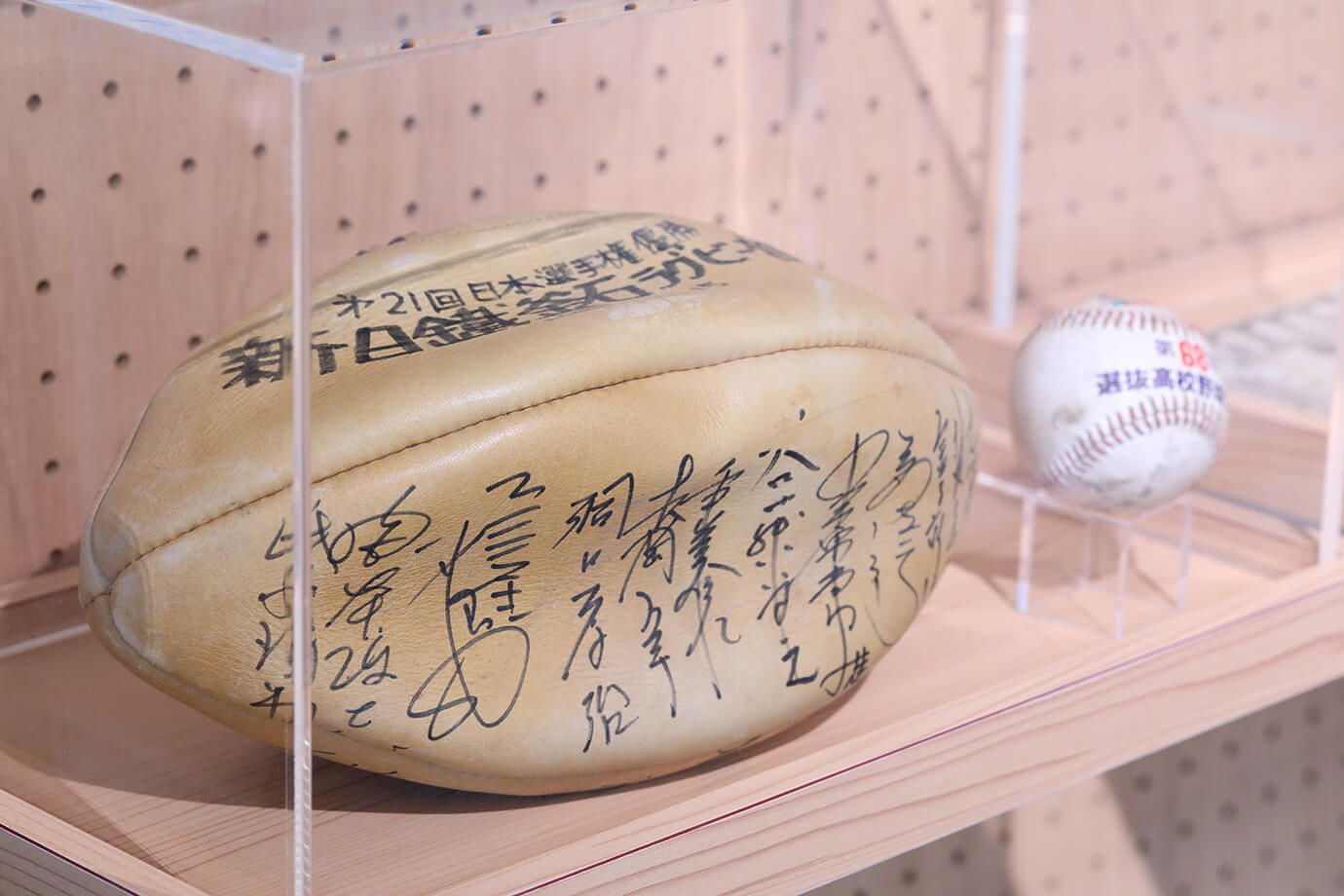
A rugby ball that was found after being washed away by the tsunami. You can see autographs of members of the Nippon Steel Kamaishi Rugby Club (at that time).
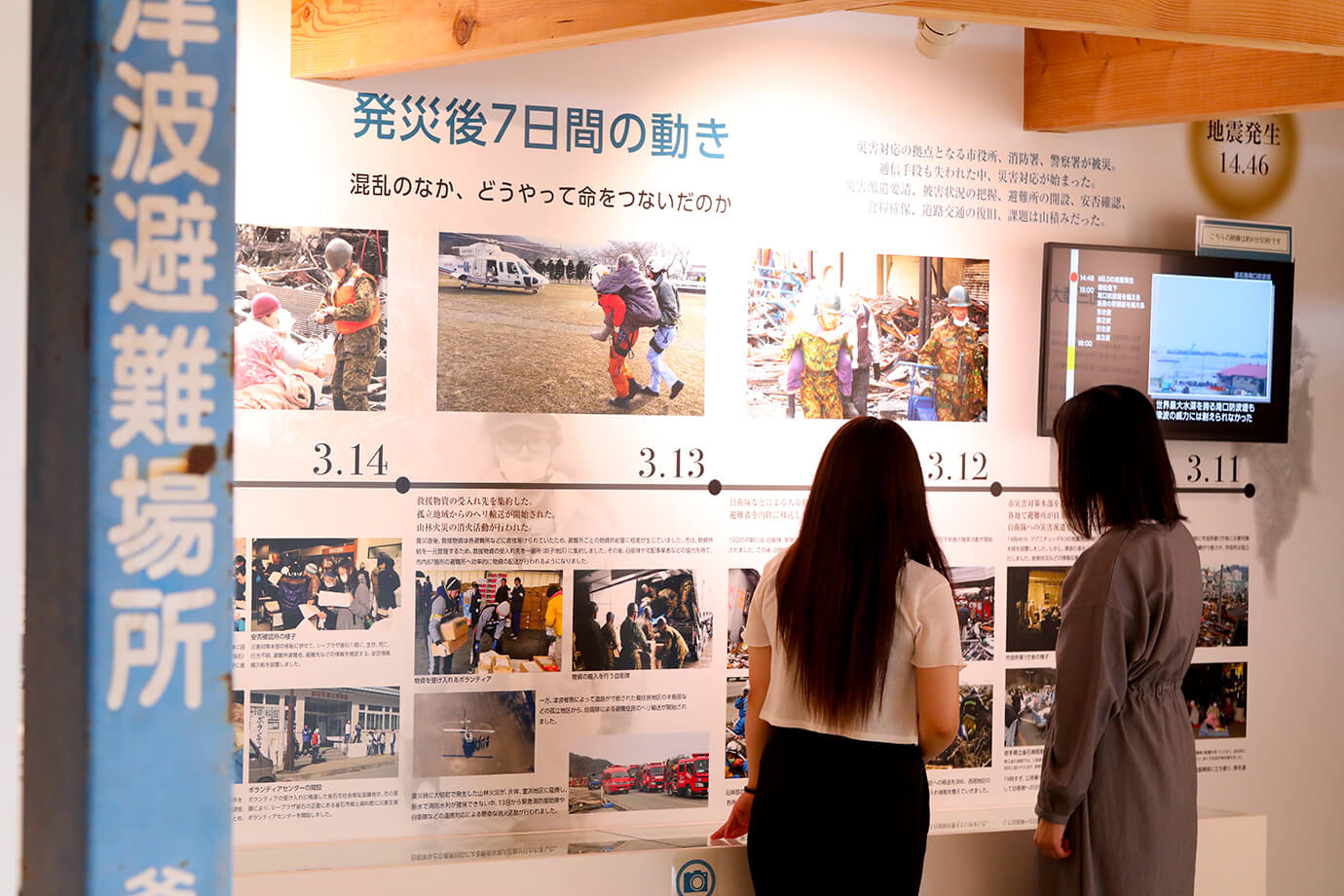
Panels and videos show how people actually survived in the immediate aftermath of the earthquake, when the city hall, fire station, and police department were all damaged. The “Tsunami Memorial Hall” also offers explanations of the exhibits in the hall by narrators who experienced the disaster, on-site experience programs, etc.
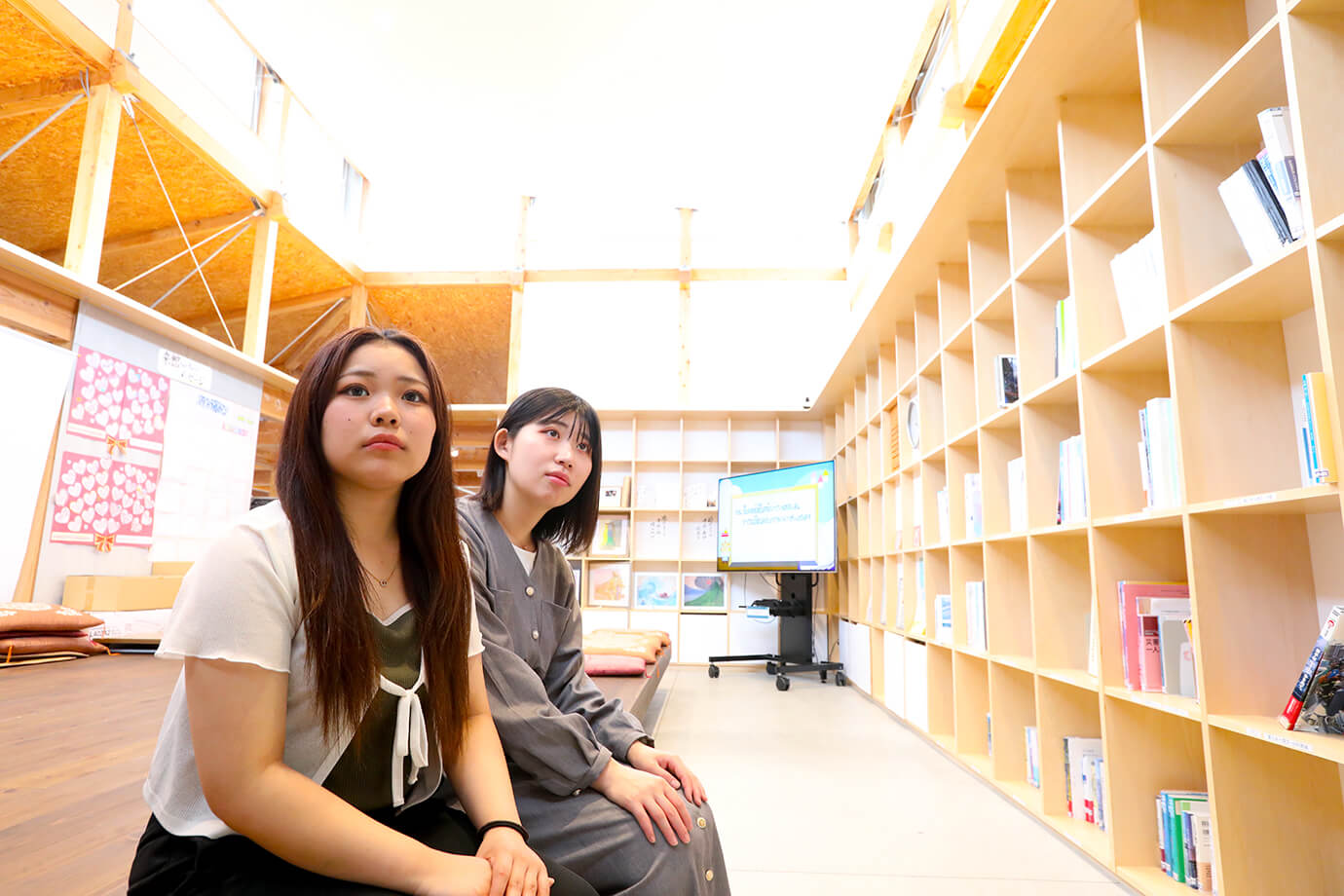
In the reading room, there are books and materials related to the Great East Japan Earthquake, as well as donated photographs, etc., and they are freely available for viewing.
Gourmet foods and specialties from Unosumai and Kamaishi are also available
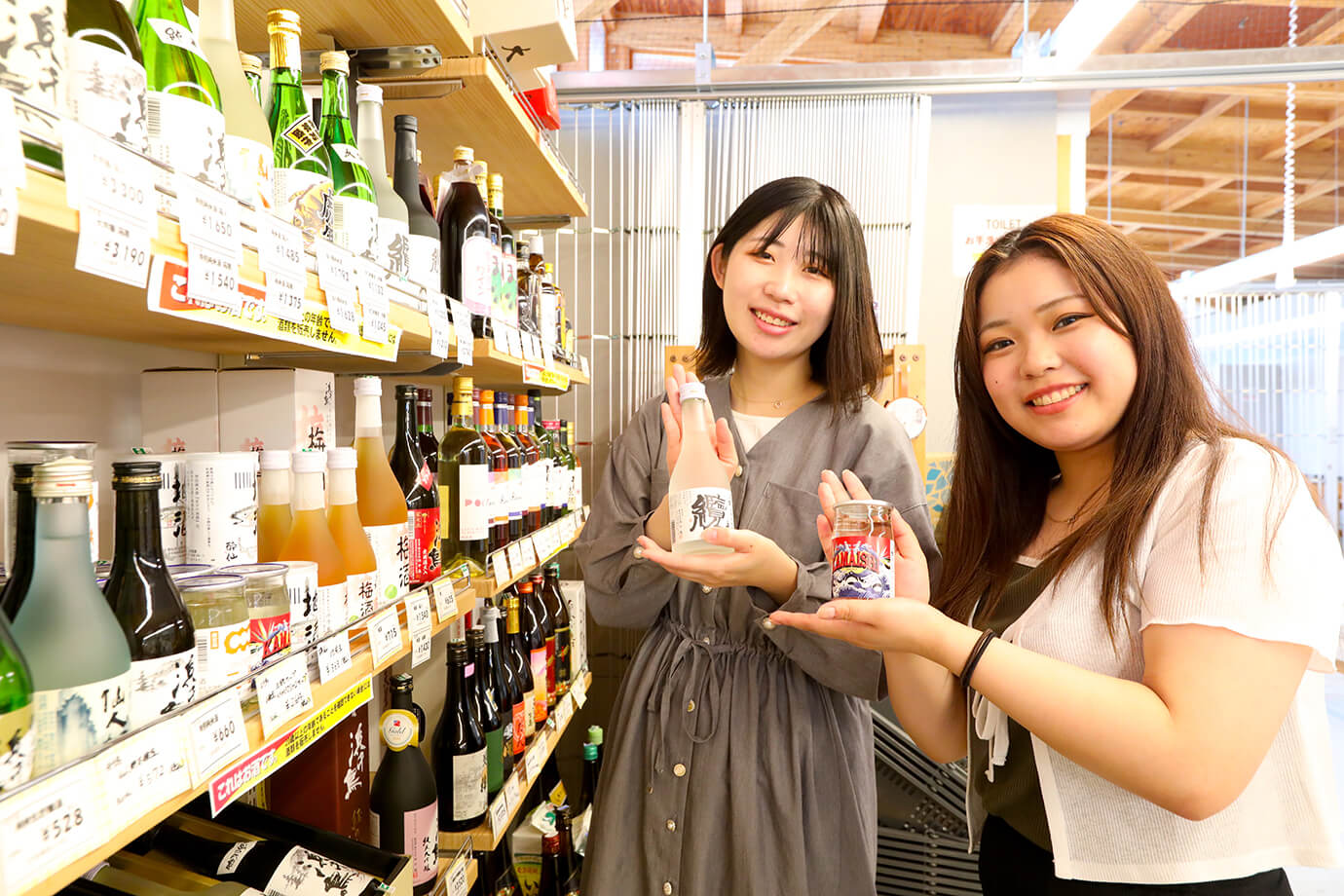
At the “Unosato Visitor Center,” there are facilities such as a restaurant, eating and drinking area, and store, all of which convey the charm of Kamaishi. “Nomura Shoten,” located inside the visitor center, offers a wide selection of local souvenirs, including Kamaishi snacks, sake, and gifts.
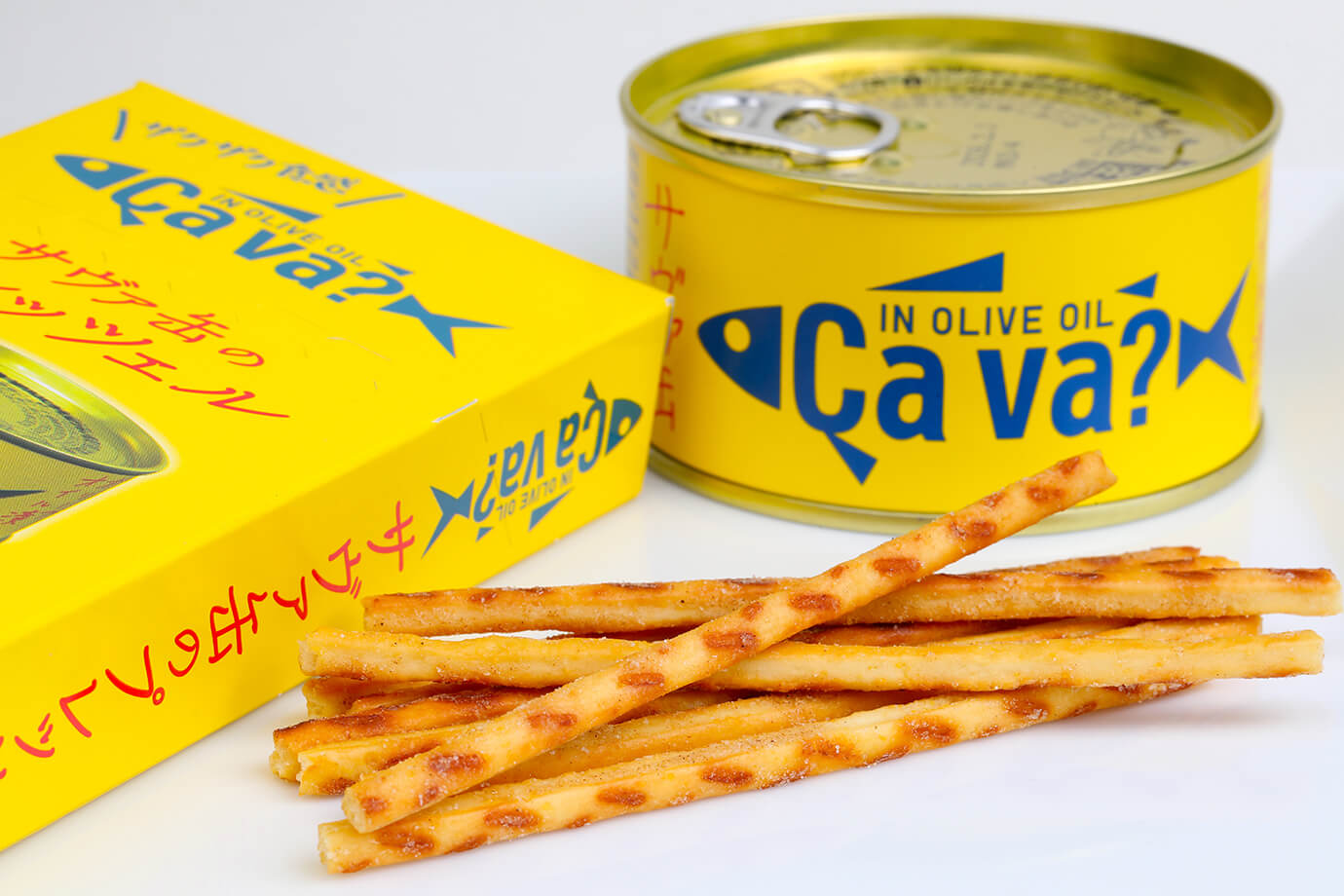
The “Ça va? Can,” is a Western-style canned product that uses Japanese mackerel. It costs 520 yen, and was conceived as a way to introduce an original brand of processed products from the Sanriku area, which was affected by the earthquake and tsunami. The new “Ça va? Can Pretzel” (250 yen) is also popular.
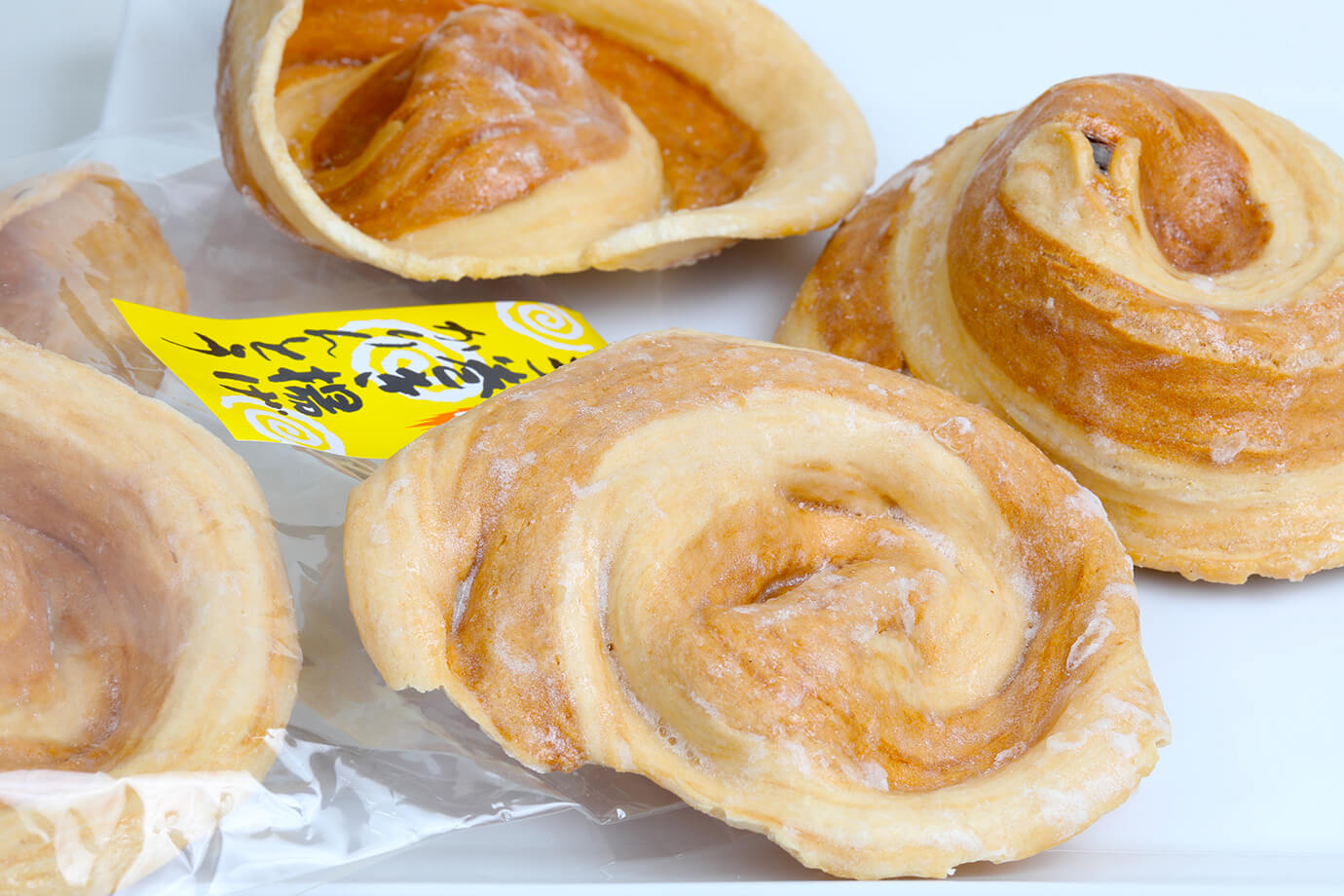
Palm-sized "hand-rolled fried karinto" cost 500 yen, and are available in two varieties: white sugar and brown sugar. They have a unique curly shape, and are not overly sweet.
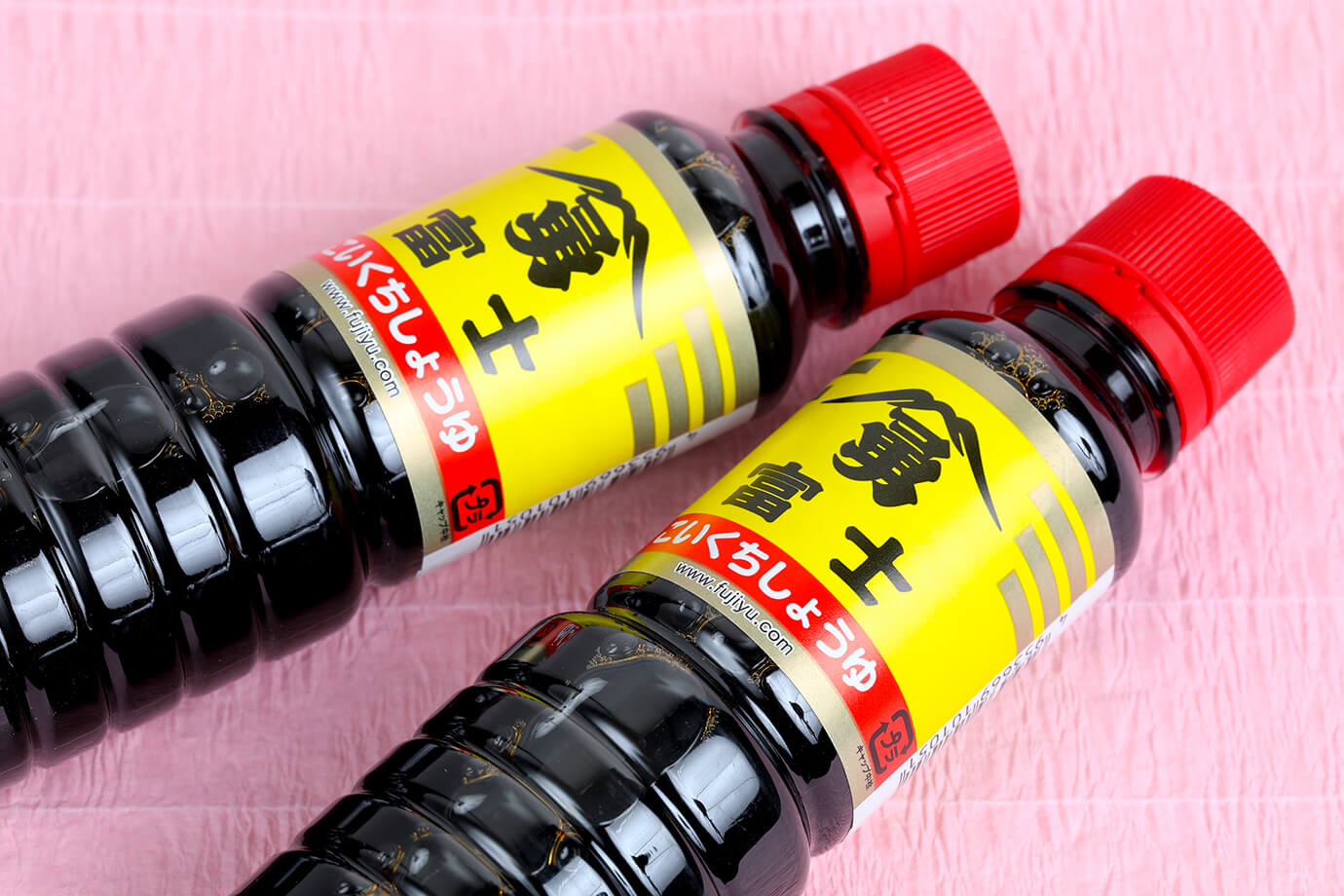
“Koikuchi soy sauce" from the local Fujiyu Jyouzou Brewery costs 170 yen for 108ml. It is mellow and has a sweet and savory taste that is hard to believe it is soy sauce. The small bottle makes a perfect souvenir.
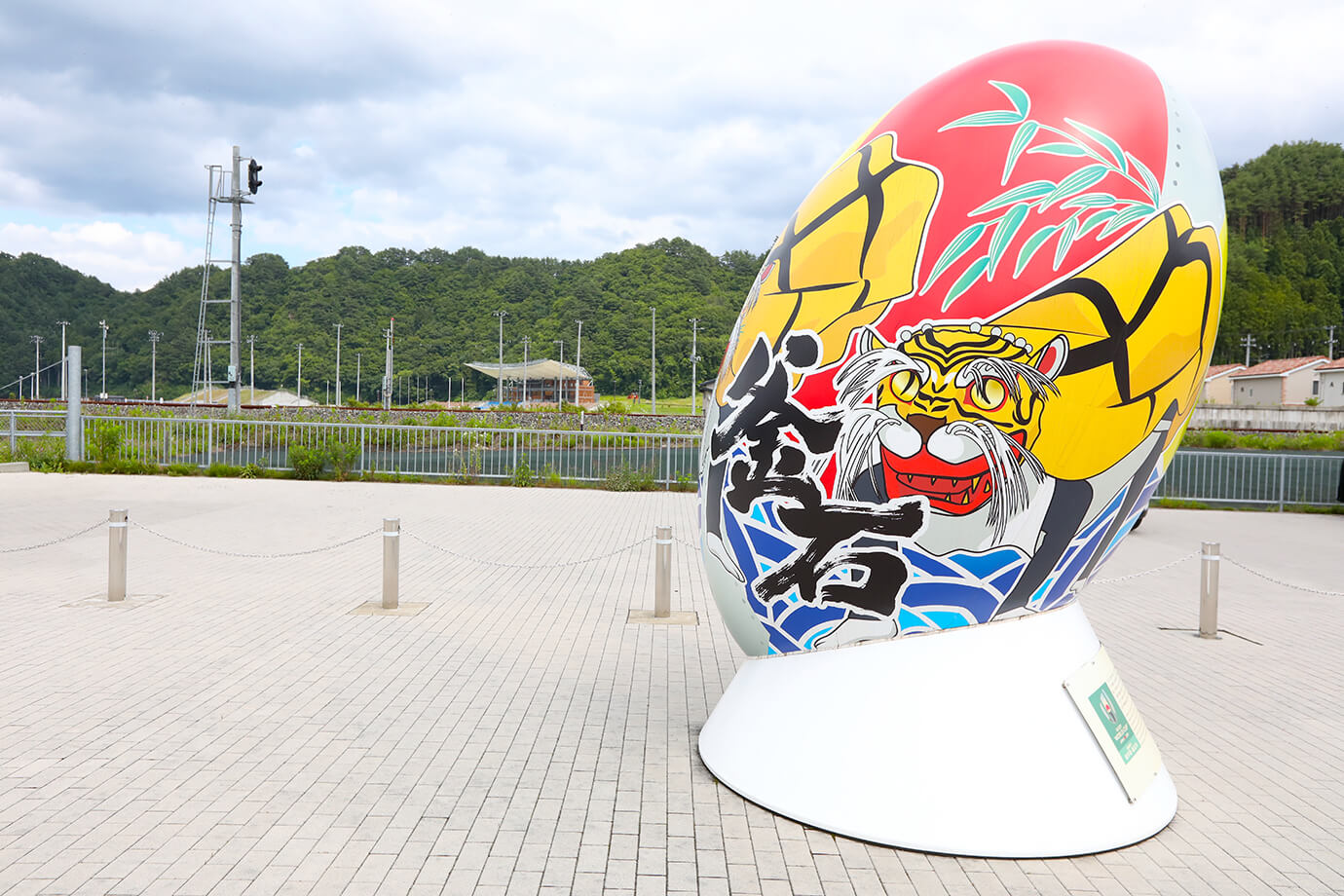
There is a rugby ball-shaped monument at one corner of the site. In the nearby “Memorial Park,” there is a monument representing the height of the tsunami from the Great East Japan Earthquake (11 meters above sea level) and the Memorial Monument to the Great East Japan Earthquake. Knowing that our daily lives are not taken for granted, what can we do to protect our loved ones? It is a valuable place where many lessons can be learned.
Unosumai Tomosu
Address:4-901-2 Unosumai-cho, Kamaishi City, Iwate Prefecture
Tel:0193-27-5666 (Tsunami Memorial Hall)
Costs:Free admission
Hours:9:00 to 18:00
Closed:Wednesday, Year-end and New Year periods
Tsunami Memorial Hall
Hours:9:30 to 17:30 (9:30 to 17:00 from November to February)
HIKARI SHOKUDOU
Extremely fresh food! Taste all the delicacies of Sanriku's seafood in a kaisendon bowl
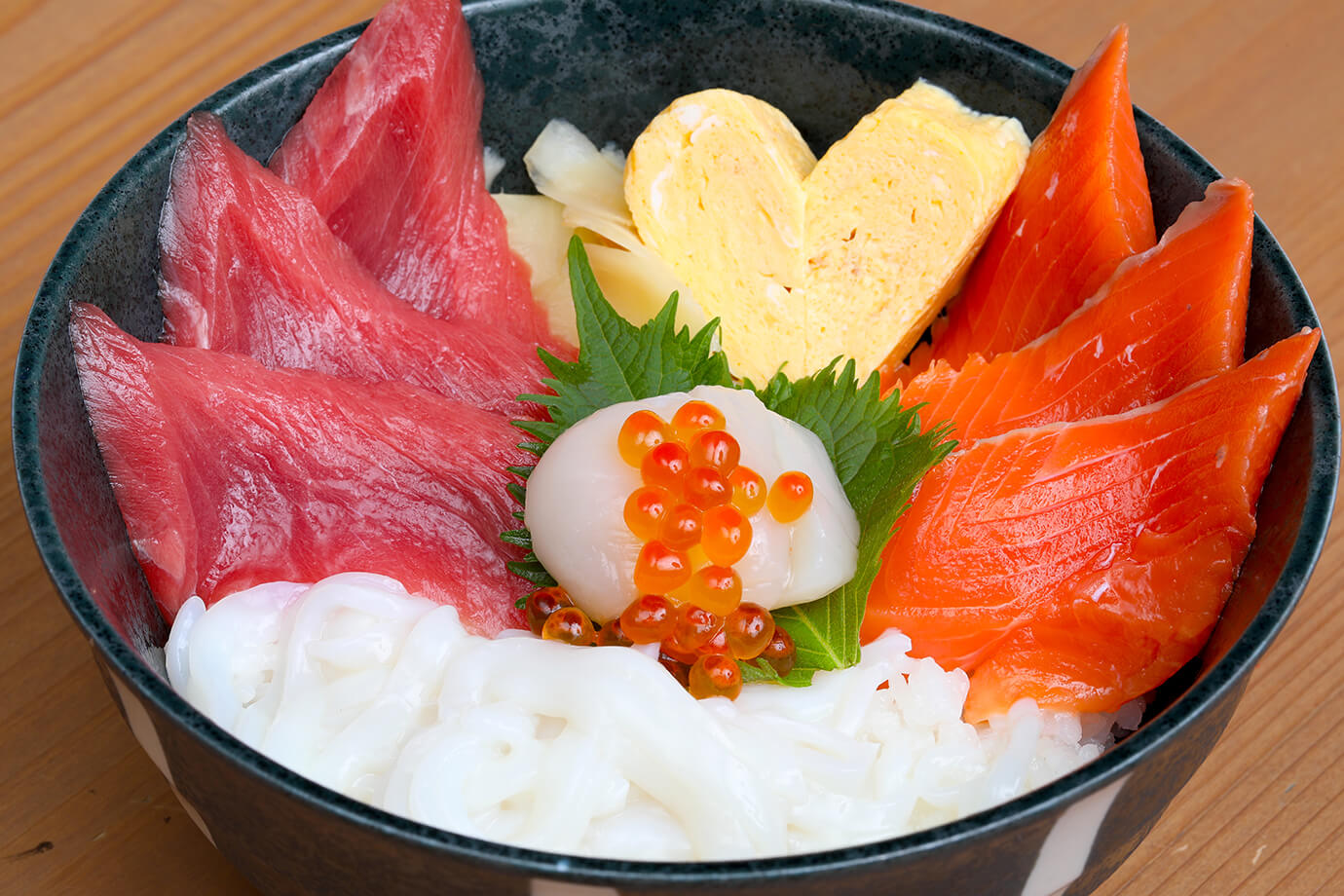
UOGASHI Terrace stands overlooking Kamaishi Bay. There are four restaurants on the second floor, where visitors can enjoy a meal while looking at a refreshing ocean view. “HIKARI SHOKUDOU,” operated by a local seafood processing company, is highly acclaimed for its dishes featuring fresh seafood. For 2,500 yen, the “kaisendon bowl (lunch)” includes generous portions of tuna, salmon, squid, and other ingredients, and is served with miso soup and a small side dish.
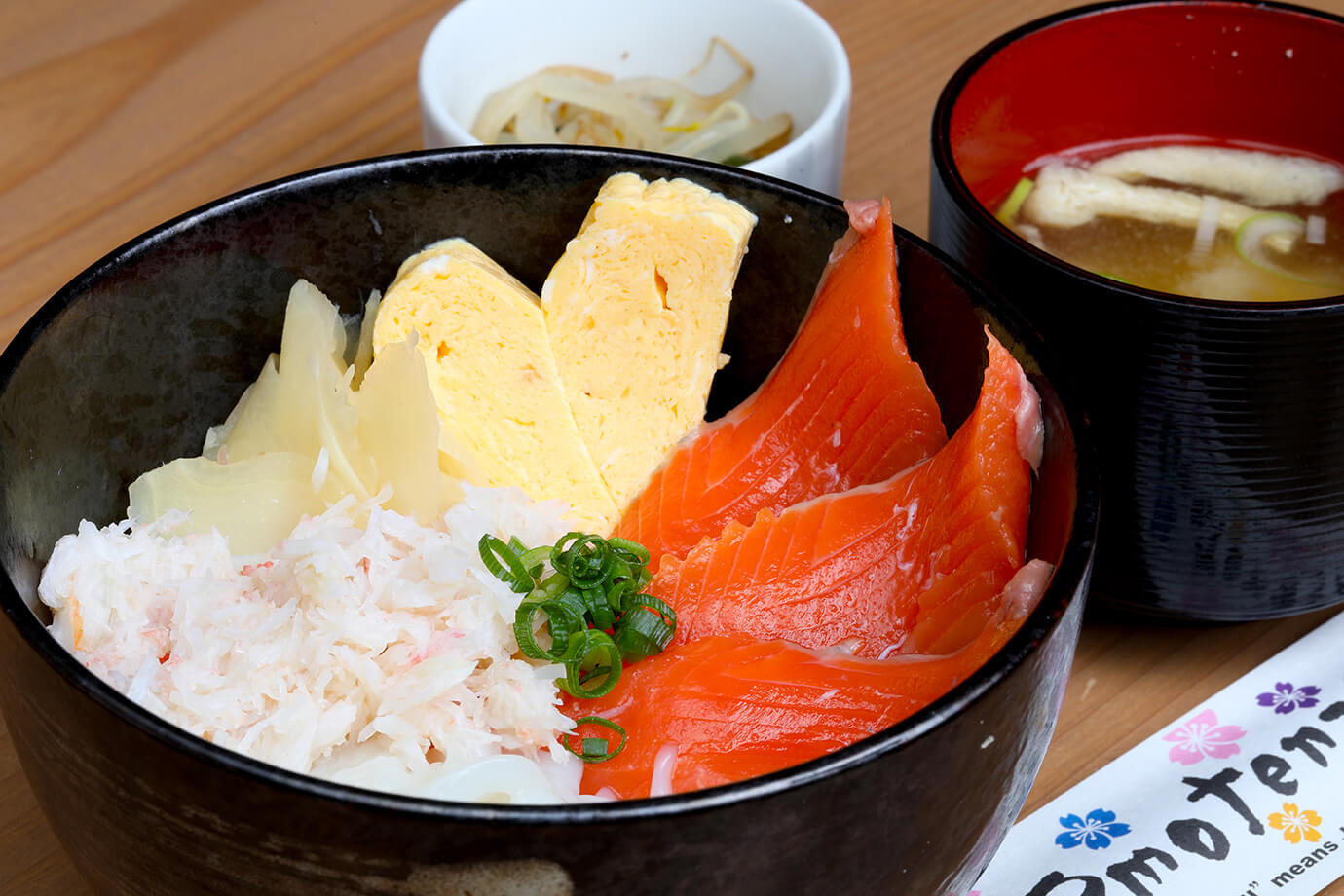
For 1,800 yen, the "sanshudon (three kind bowl) (lunch)" is a gorgeous meal consisting of rice topped with “Yamada salmon” farmed in fish tanks floating in the sea in nearby Yamada Bay, as well as squid, crab, and egg!
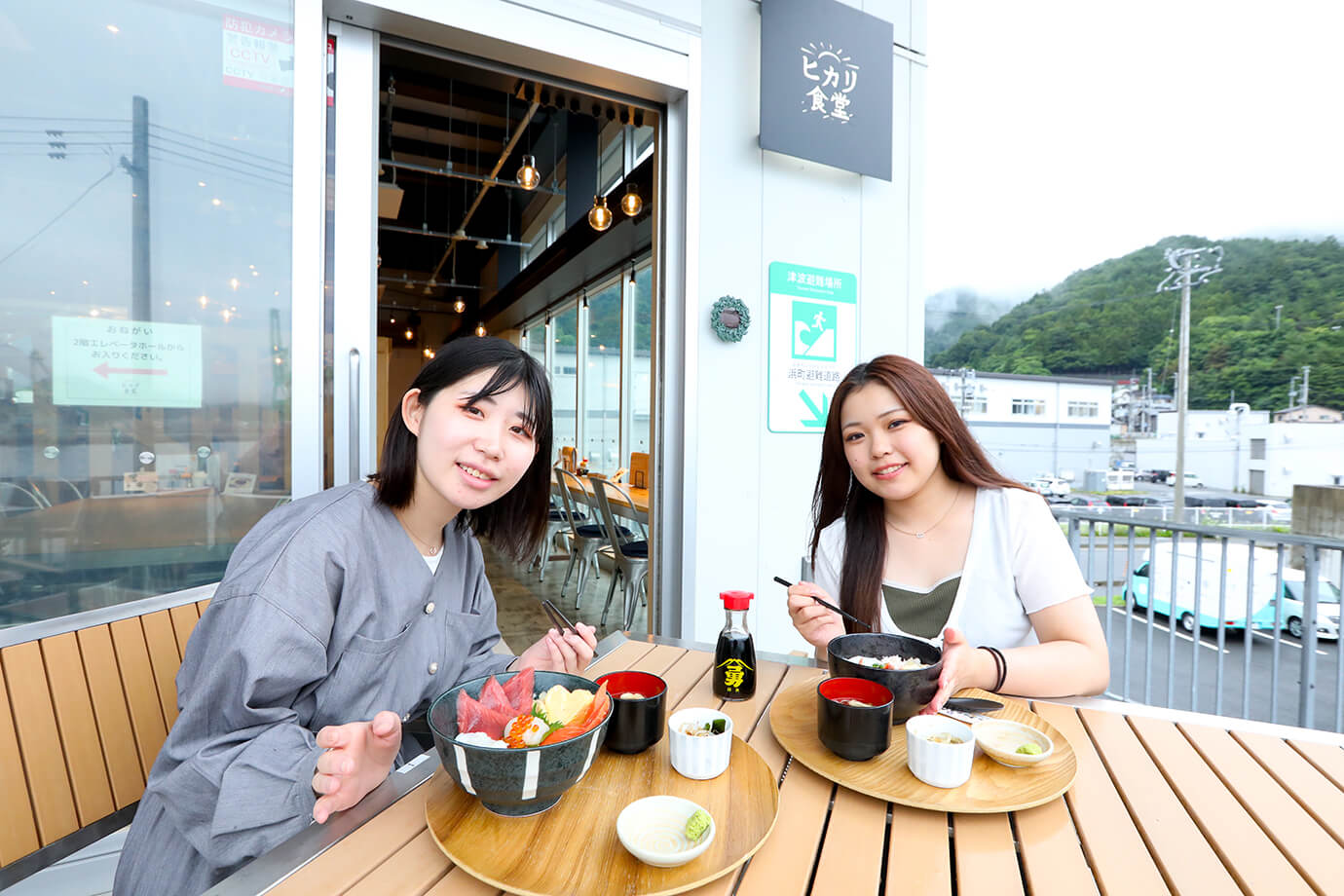
Visitors with pets can use the terrace seating, where they can feel the sea breeze.
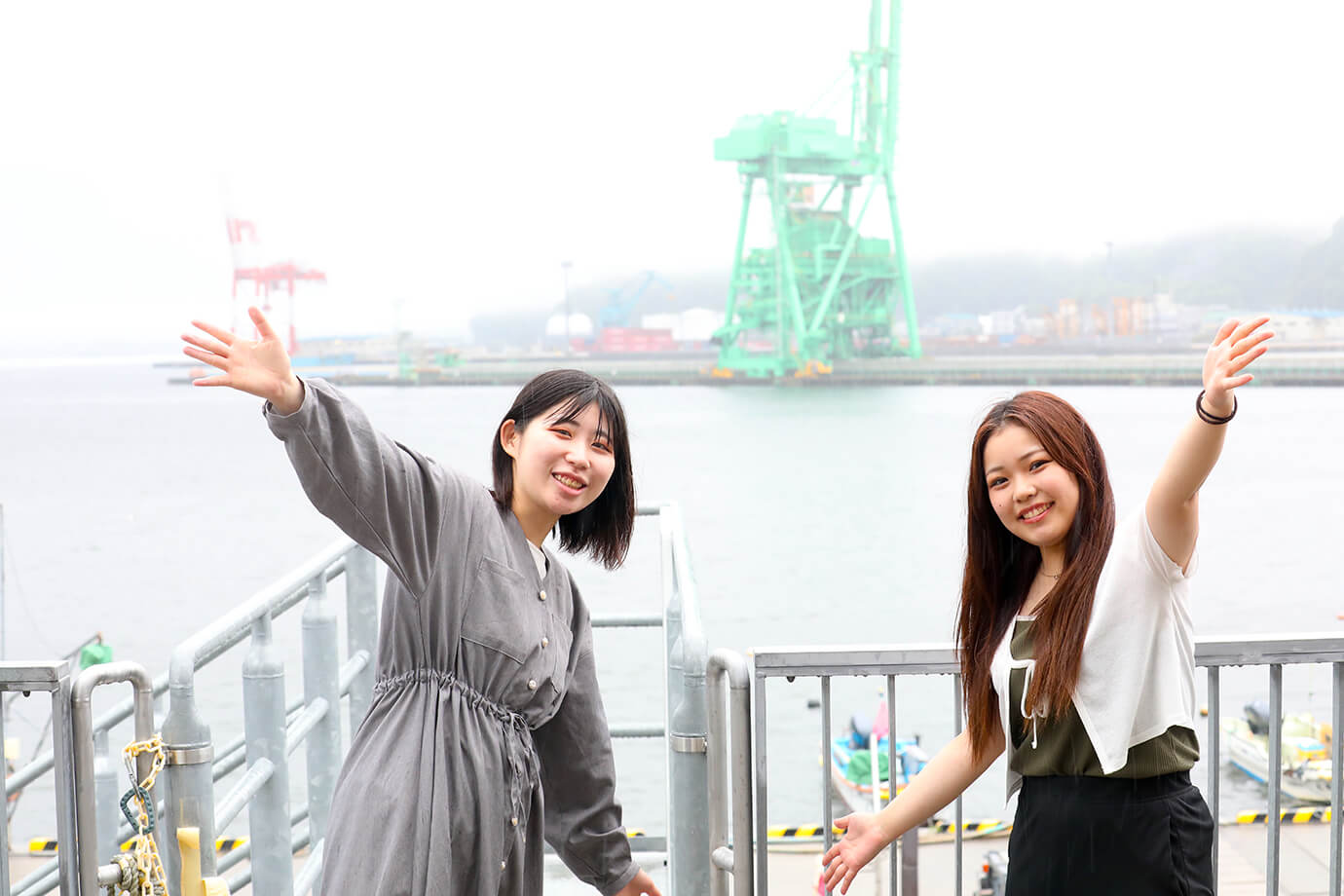
The restaurant prides itself on its use of completely locally sourced rice, vegetables, and seasonings. Enjoy Kamaishi's seafood in a refreshing dining area with the ocean right in front of you.
HIKARI SHOKUDOU
Address:3-3 Uogashi, Kamaishi City, Iwate Prefecture
Phone:0193-27-7475
Hours:11:30 to 14:00, 17:30 to 21:00 (Sundays: 11:30 to 14:00)
Closed:Monday and Sunday evening
Yatai Ramen Kawashima
Generous serving of boiled offal! A fresh new style of ramen that you eat in a bus stall
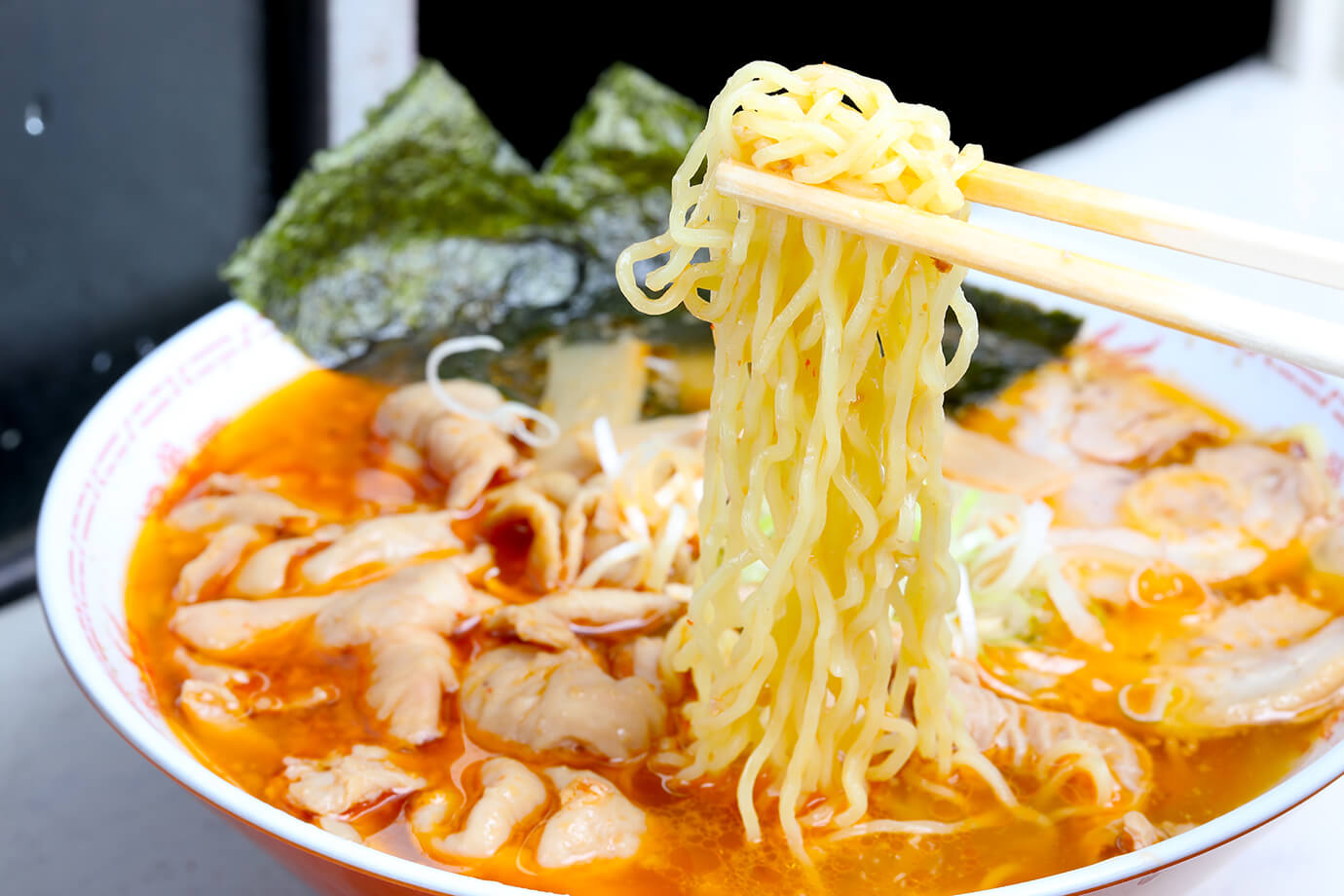
Kaisendon is good, but if you want a more casual lunch, go to “Yatai Ramen Kawashima.” Kawashima Meat Center, founded in 1978, established bus ramen, a mobile restaurant vehicle, as a new business. Currently, it is parked along Route 285, where it sells specialty ramen. For 850 yen, the specialty "offal ramen" is a slightly spicy ramen with tender offal and chashu pork. Medium-thick noodles are coated in a thick broth.

There is counter seating at the front of the bus. At the back of the bus is the kitchen, where the master takes orders and cooks everything by himself. We also recommend the simple "Chinese ramen" for 600 yen.

Isn't it exciting just to be able to eat on a bus? A little cramped, but delicious! Be sure to try Kamaishi's famous bus ramen.
Yatai Ramen Kawashima
Address:3-6-13 Matsubara-cho, Kamaishi City, Iwate Prefecture
Phone:0193-23-0656
Hours:10:00 to 15:00
Closed:Sunday, and other irregular holidays
Michi-no-Eki Kamaishi Sennin-Toge
Kasshi persimmons are also a specialty in the fall. Enjoy the bounty of nature in Kamaishi

This Michi-no-Eki is located at the western gateway to Kamaishi City, and is surrounded by nature along the Katsushi River. It sells specialty products unique to Kamaishi, including “Kasshi persimmon,” a specialty of the Kasshi area of Kamaishi in Iwate Prefecture. The photo shows "scallop rice balls," available for 150 yen (sold only on Tuesday through Friday). These rice balls are filled with Sanriku wakame seaweed and large scallops, and on national holidays, visitors can enjoy "unigiri" filled with sea urchin.

Inside the store, there is a wide variety of souvenirs, including local vegetables, processed seafood products, alcoholic products from Kamaishi, and confectionery.
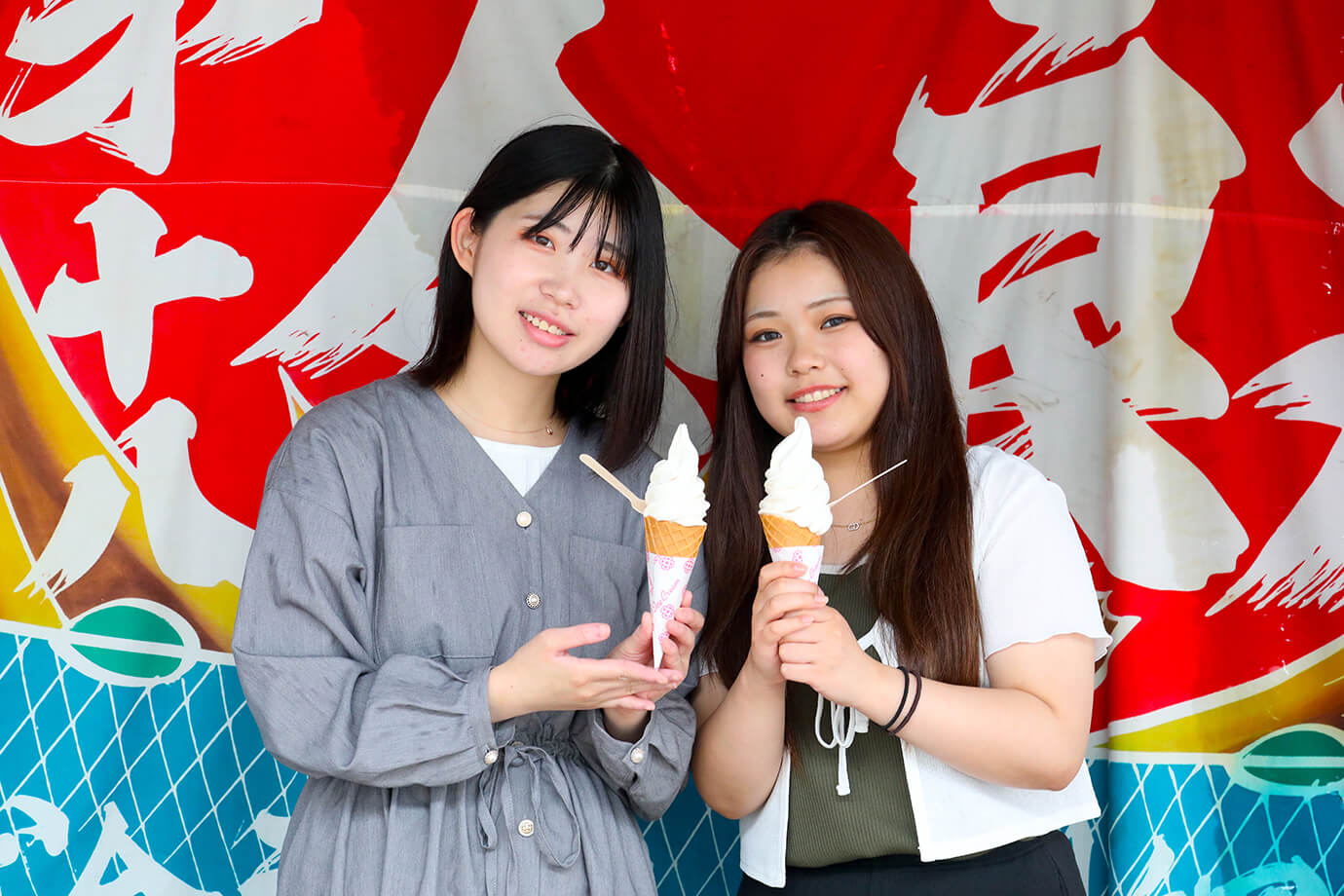
The cafeteria corner offers many different ramen dishes, including "Kamaishi ramen" for 550 yen. The menu displays information such as calories and salt content, and the fact that the restaurant is mindful of customers’ health, saying, "if you leave the soup, you can cut 2/3 of the salt content,” leaves a good impression. For 400 yen, “Kamaishi soy sauce soft ice cream” is made with Fujiyu Jyouzou Brewery soy sauce, and has a smooth texture and caramel-like taste.
Michi-no-Eki Kamaishi Sennin-Toge
Address:7-155-4 Kasshi-cho, Kamaishi City, Iwate Prefecture
Phone:0193-27-8530
Hours:9:00 to 18:00 (varies by facility)
Closed:December 31 and January 1
Kamaishi Products Center
Get products related to Kamaishi, the “town of iron, fish, and rugby!”
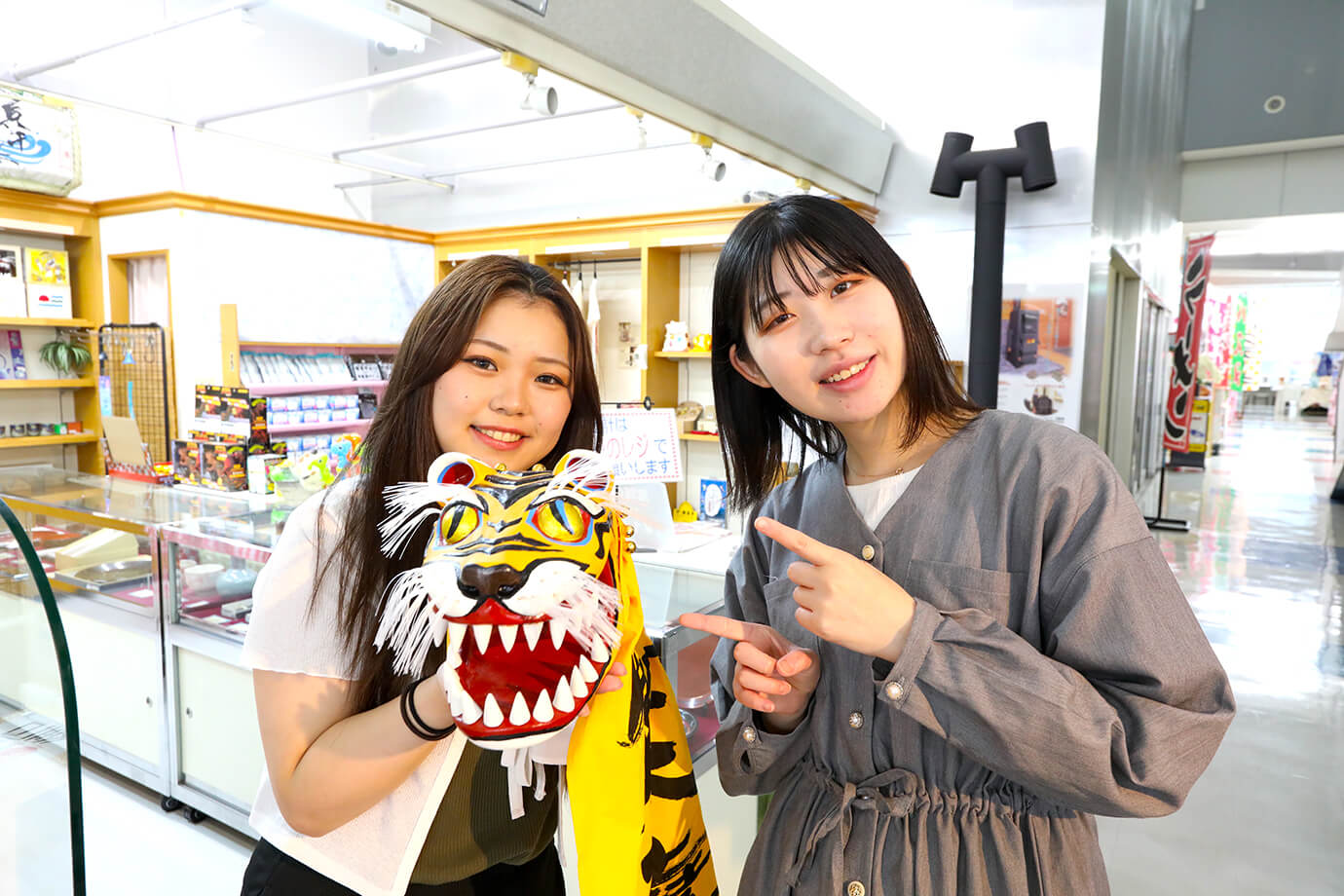
A wide variety of Kamaishi souvenirs are available at the “Kamaishi Local Products Store” on the first floor of the “Kamaishi Products Center (Sea Plaza Kamaishi)” adjacent to Kamaishi Station. In our hands is a tiger head from “Toramai (tiger dance),” a traditional performing art of Kamaishi City. It is said Toramai was performed to pray for the safety of fishermen and fire prevention, based on the idea that “a tiger runs 1,000 miles a day and returns 1,000 miles.”
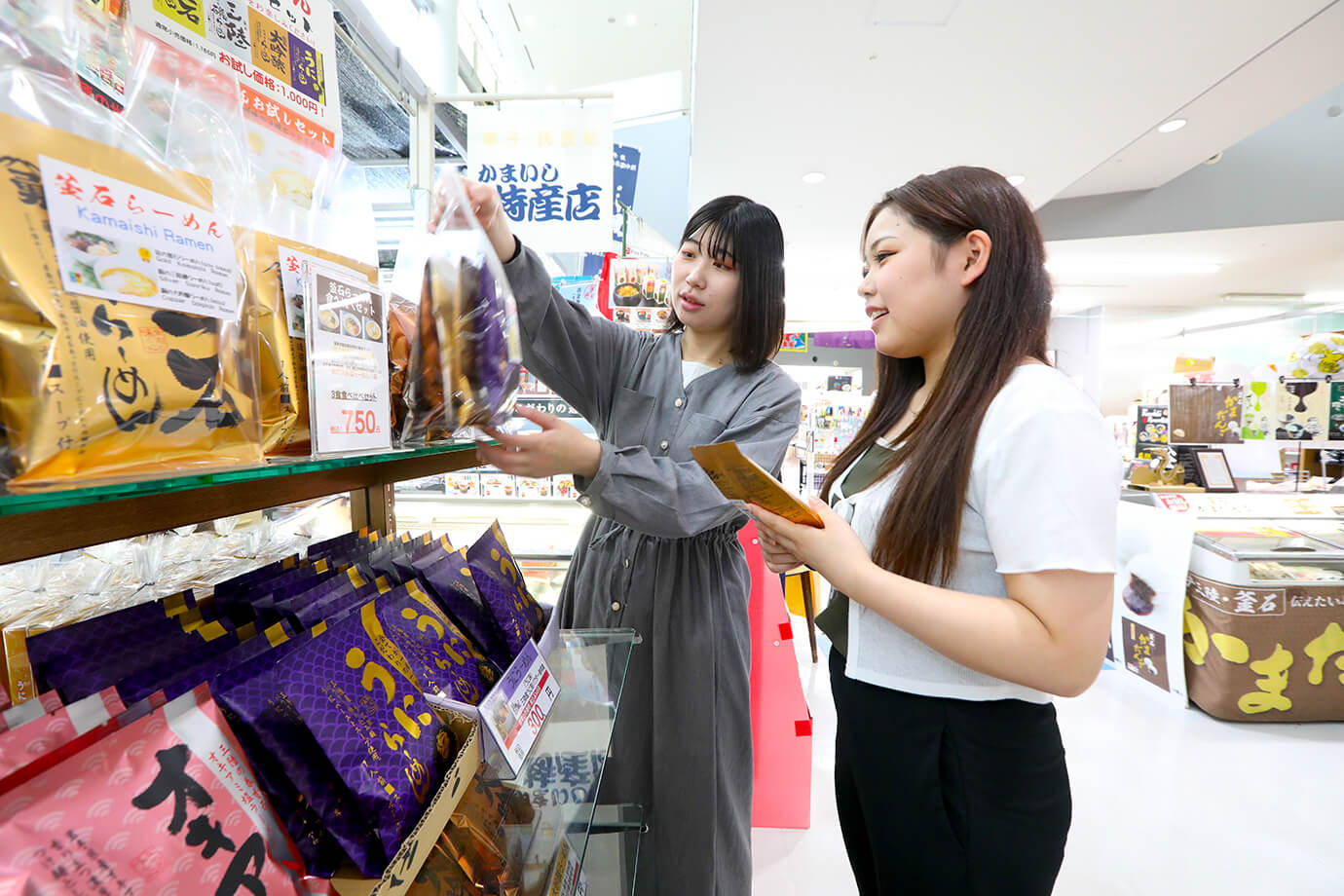
The "Kamaishi ramen tasting set" to enjoy at home is also attractive for bulk purchases.
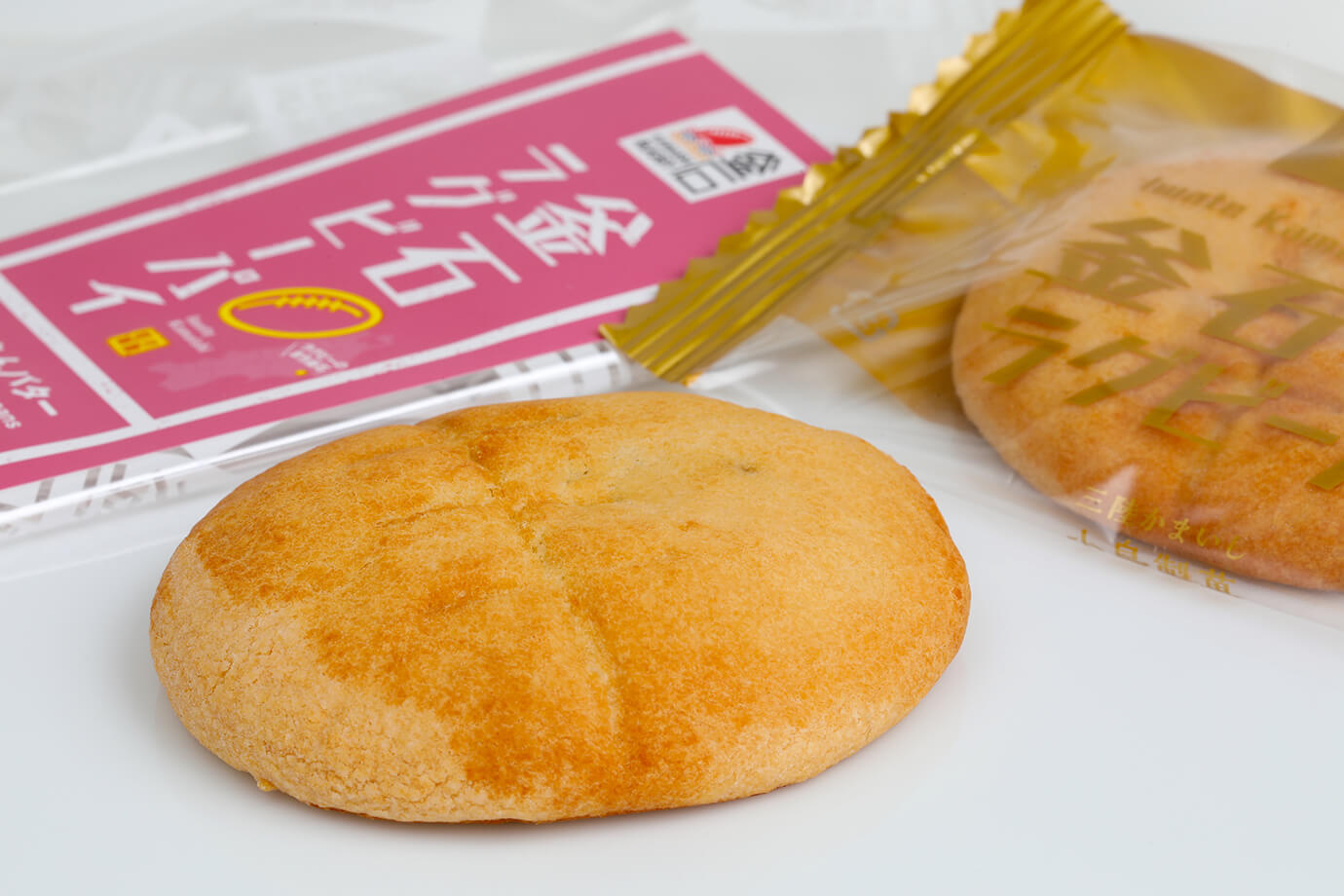
Kamaishi is home to the Nippon Steel Kamaishi Works Rugby Club, which was once known as the "iron man of the north" and won seven consecutive Japanese championships. Accordingly, we recommend a rugby-related souvenir. “Kamaishi Rugby Pie with Semi-crushed Red Beans & Butter” (five for 740 yen) is a homemade pie with a hint of Sanriku salt.
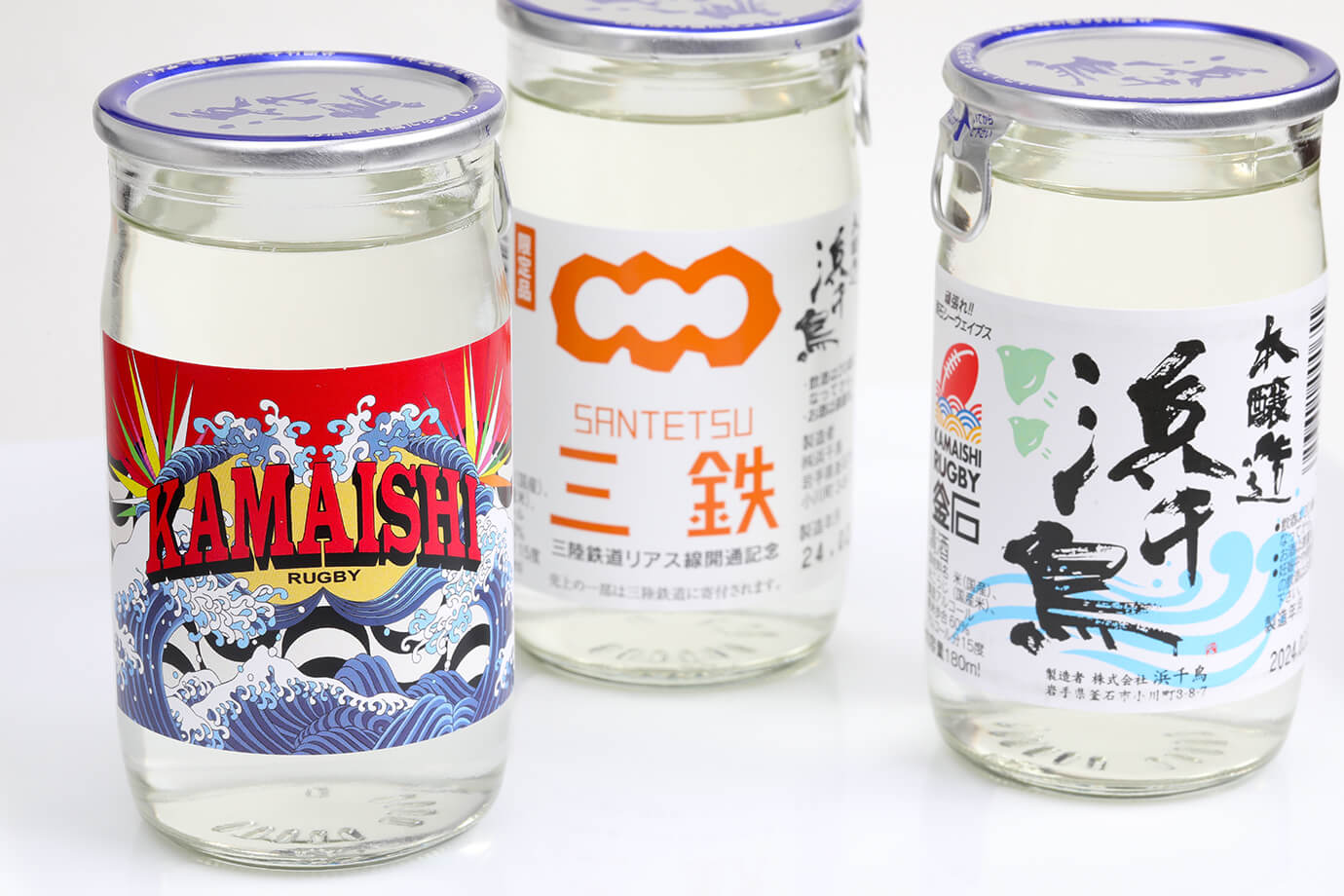
Hamachidori has been brewing sake in Kamaishi since its founding in 1923. The "Hamachidori Honjozo" three-bottle set (896 yen, equivalent to 264 yen per 180ml bottle) has impactful labels featuring Sanriku Railway and Kamaishi rugby.
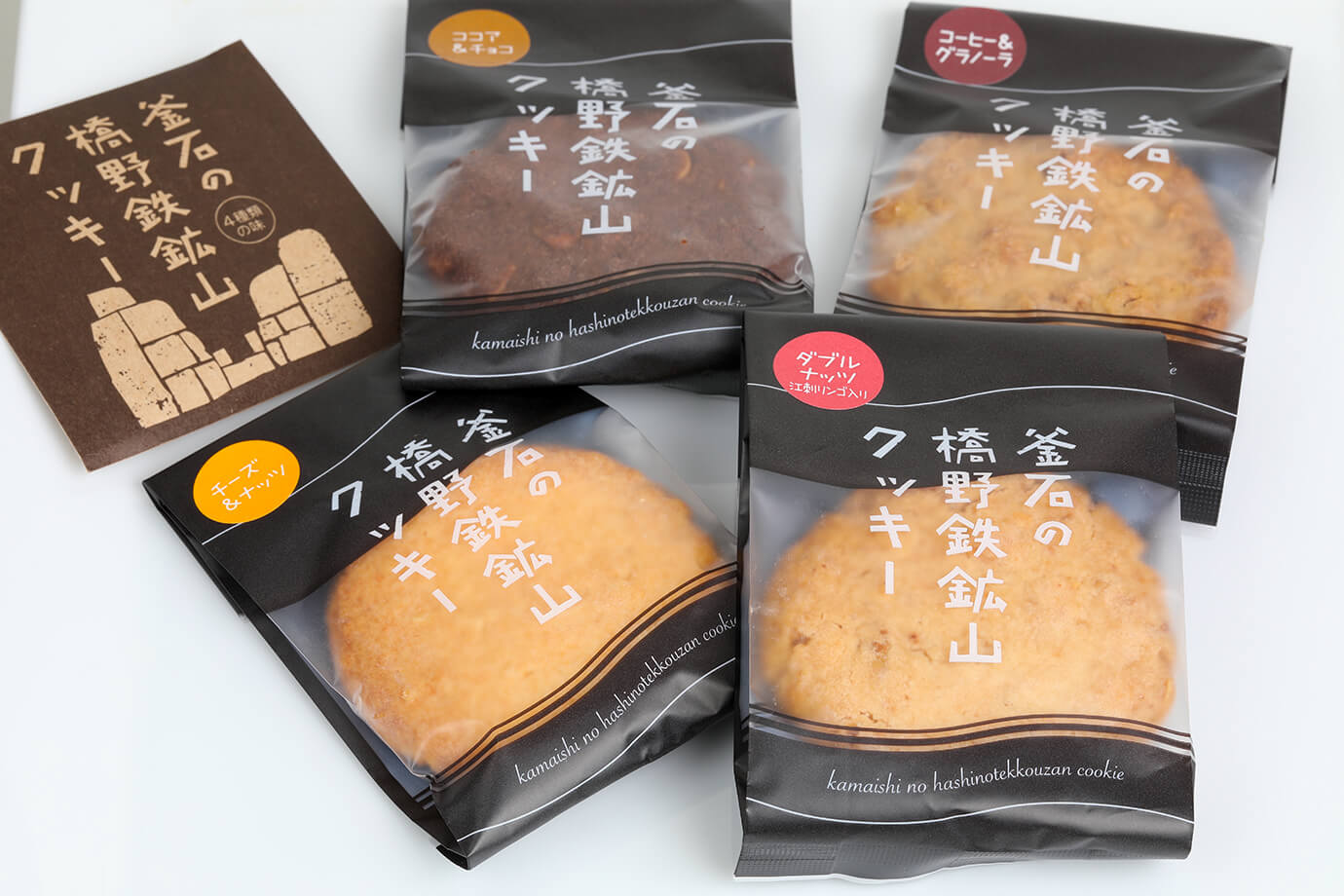
Kamaishi is also the "birthplace of modern iron manufacturing in Japan," where the continuous production of iron was successfully achieved. “Kamaishi no Hashinotekkosan Cookies” (600 yen for four), come in four varieties, including cocoa-chocolate and cheese & nuts.
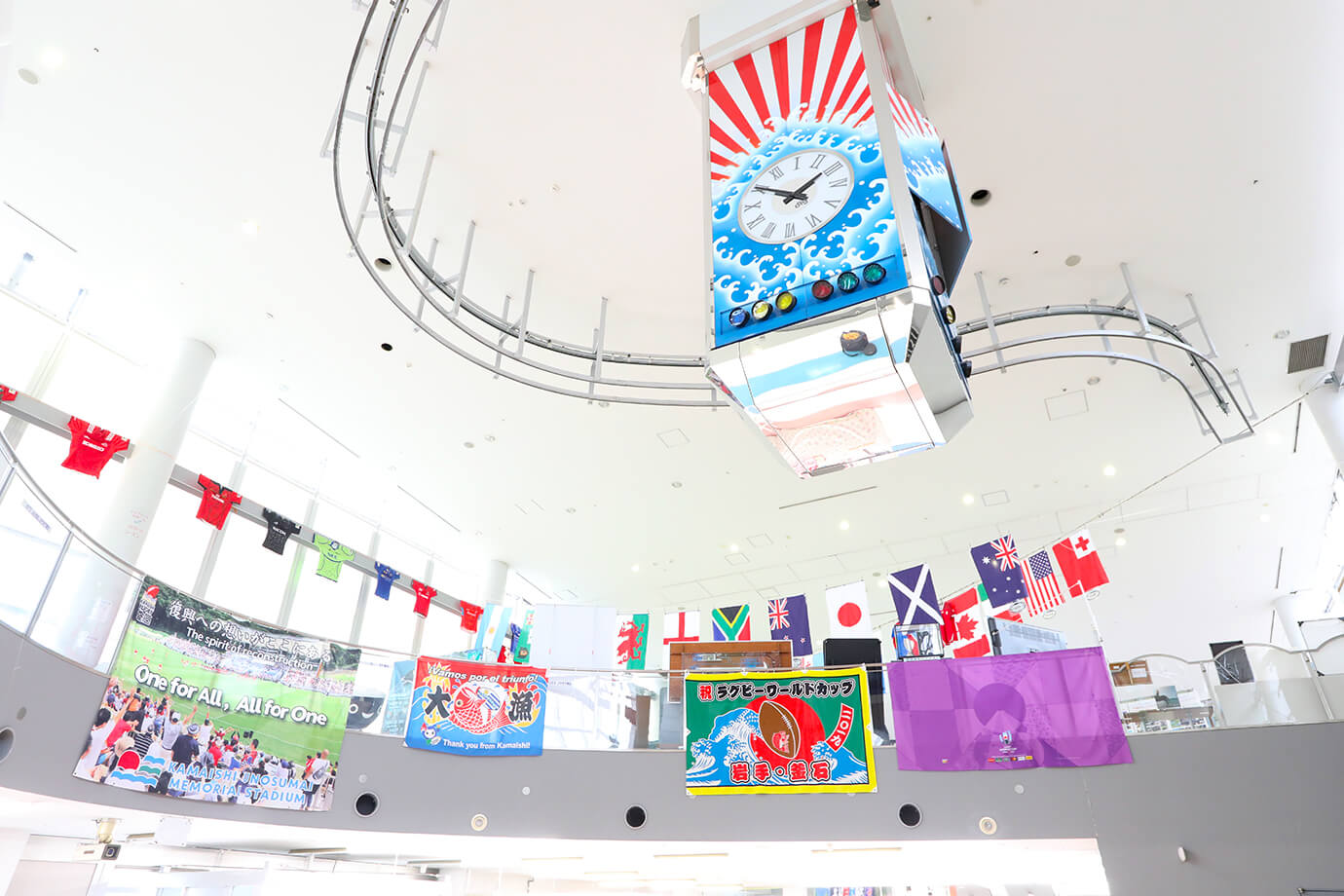
The Sea Plaza building houses the Kamaishi Tourist Information Center, a café, and stores, and the ceiling of the event space is decorated with large fishing flags and rugby-inspired decorations.
Taking a short trip to the Hashino Iron Mine, registered as a World Heritage site
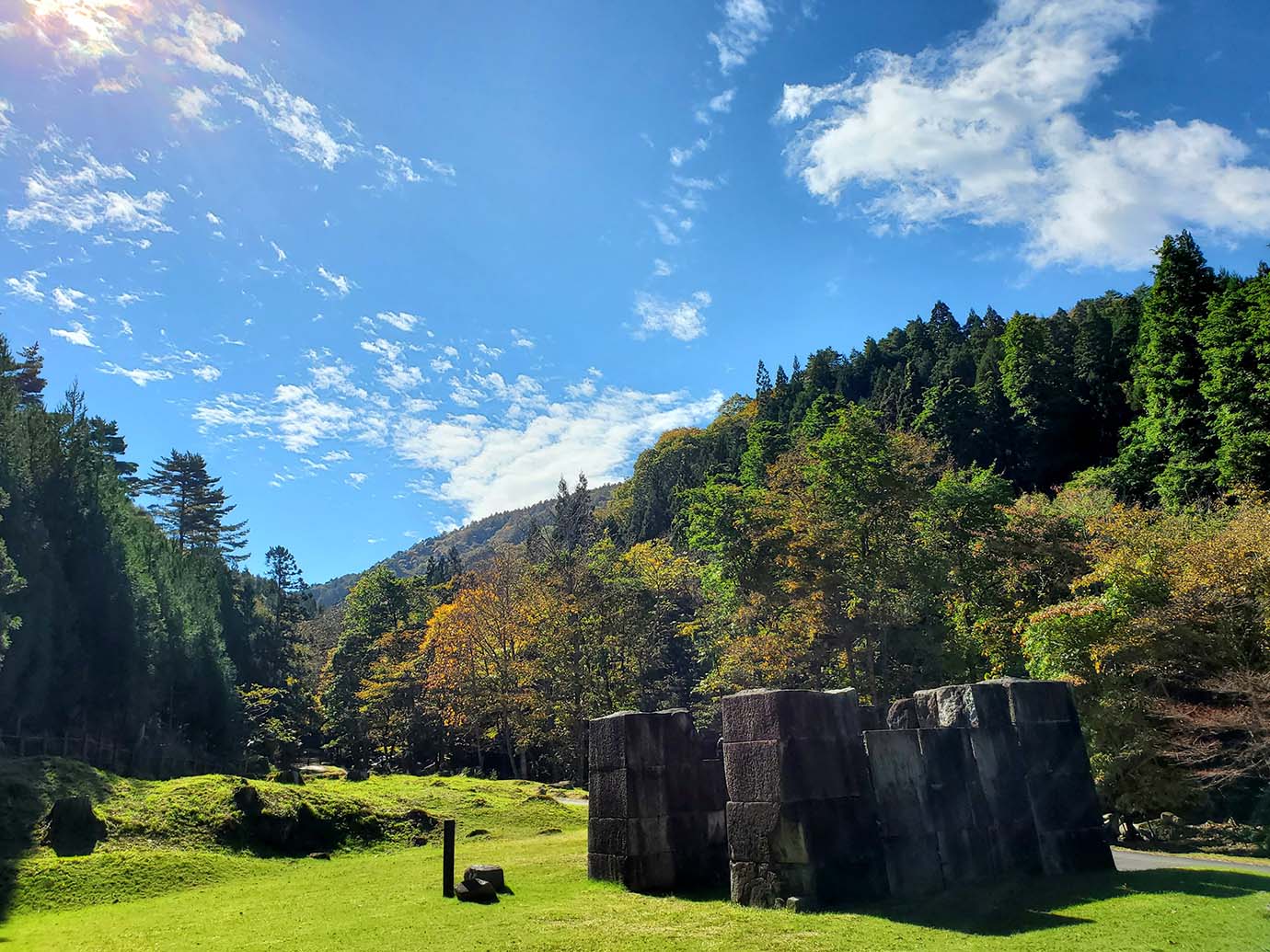
If you have more time, visit the Hashino Iron Mine, a 50-minute drive from Kamaishi Station. The "historic site of Hashino blast furnace" is the site of the oldest existing blast furnace in Japan, built by Takato Oshima of the Morioka Domain during the Ansei Era (late 1850s).
The blast furnace site, as well as the mining sites and delivery road sites to the south, are collectively called the "Hashino Iron Mine," and were registered as a World Heritage site in 2015, as assets that make up the “industrial revolutionary heritage of Meiji Japan: iron and steel making, shipbuilding, and coal industry.”
Kamaishi Products Center
Address:22-1 Suzuko-cho, Kamaishi City, Iwate Prefecture
Phone:0193-31-1177
Hours:From 9:00 to 19:00
Closed:First, third, and fifth Tuesday of the month, December 31 and January 1
Hashino Blast Furnace Site
Address:2-15 Hashino-cho, Kamaishi City, Iwate Prefecture
Tel:0193-27-7577 (Cultural Promotion Section, Culture and Sports Department, Kamaishi City)
Costs:Free
Hours:Any
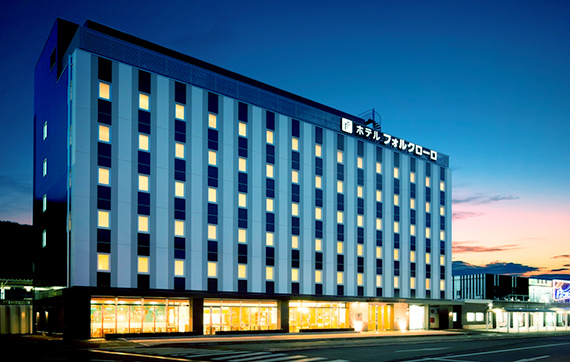
HOTEL FOLKLORO SANRIKUKAMAISHI
Equipped with outdoor baths offering panoramic views and artificial hot springs, this hotel is a perfect base for sightseeing in the Sanriku region.
NotesOpenClose
*Information provided on this website is current as of July 2024. The featured facilities may change their fees, hours, days closed, menus, and other information after it has been published here, or they may be temporarily closed. Although every effort has been made to ensure the accuracy of the content on this website, including all times, fees, etc., we recommend that you contact the facility by phone or other means to get further information or make a reservation in advance. We will not be held liable for any damage in connection with the content of this website.
*All charges and fees shown on this website include consumption tax and were current at the time the information about them was collected. Facilities that offer dine-in and/or takeout services are so noted in the articles. Charges and fees are subject to change.
*Facility schedules do not reflect closures during the year-end/New Year holidays, Bon festival, and Golden Week as well as temporary closures unless specified by the respective facilities featured on this website.
*Operating hours shown on this website are generally the hours from opening to closing unless otherwise specifically noted. Last orders and entries are usually accepted 30 minutes to 1 hour before closing.
SHARE
